THE COLLECTION MAGAZINE
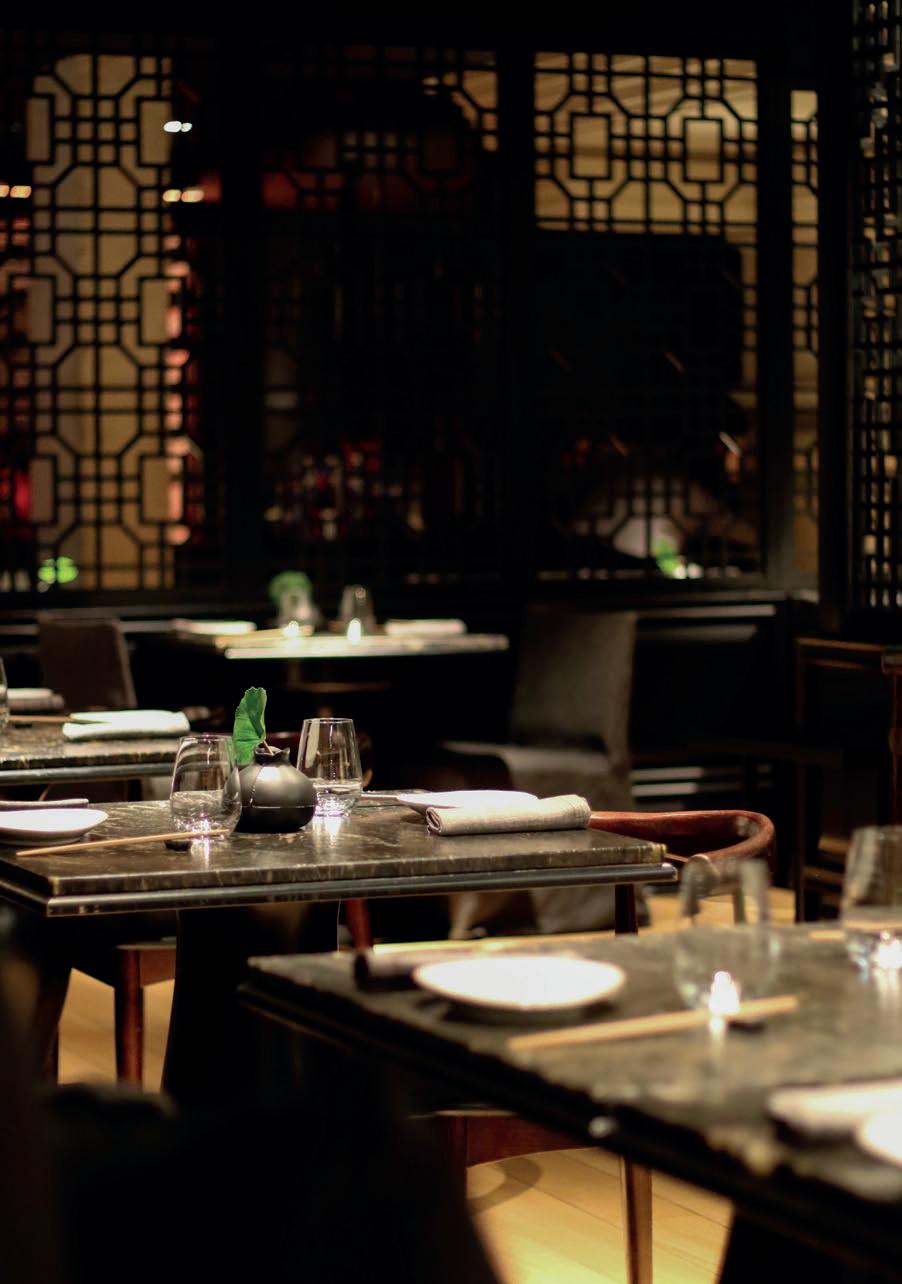
THE COLLECTION MAGAZINE Nº 26 | 2023

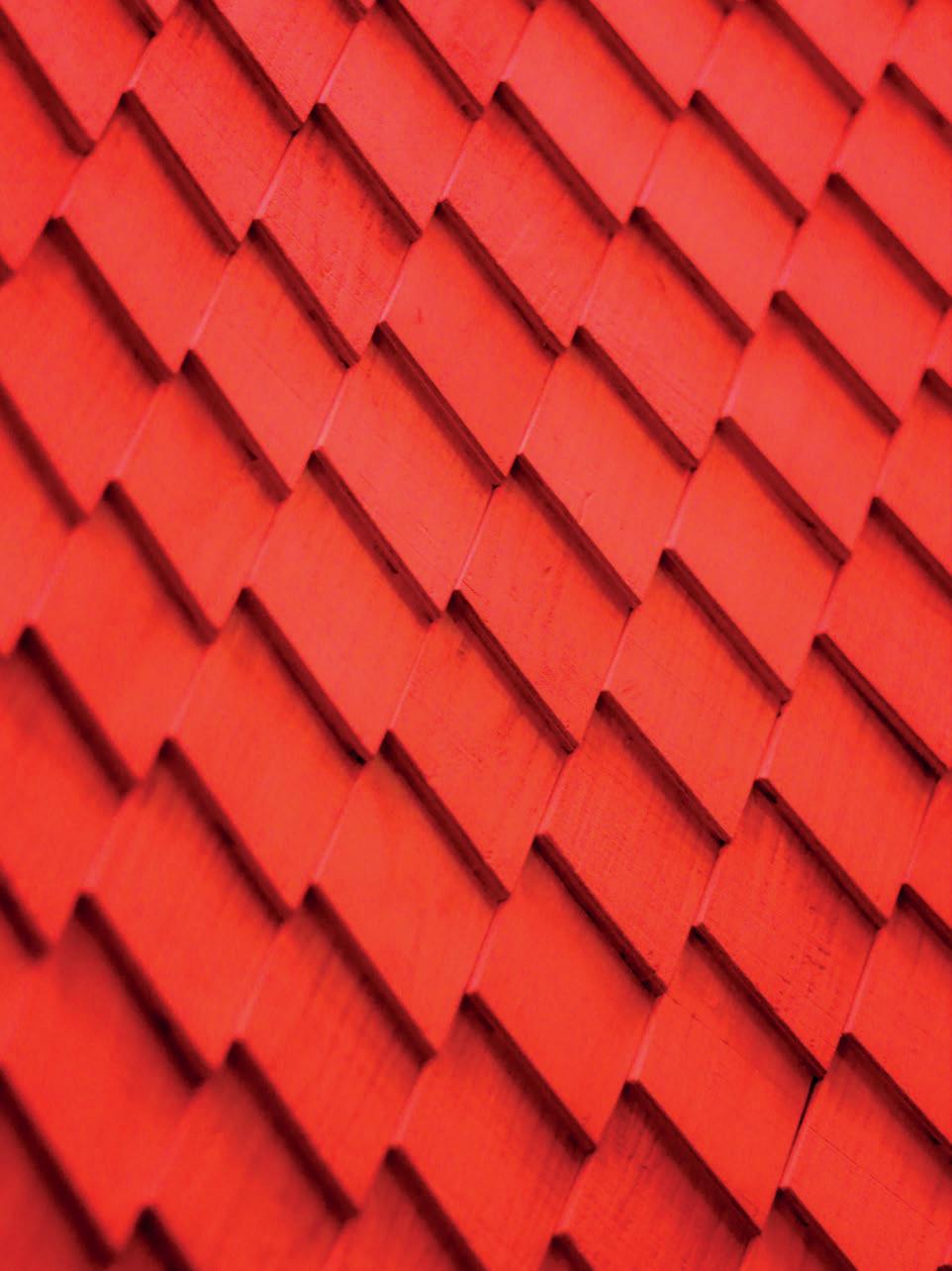
















Derby Hotels Collection Valencia, 284. 08007 Barcelona Tel. +34 934 452 500 | Fax +34 933 668 811 www.derbyhotels.com Producción: Revista de Derby Hotels Collection Nº 26, año 2023 8 RESTAURANTE CEBO 60 EL CHILLOUT SE INSTALA EN CASA 40 BARCELONA 66 UN DETALLE QUE LO CAMBIA TODO 56 PARIS 44 MADRID 34 OS-KURO 64 SE LLEVA LO NATURAL 50 LONDRES 30 GLASS BY SIPS 62 EL DEPORTE QUE TE CAMBIARÁ LA MENTE 72 MONGOLIA 76 ISLANDIA 68 NIKOLA TESLA 16 MEET EGYPT 22 200 AÑOS DESCIFRANDO
Jordi Clos , Presidente de Derby Hotels
La pieza identificada con el número 1 en el Museo Egipcio de Barcelona es un pequeño usebti que, a primera vista, carece de la importancia artística que justificaría este honor. Sin embargo, sentimentalmente es una pieza fundamental, porque es la primera que compré con 19 años y muchos sueños, y que se convirtió con el paso del tiempo en la base de la colección cuya creación ha marcado la historia de nuestra familia.

El arte mejora nuestra vida porque la llena de belleza, y tengo la convicción de que la belleza, para serlo verdaderamente, debe compartirse. En nuestros hoteles, que son una extensión de nuestra casa, las obras que hemos ido adquiriendo se ponen a disposición de nuestros huéspedes, que no clientes. Creemos que la contemplación del arte desde muy cerca aporta un lujo a la estancia que no puede evaluarse, pero está ahí. El arte calma y aporta una felicidad que aun pudiendo expresarse con palabras, no podemos dejar de sentir.
Muchas veces me han preguntado si no me daba miedo dejar obras, a veces de enorme valor económico, en las habitaciones de nuestros hoteles. Pero la experiencia me ha demostrado que no se corre ningún riesgo. Confiamos en ustedes, que nos devuelven esta confianza dando a las obras un trato respetuoso y esa pátina añadida de admiración que les hace aún mejores.
Así que, entre mosaicos romanos, colecciones de arte africano, precolombino y de Nueva Guinea Papúa, tanagras griegas e incluso la colección del pintor Ricard Opisso, les ofrecemos lo que nuestra familia tiene de mejor. Nuestra pasión por el arte, nuestras ganas de recibirles de la manera más perfecta y cálida, y la ilusión de que encuentren en nuestros hoteles su casa lejos de casa.
Bienvenidos a Derby Hotels, estamos encantados de recibirles!
The piece identified with the number 1 in the Egyptian Museum of Barcelona is a small usebti that, at first sight, lacks the artistic importance that would justify this honour. However, sentimentally it is a fundamental piece, because it is the first one I bought when I was 19 years old and had many dreams, and over time it became the basis of the collection the creation of which has marked the history of our family.
Art enhances our lives because it fills them with beauty, and it is my conviction that beauty, to be truly beautiful, must be shared. In our hotels, which are an extension of our home, the works we have acquired are made available to our guests, not clients. We believe that the contemplation of art from up close brings a luxury to the stay that cannot be evaluated, but it is there. Art calms and brings a happiness that even if it can be expressed in words, we cannot help but feel.
I have often been asked if I was not afraid to leave works of art, sometimes of enormous economic value, in our hotel rooms. But experience has shown me that there is no risk at all. We trust you, who repay this trust by treating the works with respect and giving them that added patina of admiration that makes them even better.
So, between Roman mosaics, collections of African, pre-Columbian and Papuan New Guinea art, Greek tanagras and even the collection of the painter Ricard Opisso, we offer you the best of what our family has to offer. Our passion for art, our desire to welcome you in the most perfect and warmest way, and the hope that you will find in our hotels your home away from home.
Welcome to Derby Hotels, we are delighted to welcome you!
4
EL PEQUEÑO USEBTI
Joaquim Clos , Director General de Derby Hotels
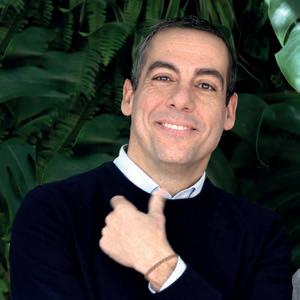 DE DERBY
DE DERBY
Con el 2023 recién empezado, los nuevos proyectos de Derby empiezan a dibujarse, en un año en el que vislumbramos una tendencia en el sector del turismo y ocio claramente al alza…
Empezando por el apartado gastronómico, estamos viendo la consolidación del nuevo CEBO, con la cocina de Javier Sanz y Juan Sahuquillo (Estrella Michelin en Oba) conquistando Madrid en el Hotel Urban. Una cocina de Producto y Esencia, profunda y llena de matices, que ahonda en los sabores, reivindicando la sencillez y lo elemental, para la memoria y el recuerdo.
Solamente cruzando el vestíbulo del hotel, la reciente apertura de Glass by Sips marca nuestro retorno a la coctelería más innovadora y auténtica de la experta mano de Marc Álvarez y Simone Caporale y su concepto premiado como Tercer Mejor Bar del Mundo en Barcelona, y con quiénes confiamos obtener resultados igualmente magníficos en Madrid.
No se queda atrás Barcelona, dónde Os-kuro Sushi Bar & Robata empieza su andadura con una oferta de cocina japonesa tradicional, servida por un equipo de profesionales que aman y respetan la cultura nipona y que estoy seguro se convertirá en un lugar de referencia.
También en este 2023 ponemos en marcha otros tres grandes proyectos de futuro, como son la renovación con una reforma total del Caesar Hotel en Londres; la apertura de un nuevo edificio de apartamentos turísticos en Barcelona, el Europa Barcelona Apartment (concretamente, en Hospitalet de Llobregat, frente a la Fira) y la mejora del Hotel Villa Real en Madrid, al que dotaremos de piscina y una terraza panorámica en la azotea con magníficas vistas al Barrio de las Letras.
Unos proyectos en los que esperamos que nos acompañen, los disfruten y los sientan como propios, porque sin ustedes, nuestros amigos y clientes, ninguno de ellos tendría sentido.
With 2023 just begun, Derby’s new projects are starting to take shape, in a year in which we can see a clear upward trend in the tourism and leisure sector......
Starting with the gastronomic section, we are seeing the consolidation of the new CEBO, with the cuisine of Javier Sanz and Juan Sahuquillo (Michelin Star at Oba) conquering Madrid at the Hotel Urban. A cuisine of Product and Essence, deep and full of nuances, which delves into the flavours, claiming simplicity and the elemental, for memory and remembrance.
Just across the hotel lobby, the recent opening of Glass by Sips marks our return to the most innovative and authentic cocktails from the expert hands of Marc Álvarez and Simone Caporale and their concept, awarded as the Third Best Bar in the World in Barcelona, and with whom we hope to obtain equally magnificent results in Madrid.
Barcelona is not far behind, where Os-kuro Sushi Bar & Robata is starting its journey with an offer of traditional Japanese cuisine, served by a team of professionals who love and respect Japanese culture and which I am sure will become a place of reference.
Also in 2023 we are launching three other major projects for the future, such as the renovation with a total refurbishment of the Caesar Hotel in London; the opening of a new tourist apartment building in Barcelona, the Europa Barcelona Apartment (specifically, in Hospitalet de Llobregat, opposite the Fira) and the improvement of the Hotel Villa Real in Madrid, which we will equip with a swimming pool and a panoramic rooftop terrace with magnificent views of the Barrio de las Letras.
We hope that you will join us in these projects, enjoy them and feel them as your own, because without you, our friends and customers, none of them would make sense.
5
NUEVOS PROYECTOS
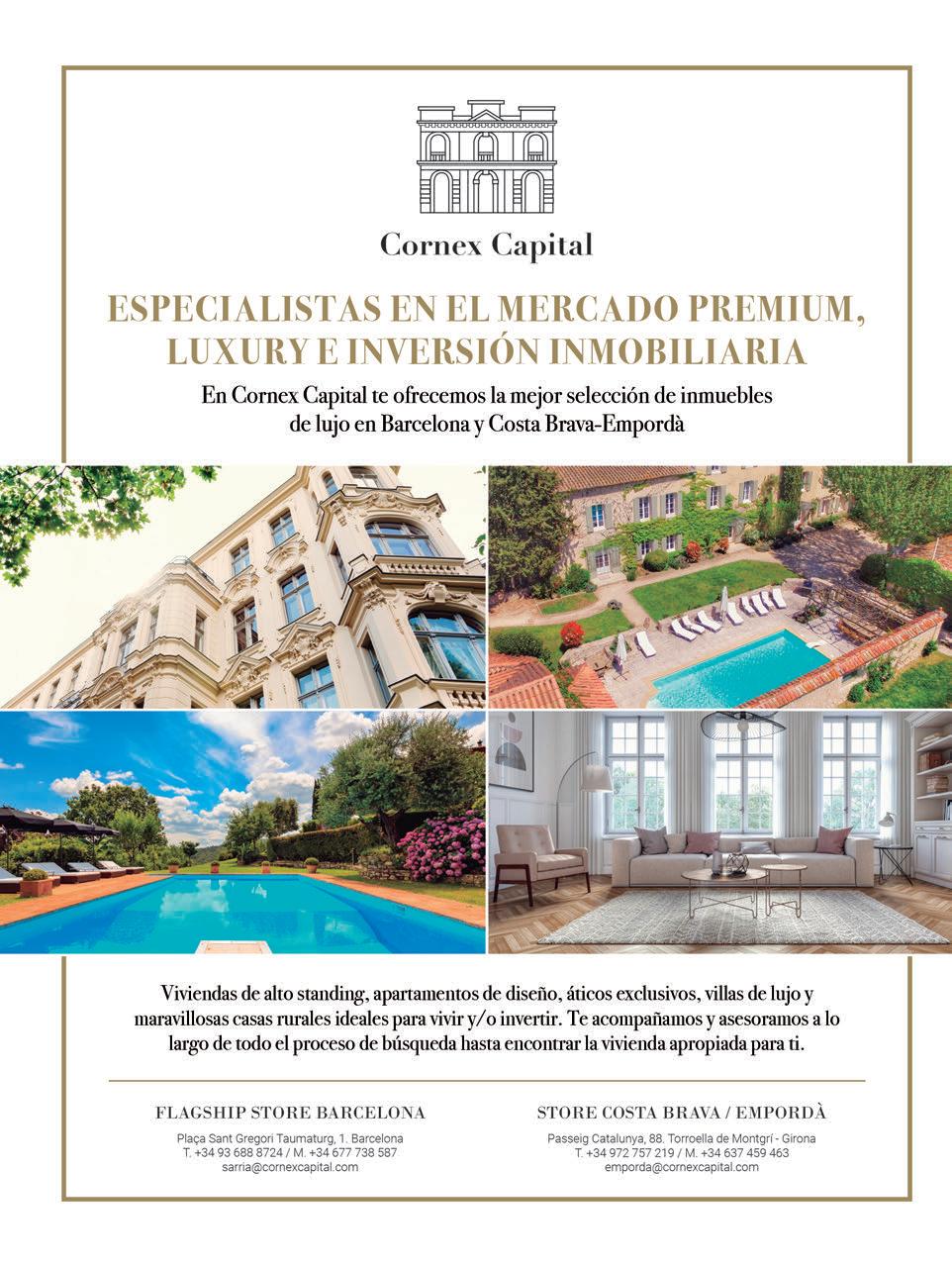
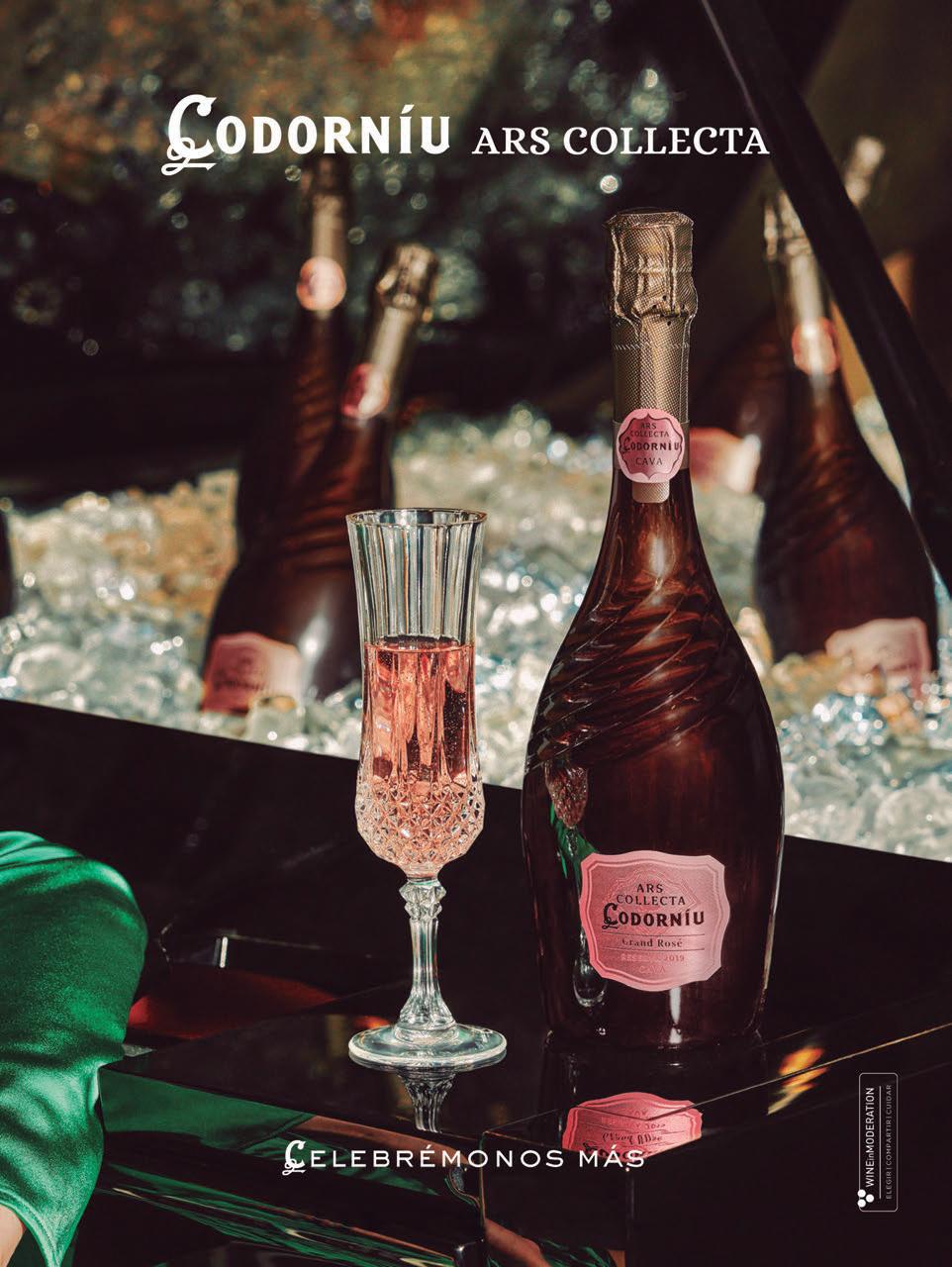
RESTAURANTE RESTAURANT

EL HOTEL URBAN 5 GL DE MADRID INAUGURA NUEVA
ETAPA DEL RESTAURANTE CEBO
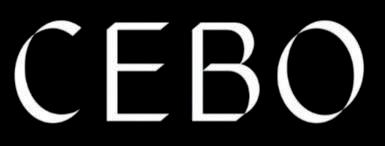
El Hotel Urban 5*GL de Derby Hotels Collection reabrió el restaurante CEBO bajo la dirección de los jóvenes Javier Sanz y Juan Sahuquillo, cocineros Revelación Madrid Fusión 2021
THE HOTEL URBAN 5*GL IN MADRID INAUGURATES A NEW PHASE OF THE RESTAURANT CEBO
The Hotel Urban 5*GL of Derby Hotels Collection reopened the restaurant CEBO under the direction of the young Javier Sanz and Juan Sahuquillo, chefs Revelation Madrid Fusion 2021.
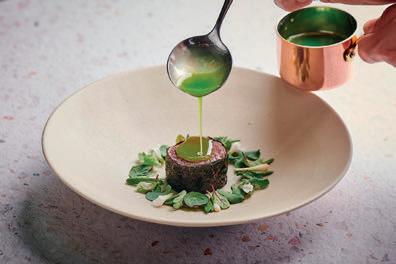
Producto, Esencia y Sencillez definen la propuesta gastronómica creada por los jóvenes albaceteños del Grupo Cañitas Maite para la nueva etapa de CEBO, que retoma su andadura con el objetivo de consolidarse como destino culinario imprescindible en Madrid.
En palabras de Joaquim Clos, director general de Derby Hotels Collection, “este acuerdo es la unión de dos empresas familiares, unidas por valores afines, que nace como proyecto a largo plazo. Tras siete años de éxito con nuestro restaurante CEBO y la obtención de la estrella Michelin, afrontamos el camino juntos como una gran oportunidad de crecimiento y transformación para seguir posicionándonos como hotel gastronómico de referencia”.
“Mantenemos el nombre de CEBO -continúa- porque pertenece a la identidad corporativa del Hotel Urban 5* GL desde que apostamos por la alta cocina. Ahora
Product, Essence and Simplicity define the gastronomic proposal created by the young chefs from Albacete of the Cañitas Maite Group for the new stage of CEBO, which resumes its journey with the aim of consolidating itself as an essential culinary destination in Madrid.
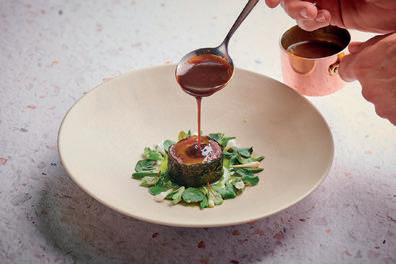
In the words of Joaquim Clos, CEO of Derby Hotels Collection, “this agreement is the union of two family businesses, united by similar values, which is born as a long-term project. After seven years of success with our restaurant CEBO and obtaining the Michelin star, we face the road together as a great opportunity for growth and transformation to continue positioning ourselves as a gastronomic hotel of reference.”
“We keep the name CEBO -he continues- because it belongs to the corporate identity of the Hotel Urban 5* GL since we bet on haute cuisine. Now we per -
9
lo personalizamos con los nombres de los dos chefs que lideran el proyecto, Javier Sanz y Juan Sahuquillo.
“La responsabilidad del equipo abanderado por Javier Sanz y Juan Sahuquillo empieza en Cebo y, poco a poco, participarán en el asesoramiento del resto de áreas, apoyando al equipo actual para mejorar e implementar la oferta de eventos, terraza... El objetivo es fortalecer y crecer. Sumar” afirma Joaquim Clos.
Javier Sanz declara: “Asumimos el reto de venir a Madrid con máximo respeto y humildad, vértigo e ilusión. La oferta es apabullante y los profesionales no pueden ser mejores. Nos enfrentamos a un público exigente y acostumbrado a un nivel excepcional. Intentaremos aportar nuestro granito de arena en un escenario inmejorable como es el Hotel Urban”.
“Siempre soñamos tener lugar en la capital que proyectara lo que se hace en casa cada día -añade-. El magnífico equipo que nos acompaña nos ha animado a dar este paso. Borja García, jefe de cocina, será el responsable de transmitir la filosofía de Cañitas Maite, con sus valores de producto y sencillez, en Madrid. Juan o yo viajaremos semanalmente. Contamos con perso-
sonalize it with the names of the two chefs leading the project, Javier Sanz and Juan Sahuquillo.
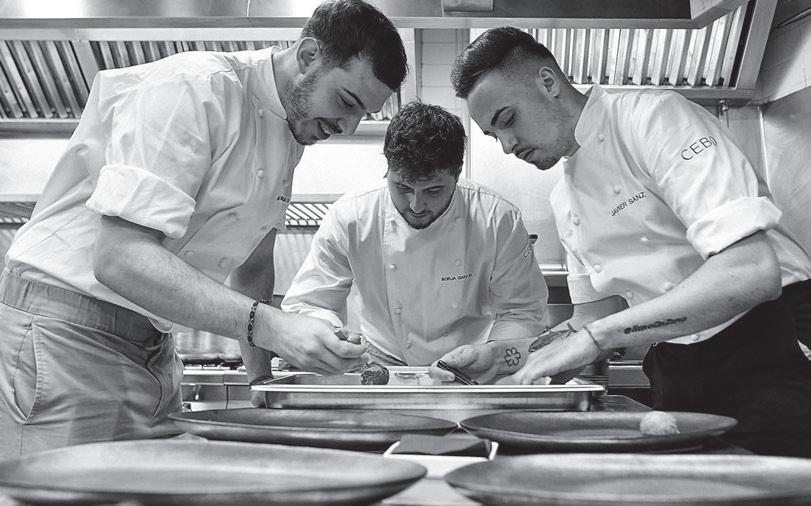
“The responsibility of the team led by Javier Sanz and Juan Sahuquillo starts in Cebo and, little by little, they will participate in advising the rest of the areas, supporting the current team to improve and implement the offer of events, terrace.... The objective is to strengthen and grow. To add up”, says Joaquim Clos.
Javier Sanz declares: “We assume the challenge of coming to Madrid with the utmost respect and humility, vertigo and illusion. The offer is overwhelming and the professionals cannot be better. We are facing a demanding public accustomed to an exceptional level. We will try to do our bit in an unbeatable setting such as the Hotel Urban”.
We always dreamed of having a place in the capital that would project what is done at home every day,” he adds. The magnificent team that accompanies us has encouraged us to take this step. Borja García, head chef, will be responsible for transmit -
10
Javier Sanz y Juan Sahuquillo
galardonados con una Estrella Michelin y la Estrella Verde Michelin a la Sostenibilidad en su restaurante Oba awarded with a Michelin Star and the Michelin Green Star for Sustainability in their restaurant Oba
nal para adquirir este compromiso y, paralelamente, mantener en Casas Ibáñez la casa madre Cañitas Maite y el espacio OBA- vinculado al entorno autóctono “.
“El concepto creado para Cebo se inspira en una cocina desnuda de artificios y que se expresa con los mejores productos del momento. Una cocina profunda y llena de matices, que ahonda en los sabores, reivindicando la sencillez y lo elemental. Cocina para la memoria y el recuerdo. “Cebo es la evolución de Cañitas Maite en un formato de alta cocina con protagonismo de la sala. 22 comensales permiten ofrecer un servicio cuidado y personalizado”, indica Sahuquillo.
Esta nueva etapa del restaurante CEBO en el Hotel Urban, presenta un menú degustación de 14 pasos y la versión corta, de 11, compuesto por elaboraciones exclusivas para Cebo, basadas en la excelencia de las materias primas, a partir de pocos ingredientes y las técnicas precisas para preservar el sabor, la textura y la naturaleza de cada producto.
Una oferta, cuyos ejes son el producto y la parrilla, como el Tomate Cuerno de Andes, Cigala de la Ría, Carabinero madurado, Calamar de Anzuelo, Vaca
ting the philosophy of Cañitas Maite, with its values of product and simplicity, in Madrid. Juan or I will travel weekly. We have the personnel to make this commitment and, at the same time, maintain the Cañitas Maite motherhouse and the OBA space in Casas Ibáñez, linked to the local environment.
“The concept created for Cebo is inspired by a cuisine stripped of artifice and expressed with the best products of the moment. A deep and nuanced cuisine, which delves into the flavors, claiming the simplicity and the elemental. A cuisine for memory and remembrance. “Cebo is the evolution of Cañitas Maite in a format of haute cuisine with a leading role for the dining room. 22 diners allow us to offer a careful and personalized service,” says Sahuquillo.
This new stage of the CEBO restaurant at the Hotel Urban, presents a 14-step tasting menu and a short version of 11 steps, composed of exclusive elaborations for Cebo, based on the excellence of the raw materials, from few ingredients and the precise techniques to preserve the flavor, texture and nature of each product.
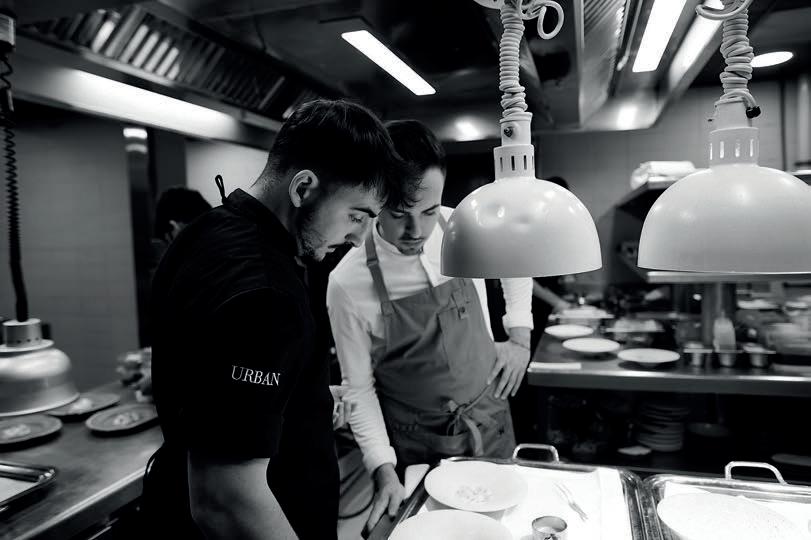
11
de Trabajo, Codorniz Ortolans y Caviar Ahumado, entre otros platos. No faltará, eso sí, la croqueta de jamón, ganadora de la Mejor Croqueta del Mundo 2021 en Madrid Fusión.

La bodega de Cebo sigue atesorando una gran variedad de referencias nacionales e internacionales, y se ofrecerá la opción de armonizar cada menú.
Con esta nueva etapa en CEBO el Hotel Urban, aspira a convertirse en referente de la capital. Además, el hotel completará la estrategia renovando su actual oferta gastronómica y de ocio en todas las áreas.
Ficha Técnica Cebo:
Chef: Javier Sanz y Juan Sahuquillo
Jefe de Cocina: Borja García
Jefe de Sala: Yassine Khazzari Charif
Sommelier: Marisa De Sande
Capacidad: 22 comensales por servicio
Horarios de cocina: De martes a sábado. Mediodías de 13.15h a 15h, noches de 20.30h a 21.30h Domingo y Lunes cerrado.

Hotel Urban 5*GL. Carrera de San Jerónimo, 34 28034 Madrid. cebo@derbyhotels.com +34. 91 787 77 80 cebomadrid.com
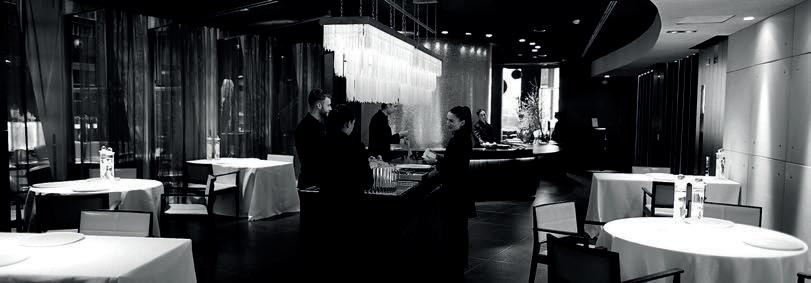
12
An offer, whose axes are the product and the grill, such as the Andes Horn Tomato, Crayfish of the Ria, matured Carabinero, Squid of Anzuelo, Cow of Work, Quail Ortolans and Smoked Caviar, among other dishes. Of course, the ham croquette, winner of the Best Croquette of the World 2021 at Madrid Fusion, will not be missing.
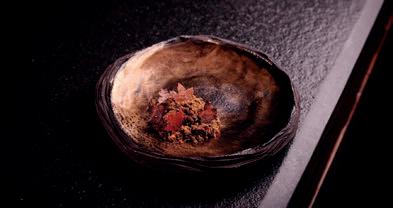
Cebo’s wine cellar continues to treasure a wide variety of national and international references, and the option of harmonizing each menu will be offered.
With this new stage in CEBO, Hotel Urban aspires to become a benchmark in the capital. In addition, the hotel will complete the strategy by renewing its current gastronomic and leisure offer in all areas.
Cebo Technical Details:
Chef: Javier Sanz y Juan Sahuquillo
Chef: Borja García
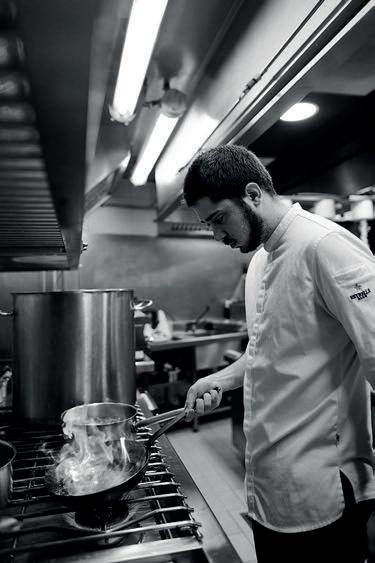
Head Waiter: Yassine Khazzari Charif
Sommelier: Marisa De Sande

Capacity: 22 guests per service
Kitchen hours:
Tuesday to Saturday. Noon from 13.15h to 15h, evenings from 20.30h to 21.30h. Sunday and Monday closed.
Hotel Urban 5*GL. Carrera de San Jerónimo, 34 28034 Madrid.
cebo@derbyhotels.com +34. 91 787 77 80 cebomadrid.com
13
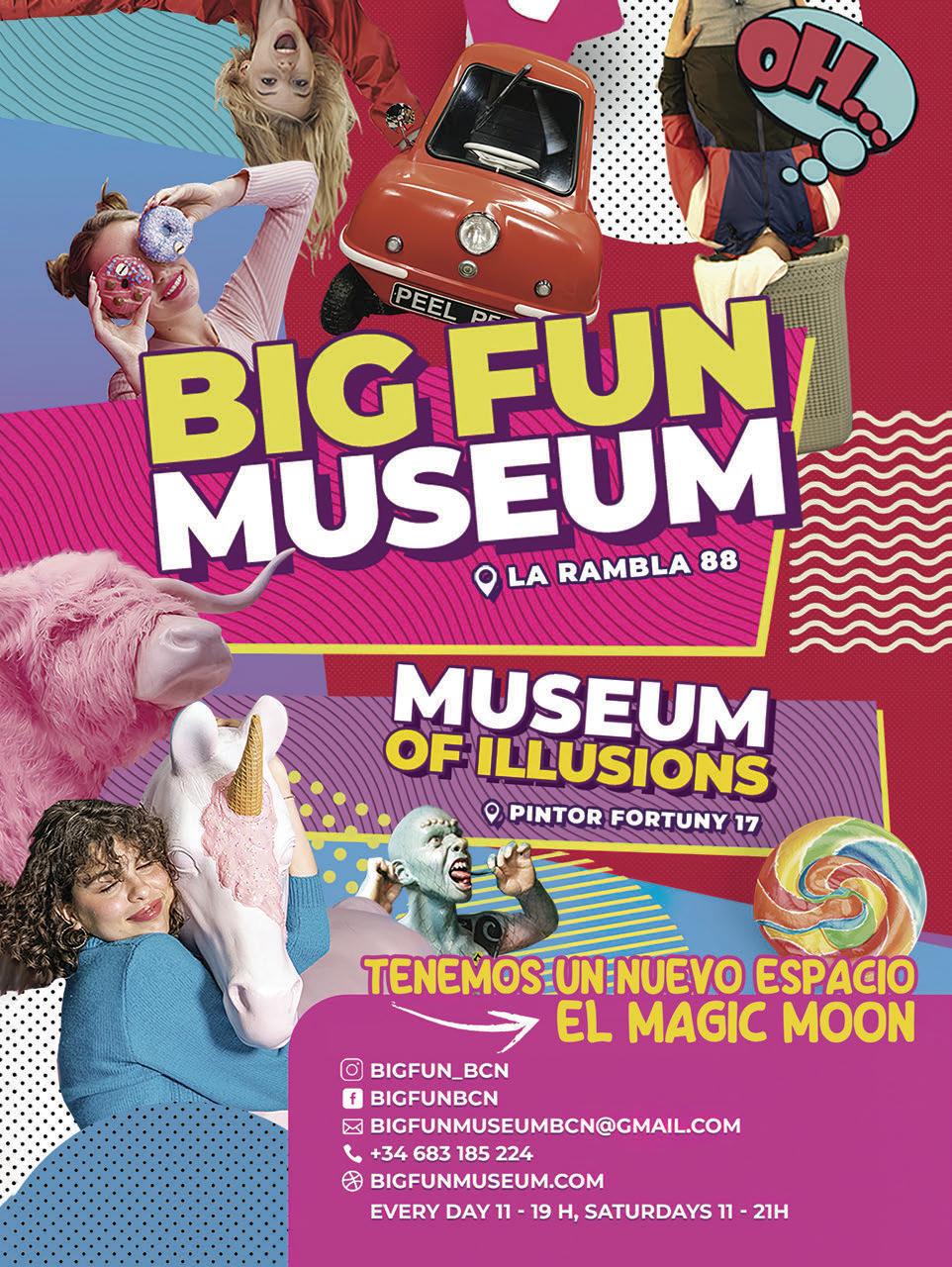
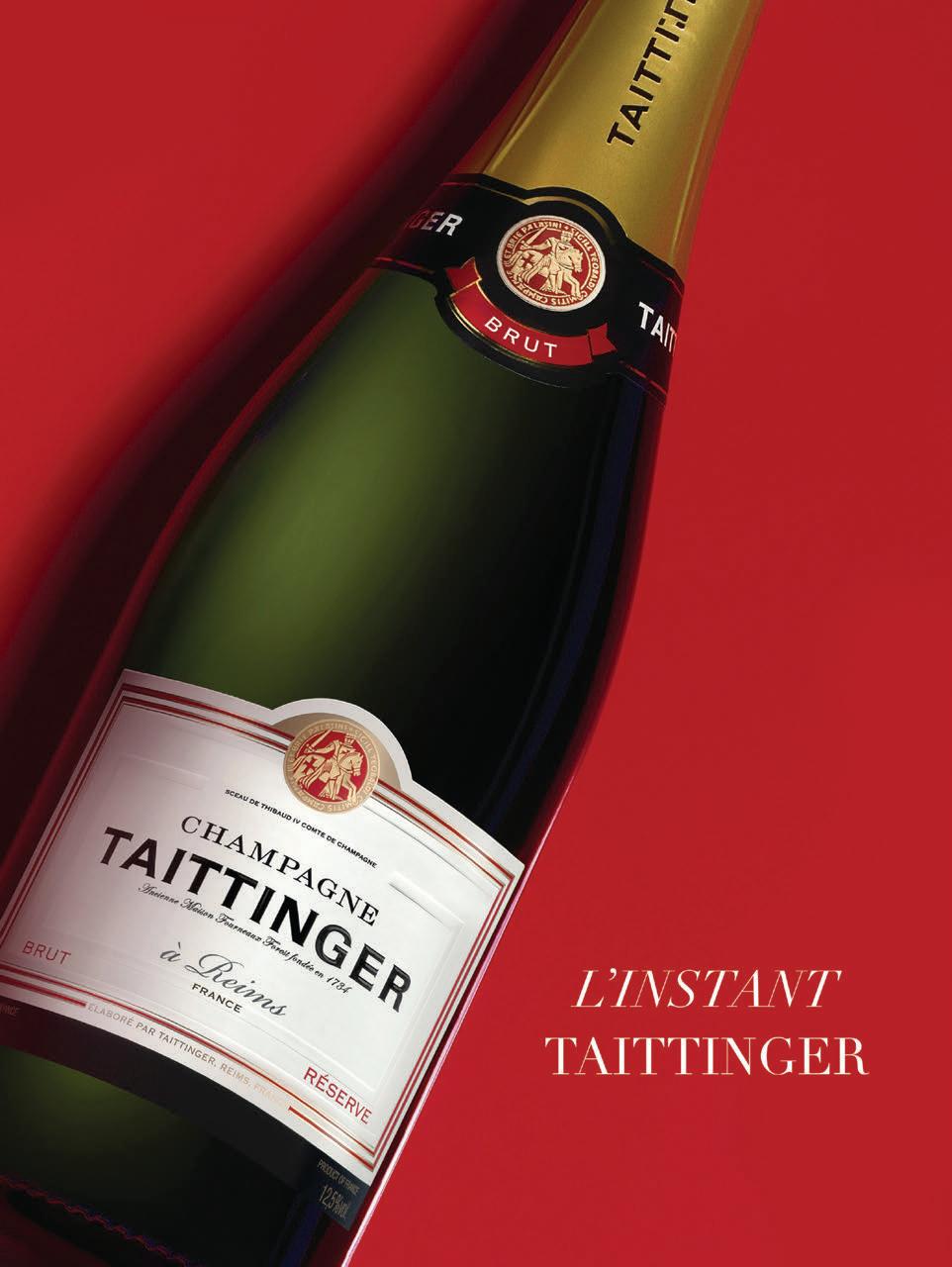
EXPOSICIÓN
MEET EGYPT: THE EXHIBITION OF RARE RELICS AND MUMMIES (MEET YOU

MUSEUM, CHINA)
“Meet you Museum” es una nueva iniciativa de cultura y arte del Grupo de la Industria de Turismo Cultural de Beijing Zhongchuang. Está comprometido a cooperar con las principales instituciones culturales internacionales y museos de clase mundial para crear un museo de arte mundial itinerante en China.
MEET EGYPT
MEET EGYPT: THE EXHIBITION OF RARE RELICS AND MUMMIES (MEET YOU MUSEUM, CHINA)
“Meet you Museum” is a new culture and art initiative of Beijing Zhongchuang Cultural Tourism Industry Group. It is committed to cooperating with leading international cultural institutions and world-class museums to create a travelling world art museum in China.
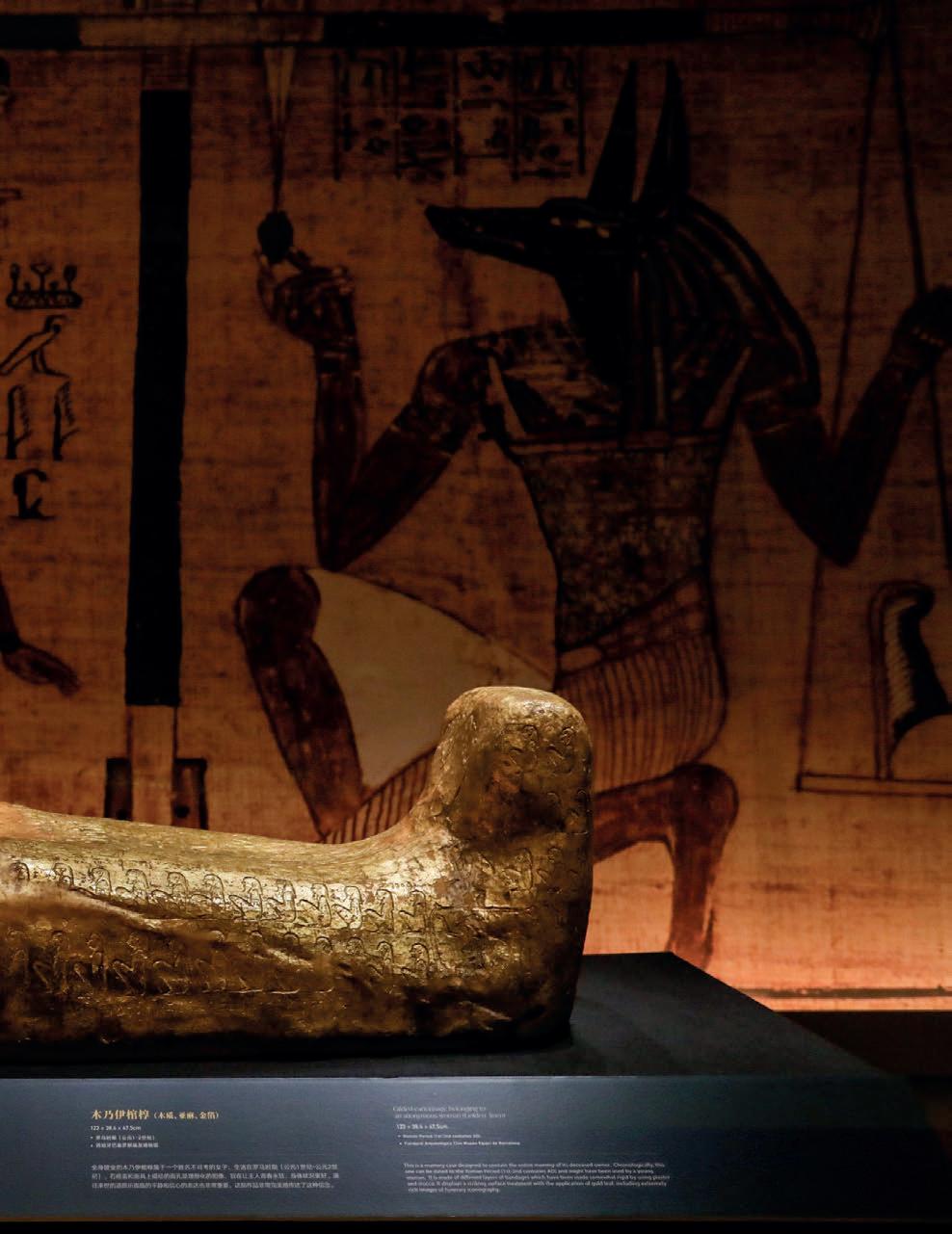
Una selección de 120 obras del Museo Egipcio de Barcelona (objetos arqueológicos y libros) se encuentra actualmente en la República Popular China formando parte de la exposición itinerante Meet Egypt: The exhibition of rare relics and mummies en un periplo que recorrerá durante un año cuatro de las ciudades más importantes de dicho país (Chengdu, Hangzhou, Beijing y Shanghái).
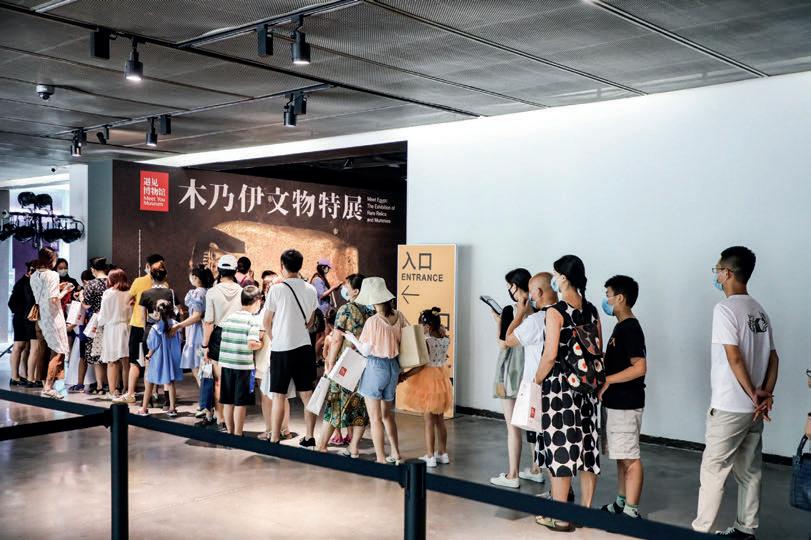
Los mitos en torno al Más Allá (mito de Osiris) y las prácticas funerarias (momificación, tumbas, culto a los muertos y equipamientos funerarios) son los temas desarrollados en la muestra, comisariada por Mariàngela Taulé y Luis Manuel Gonzálvez, directora y conservador del Museu Egipci de Barcelona. Entre las obras más destacadas figuran cuatro sarcófagos, así como el cartonaje de la Dama Dorada (que ha sido objeto de una réplica en impresión 3D para seguir contando con ella en nuestro Museo); varias momias y sarcófagos de animales sagrados, un conjunto de vasos canopos (contenedores para las vísceras), tres estatuas de substitución de diferentes épocas y un nutrido grupo de objetos de uso cotidiano (joyas, contenedores de ungüentos, recipientes cerámicos, herramientas…).
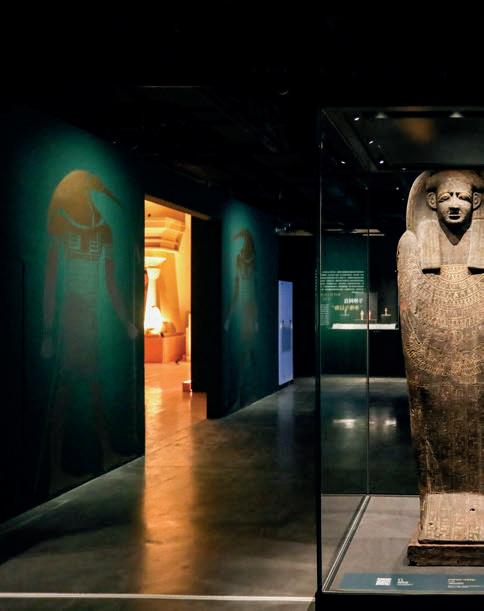
18
A selection of 120 works from the Egyptian Museum in Barcelona (archaeological objects and books) is currently in the People’s Republic of China as part of the travelling exhibition Meet Egypt: The exhibition of rare relics and mummies on a year-long tour of four major Chinese cities (Chengdu, Hangzhou, Beijing and Shanghai).

The myths surrounding the Afterlife (the myth of Osiris) and funerary practices (mummification, tombs, the cult of the dead and funerary equipment) are the themes developed in the exhibition, curated by Mariàngela Taulé and Luis Manuel Gonzálvez, director and curator of the Egyptian Museum of Barcelona. Among the most outstanding works are four sarcophagi, as well as the cartonnage of the Golden Lady (which has been the object of a 3D printing replica in order to keep it in our Museum); several mummies and sarcophagi of sacred animals, a set of canopic vases (containers for viscera), three replacement statues from different periods and a large group of objects of everyday use (jewellery, ointment containers, ceramic vessels, tools...). In the first two tours, which took place

19
UN PERIPLO QUE RECORRERÁ DURANTE UN AÑO CUATRO DE LAS CIUDADES MÁS IMPORTANTES DE CHINA
THE EXHIBITION OF RARE RELICS AND MUMMIES ON A YEAR-LONG TOUR OF FOUR MAJOR CHINESE CITIES
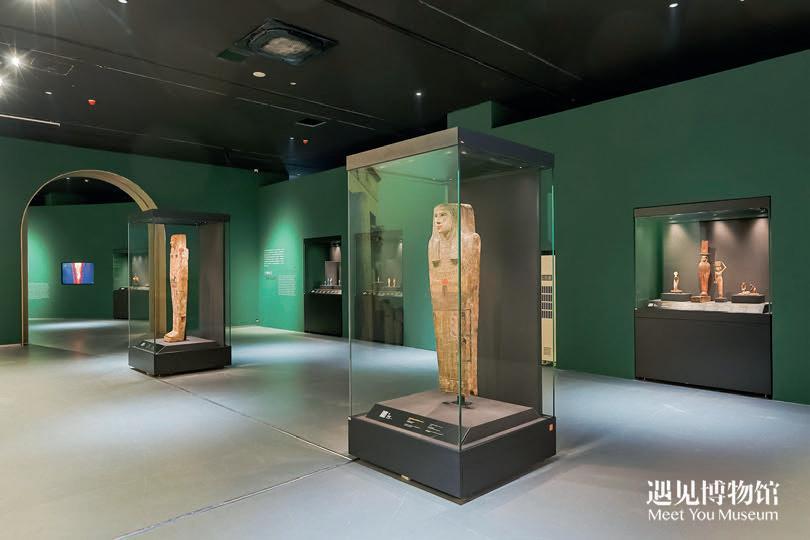
En las dos primeras itinerancias, ya realizadas a pesar de las terribles condiciones sanitarias todavía presentes en China, la exposición fue un éxito de acogida por parte del público.
Para Jordi Clos, presidente del Museu Egipci de Barcelona-Fundació Arqueològica Clos y para Joaquim Clos, director general de Derby Hotels Collection, la colaboración con el Meet You Museum es la acción más importante llevada a cabo por el Museu Egipci de Barcelona a lo largo de su historia en cuanto a exposiciones temporales se refiere y una muestra de la voluntad de acercamiento y colaboración de entidades que representan a países y tradiciones con un gran peso en la cultura universal.
despite the terrible sanitary conditions still present in China, the exhibition was a great success with the public.
For Jordi Clos, president of the Museu Egipci de Barcelona-Fundació Arqueològica Clos and Joaquim Clos, general director of Derby Hotels Collection, the collaboration with the Meet You Museum is the most important action carried out by the Museu Egipci de Barcelona throughout its history in terms of temporary exhibitions and a sign of the desire to bring together and collaborate with entities that represent countries and traditions with a great weight in universal culture.
20
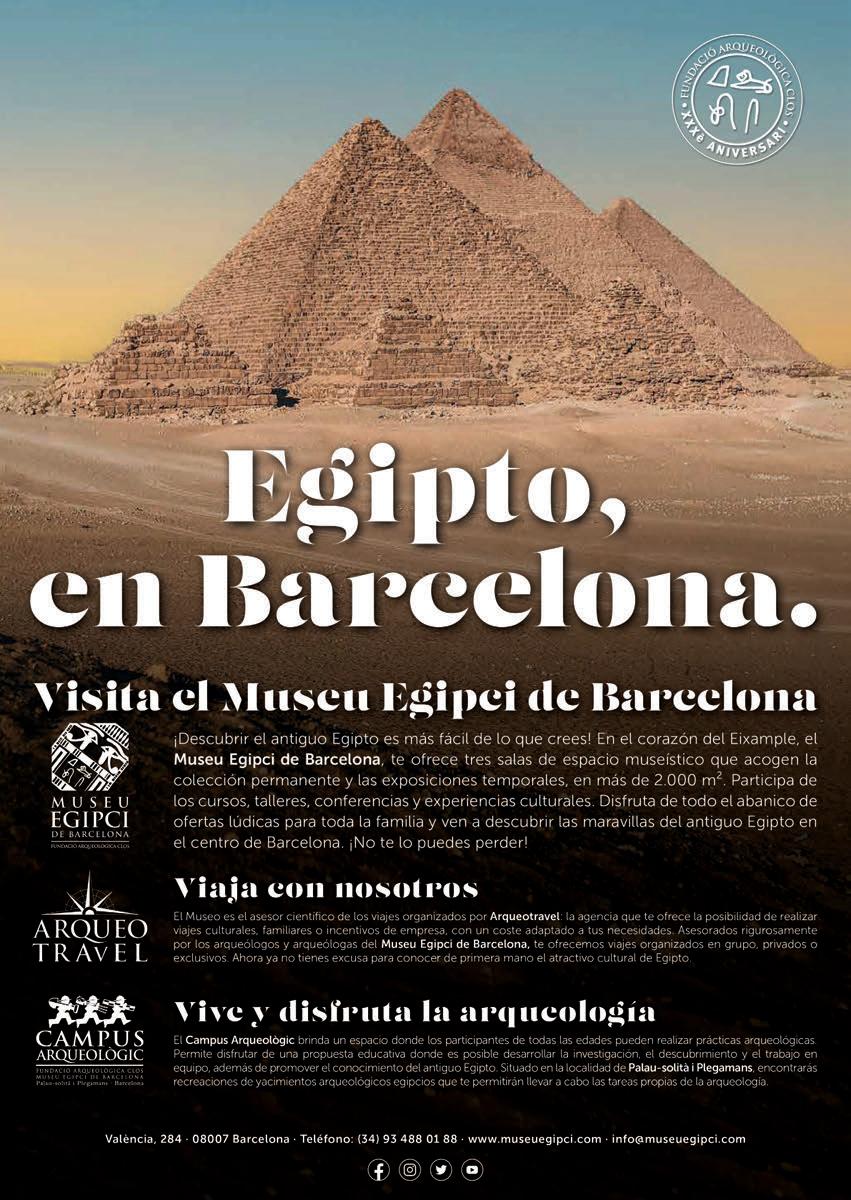
El Museu Egipci de Barcelona presenta documentación excepcional para conmemorar el bicentenario del desciframiento de la escritura jeroglífica por Jean François Champollion
Para celebrar este momento clave de la Egiptología, el Museu Egipci de Barcelona presenta documentos valiosos que se conservan en la Biblioteca Jordi Clos Llombart, entre los cuales se encuentra una carta manuscrita del egiptólogo italiano Ippolito Rosellini a Jean François Champollion en 1826
200 AÑOS DESCIFRANDO
200 YEARS DECIPHERING
THE EGYPTIAN MUSEUM OF BARCELONA PRESENTS EXCEPTIONAL DOCUMENTATION TO COMMEMORATE THE BICENTENARY OF THE DECIPHERMENT OF THE HIEROGLYPHIC WRITING BY JEAN FRANÇOIS CHAMPOLLION.
this key moment in
200 AÑOS DEL DESCIFRAMIENTO DE LA ESCRITURA JEROGLÍFICA
El 27 de septiembre de 1822 el sabio francés Jean François Champollion comunicó al mundo académico una de las más importantes aportaciones al estudio del mundo antiguo. La lectura de su famosa Lettre à Monsieur Dacier, relative à l’alphabet des Hié- roglyphes Phonétiques en la Académie des Inscriptions et Belles-Lettres de París señaló el momento en el que los jeroglíficos egipcios iban a dejar de ser un misterio para la ciencia, a la vez que muchos también consideran el contenido de la ponencia como el auténtico nacimiento de la Egiptología.
CHAMPOLLION Y EL DESCIFRAMIENTO DE LA ESCRITURA JEROGLÍFICA
La clausura de los templos faraónicos ordenada por el emperador Teodosio a finalesdel siglo IV d.C. fue la sentencia de muerte para las escrituras del antiguo Egipto: el último texto jeroglífico documentado es del año 394 (puerta de Adriano, isla de Filas) y el último texto demótico es un grafiti del 11 de diciembre del año 452, también en el templo de Filas. Más tarde, con la paulatina desaparición de la lengua copta (última fase de la lengua del antiguo Egipto) innumerables documentos escritos a lo largo de más de 3000 años quedarían como meros testimonios mudos de una civilización excepcional.
200 YEARS SINCE THE DECIPHERMENT OF HIEROGLYPHIC WRITING
On September 27, 1822, the French scholar Jean François Champollion communicated to the academic world one of the most important contributions to the study of the ancient world. The reading of his famous Lettre à Monsieur Dacier, relative à l’alphabet des Hiéroglyphes Phonétiques at the Académie des Inscriptions et Belles-Lettres in Paris signaled the moment when Egyptian hieroglyphs were to cease to be a mystery to science, while many also consider the content of the paper as the true birth of Egyptology.
CHAMPOLLION AND THE DECIPHERMENT OF HIEROGLYPHIC WRITING
The closure of the Pharaonic temples ordered by Emperor Theodosius at the end of the 4th century AD was the death knell for the writings of ancient Egypt: the last documented hieroglyphic text dates from 394 (Hadrian’s gate, island of Philae) and the last demotic text is a graffiti of December 11, 452, also in the temple of Philae. Later, with the gradual disappearance of the Coptic language (the last phase of the language of ancient Egypt), countless documents written over more than 3000 years would remain as mere silent testimonies of an exceptional civilization.
22
To celebrate
Egyptology, the Museu Egiptci de Barcelona presents valuable documents preserved in the Jordi Clos Llombart Library, including a handwritten letter from the Italian Egyptologist Ippolito Rosellini to Jean François Champollion in 1826.
El interés por el Egipto faraónico y sus misterios dio lugar a numerosas tentativas y propuestas en torno a la lectura de los jeroglíficos, que arrancan con el griego Horapolo (siglo IV d.C.), continuaron mucho más adelante con la obra del jesuita Athanasius Kircher (1601-1680 d.C.) y fueron especialmente intensas en el siglo XVIII (Warburton, Akerblad, Silvestre de Sacy, Zoega o De Guignes).
Sin restar mérito a los logros del físico y, en este caso, lingüista, Thomas Young (1773- 1829), es a Jean François Champollion a quien correspondió el honor de conseguir el desciframiento de las escrituras del antiguo Egipto.
Jean François Champollion nació en Figeac, el 23 de diciembre de 1790 y, desde muy joven, quedaría atrapado por el misterio de los jeroglíficos. Consciente de la importancia del conocimiento de otras lenguas estudió latín, griego, hebreo, árabe, copto, sirio, persa, sánscrito y chino. En un alarde de sabiduría y precocidad a los 16 años está convencido que la lengua copta es sólo una forma tardía de la lengua hablada en época faraónica; a los 18 años ya era profesor en la universidad de Grenoble. A lo largo de la segunda década del siglo XIX fue ahondando en el conocimiento del antiguo egipcio y del copto, trabajando especialmente con los textos de la famosa piedra de Rosetta, que contenía un mismo texto en dos lenguas (egipcia y griega) redactado en tres tipos de escritura (jeroglífica, demótica y griega). Las hipótesis obtenidas a partir de la piedra de Rosetta pudieron contrastarse positivamente con otro texto bilingüe hallado en un obelisco de la isla de Filas y fueron ampliadas y mejoradas a medida que nuevas inscripciones llegaban a las manos de Champollion.
Finalmente, convencido plenamente de la importancia y de la validez de sus conclusio- nes decidió presentarlas a la comunidad científica en una lectura pública en la Acadé- mie des Inscriptions et Belles-Lettres de París titulada Lettre à Monsieur Dacier, relative à l’alphabet des Hiéroglyphes Phonétiques. La Lettre a Monsieur Dacier sería publicada en octubre de ese mismo año.
The interest in Pharaonic Egypt and its mysteries gave rise to numerous attempts and proposals on the reading of hieroglyphs, starting with the Greek Horapollo (4th century A.D.), continuing much later with the work of the Jesuit Athanasius Kircher (1601-1680 A.D.) and especially intense in the 18th century (Warburton, Akerblad, Sylvestre de Sacy, Zoega or De Guignes).
Without detracting from the achievements of the physicist and, in this case, linguist, Thomas Young (17731829), it is to Jean François Champollion that the honor of deciphering the writings of ancient Egypt belongs.
Jean François Champollion was born in Figeac on December 23, 1790 and, from a very young age, he would be captivated by the mystery of hieroglyphics. Aware of the importance of knowledge of other languages, he studied Latin, Greek, Hebrew, Arabic, Coptic, Syriac, Persian, Sanskrit and Chinese. In a display of wisdom and precocity, at the age of 16 he is convinced that the Coptic language is only a late form of the language spoken in Pharaonic times; at the age of 18 he was already a professor at the University of Grenoble. Throughout the second decade of the 19th century, he was deepening his knowledge of ancient Egyptian and Coptic, working especially with the texts of the famous Rosetta Stone, which contained the same text in two languages (Egyptian and Greek) written in three types of script (hieroglyphic, demotic and Greek). The hypotheses obtained from the Rosetta stone could be positively contrasted with another bilingual text found on an obelisk on the island of Philae and were expanded and improved as new inscriptions came into Champollion’s hands.
Finally, fully convinced of the importance and validity of his conclusions, he decided to present them to the scientific community in a public lecture at the Acadé- mie des Inscriptions et Belles-Lettres in Paris entitled Lettre à Monsieur Dacier, relative à l’alphabet des Hiéroglyphes Phonétiques. The Lettre a Monsieur Dacier would be published in October of the same year.
LA CONSOLIDACIÓN DEL DESCIFRAMIENTO
En 1824 con la publicación del Précis du système hiéroglyphique, donde con un par de frases Champollion definió de forma esclarecedora la esencia de la escritura jeroglífica:
“…un sistema complejo de una escritura a la vez figurativa, simbólica y fonética en un mismo texto, una frase, yo diría que incluso, en la misma palabra”
THE CONSOLIDATION OF DECIPHERMENT
In 1824 with the publication of the Précis du système hiéroglyphique, where in a couple of sentences Champollion enlighteningly defined the essence of hieroglyphic writing:
“...a complex system of a writing at once figurative, symbolic and phonetic in the same text, a sentence, I would even say, in the same word.”
23
Champollion fue nombrado Caballero de la Legión de Honor por el rey Carlos X de Francia y a partir de 1826 ocupó el cargo de conservador de la colección egipcia del Museo del Louvre, donde participó activamente para conseguir la adquisición de una de las colecciones egipcias del cónsul Henry Salt. Más tarde, acompañado de su fiel alumno el toscano Ippolito Rossellini realizó una misión científica en Egipto y Nubia (1828-29), donde pudieron aplicar sobre el terreno la utilidad del conocimiento del egipcio antiguo. Champollion no iba a tener tiempo de hacer muchas más cosas; la que debiera haber sido una vida de trabajo, estudio y ricas aportaciones a la Egiptología quedó interrumpida por la prematura muerte del sabio en 1832, al poco tiempo de conseguir la primera cátedra de Egiptología en el Collège de France (1831).
La temprana muerte de Champollion dejó muchos de sus trabajos sin concluir o sin pu-blicar. Gracias al interés y la devoción de su hermano mayor Jacques-Joseph, conocido como Champollion-Figeac, la mayor parte de su obra pudo ver la luz a título póstumo:
• Grammaire égyptienne ou Principes généraux de l’écriture sacrée égyptienne appliqué à la représentation de la langue parlée. París, 1836.
• Monuments de l’Égypte et de la Nubie, París, 1835-1845 y 1844-1879.
• Dictionnaire égyptien en écriture hiéroglyphique, París, 1841.
HOMENAJE DEL MUSEU EGIPCI DE BARCELONA
Para conmemorar este importante bicentenario el Museu Egipci de Barcelona ha organizado una muestra temporal integrada por documentos excepcionales que se conservan en la Biblioteca de esta entidad, la Biblioteca Jordi Clos Llombart. Junto a la colección de arte faraónico la Biblioteca constituye el fondo patrimonial más importante del M useo Una Biblioteca especializada en el Eg ipto faraónico que cuenta con más de 12000 obras registradas. Monografías modernas y publicaciones seriadas de las entidades egiptológicas más prestigiosas del mundo conviven con más de 500 obras anteriores al año 1900 entre las que se encuentran el Prodromus Coptus sive Aegyptia- cus (1636) , de Athanasius Kircher, o los 10 volúmenes de láminas y los 24 de texto de la Description de l’Égypte , realizada gracias a la labor del centenar y medio de sabios que formaron parte de la expedición napoleónica a Egipto.
LA CARTA DEL EGIPTÓLOGO ITALIANO IPPOLITO ROSELLINI A CHAMPOLLION
Además de estas obras impresas, la Biblioteca conserva algunos documentos únicos como la carta fechada el 8 de
Champollion was named Knight of the Legion of Honor by King Charles X of France and from 1826 he became curator of the Egyptian collection of the Louvre Museum, where he actively participated in the acquisition of one of the Egyptian collections of Consul Henry Salt. Later, accompanied by his faithful pupil, the Tuscan Ippolito Rossellini, he carried out a scientific mission in Egypt and Nubia (1828-29), where they were able to apply on the ground the usefulness of the knowledge of ancient Egyptian. Champollion was not to have time to do much else; what should have been a life of work, study, and rich contributions to Egyptology was cut short by the scholar’s untimely death in 1832, shortly after obtaining the first chair of Egyptology at the Collège de France (1831).
Champollion’s early death left many of his works unfinished or unpublished. Thanks to the interest and devotion of his older brother Jacques-Joseph, known as Champollion-Figeac, most of his work was able to see the light of day posthumously:
• Grammaire égyptienne ou Principes généraux de l’écriture sacrée égyptienne appliqué à la représentation de la langue parlée. Paris, 1836.
• Monuments de l’Égypte et de la Nubie, Paris, 18351845 and 1844-1879.
• Dictionnaire égyptien en écriture hiéroglyphique, Paris, 1841.
TRIBUTE FROM THE EGYPTIAN MUSEUM OF BARCELONA
To commemorate this important bicentenary, the Egyptian Museum of Barcelona has organized a temporary exhibition made up of exceptional documents that are kept in the Museum’s library, the Jordi Clos Llombart Library. Together with the collection of Pharaonic art, the Library constitutes the most important patrimonial collection of the Museum. A Library specialized in Pharaonic Egypt with more than 12,000 registered works. Modern monographs and serial publications from the world’s most prestigious Egyptological institutions coexist with more than 500 pre-1900 works, including Athanasius Kircher’s Prodromus Coptus sive Aegyptia-cus (1636) and the 10 volumes of plates and 24 volumes of text of the Description de l’Égypte, produced thanks to the work of the hundred and a half scholars who took part in the Napoleonic expedition to Egypt.
THE LETTER OF THE ITALIAN EGYPTOLOGIST IPPOLITO ROSELLINI TO CHAMPOLLION
In addition to these printed works, the Library preserves some unique documents such as the letter dated Oc-
24
octubre de 1826 dirigida por el egiptólogo toscano Ippolito Rosellini a su admirado maestro Jean-François Champollion. El discípulo se dirige a su maestro en un tono altisonante, pleno de devoción y complicidad en un momento en el que los logros de Champollion han conmocionado al mundo académico, bienve- nidos y admirados por unos y denostados y criticados por otros. El trabajo de Champo- llion abrió las puertas al conocimiento de innumerables textos escritos necesarios para el estudio del pasado pero, por otro lado, además de las inevitables envidias y recelos que suelen despertar los genios, generó auténtico pavor y rechazo entre los que lo vieron como una amenaza para las verdades y el contenido de las Sagradas Escrituras. Una carta, en definitiva, que es testimonio de un momento crucial de la historia de la Egiptología protagonizada por dos de sus grandes figuras.
tober 8, 1826 addressed by the Tuscan Egyptologist Ippolito Rosellini to his admired master Jean-François Champollion. The disciple addresses his master in a high-flown tone, full of devotion and complicity at a time when Champollion’s achievements have shocked the academic world, welcomed and admired by some and reviled and criticized by others. Champollion’s work opened the doors to the knowledge of innumerable written texts necessary for the study of the past but, on the other hand, in addition to the inevitable envy and suspicion that geniuses usually arouse, it generated genuine fear and rejection among those who saw it as a threat to the truths and content of the Holy Scriptures. A letter, in short, that is a testimony of a crucial moment in the history of Egyptology starring two of its great figures.
Primera edición de la obra Prodromus Coptus sive Aegyptiacus, de Athanasius Kircher, Roma, 1636. Biblioteca Jordi Clos Llombart.
Pese a que Kircher erró gravemente en su interpretación de la escritura jeroglífica, esta obra fue importante para el conocimiento del copto, lengua que más tarde sería crucial para Champollion como herramienta utilizada en el desciframiento de la escritura je- roglífica.
1
First edition of the work Prodromus Coptus sive Aegyptiacus, by Athanasius Kircher, Rome, 1636. Jordi Clos Llombart Library.
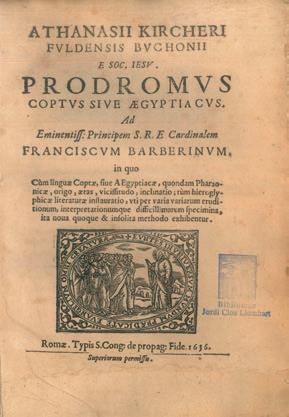
Although Kircher erred seriously in his interpretation of the hieroglyphic script, this work was important for the knowledge of Coptic, a language that would later be crucial for Champollion as a tool used in the decipherment of the hieroglyphic script.
Reproducción de la piedra de Rosetta. Museu Egipci de Barcelona. Museu Egipci de Barcelona.
Poco tiempo después de la llegada de la piedra de Roseta a Londres, se realizaron cuatro copias en yeso de la misma y, posiblemente a lo largo del siglo XIX se hicieran algunas más. El origen de esta pieza es incierto. Se sabe que esta copia del monumento clave en el proceso de desciframiento de la escritura jeroglífica perteneció anteriormente al Toledo Museum (Ohio, EUA) donde había ingresado en el año 1906
2Reproduction of the Rosetta stone. Egyptian Museum of Barcelona. Egyptian Museum of Barcelona.
Shortly after the arrival of the Rosetta stone in London, four plaster copies of it were made, and possibly throughout the nineteenth century some more were made. The origin of this piece is uncertain. It is known that this copy of the key monument in the process of deciphering the hieroglyphic writing previously belonged to the Toledo Museum (Ohio, USA) where it had entered in 1906.
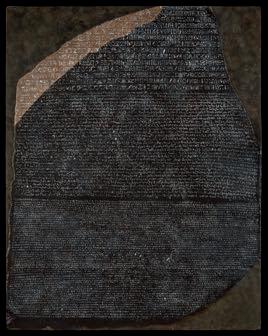
25
1 2
Volúmen V (láminas) de la Description de l’Egypte (29 edición, 1823). Biblioteca Jordi Clos Llombart.
La piedra de Roseta aparece reproducida en tres láminas que corresponden a los distintos tipos de escritura grabados en la misma. En la primera lámina se incluyó la primera línea de la inscripción intermedia para que sirviera de punto de referencia. Los mismo se hizo con las otras dos láminas. De esta forma, los tres documentos pueden unirse en una sola hoja.
Primera edición de la Lettre à Monsieur Dacier, relative à l’alphabet de Hiéroglyphes
Phonetiques..., París, 1822. Biblioteca Jordi Clos Llombart.
A finales de septiembre del año 1822, Champollion realizó una comunicación científica en formato de carta al Secretario Perpetuo de l’Académie d’Inscripcions et Belles-Lettres de París, donde le hacía partícipe del desciframiento de la escritura jeroglífica y especi- ficaba la lectura de los jeroglíficos fonéticos.
3 4 5
Carta enviada por Ippolito Rosellini a Jean François Champollion desde Bolonia (15 de octubre de 1826).
Biblioteca Jordi Clos Llombart.
Este manuscrito excepcional recoge el estado de opinión creado a partir de la difusión de los logros de Champollion con la escritura jeroglífica. Tuvo discípulos
3 4 5
Volume V (plates) of the Description de l’Egypte (29th edition, 1823). Jordi Clos Llombart Library.
The Rosetta stone is reproduced in three plates corresponding to the different types of writing engraved on it. In the first plate the first line of the intermediate inscription was included to serve as a reference point. The same was done with the other two plates. In this way, the three documents can be united on a single sheet.
First edition of the Letter to Mr. Dacier, relative to the Phonetic Hieroglyphic alphabet..., Paris, 1822. Biblioteca Jordi Clos
At the end of September 1822, Champollion made a scientific communication in the form of a letter to the Perpetual Secretary of the Académie d’Inscripcions et Belles-Lettres of Paris, in which he shared with him the decipherment of the hieroglyphic writing and specified the reading of the phonetic hieroglyphs.


Letter sent by Ippolito Rosellini to Jean François Champollion from Bologna (October 15, 1826). Jordi Clos Llombart Library.
This exceptional manuscript reflects the state of opinion created by the diffusion of Champollion’s achievements with hieroglyphic writing. He had disciples
26
y defensores como Rosellini (el padre de la Egiptología italiana) y detractores encarnizados como Lanci o Seyffarth. Reproducimos un significativo fragmento de la carta:
«Orioli y yo, por todas partes reprenderemos a la insidia y la calumnia y demostraremos que el descubrimiento de los jeroglíficos ha sido un verdadero regalo de la Providencia para confirmar la verdad de la Biblia en un siglo de tanto desarraigo»
and defenders like Rosellini (the father of Italian Egyptology) and fierce detractors like Lanci or Seyffarth. We reproduce a significant fragment of the letter:
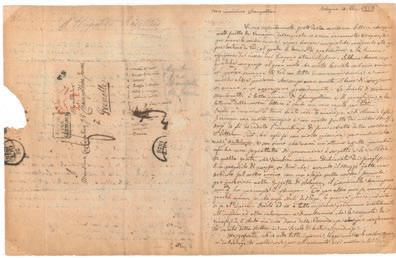
“Orioli and I, everywhere we will rebuke insidiousness and slander and demonstrate that the discovery of hieroglyphics has been a true gift of Providence to confirm the truth of the Bible in a century of so much uprooting.”
6 7
Primera edición del Précis du système hiéroglyphique des anciens égyp- tiens, París, 1824.
Con esta obra quedó fuertemente consolidado el conocimiento de la lengua egipcia y sus diferentes tipos de escritura, especialmente la jeroglífica.
Primera edición del Dictionnaire Égyptien en écriture hiéroglyphique, de J. F. Champollion, París, 184143. Biblioteca Jordi Clos Llombart.
Tras la muerte de Champollion, su hermano Champollion Figeac hizo publicar esta obra a partir de las notas dejadas por su hermano. Esta obra, junto con
6 7
First edition of the Précis du système hiéroglyphique des anciens égyp- tiens, Paris, 1824.

With this work, the knowledge of the Egyptian language and its different types of writing, especially hieroglyphic, was strongly consolidated.
First edition of the Dictionnaire Égyptien en écriture hiéroglyphique, by J. F. Champollion, Paris, 184143. Jordi Clos Llombart Library.
After Champollion’s death, his brother Champollion Figeac had this work published from the notes left by his brother. This work, together with a grammar are the
27
una gramática son los dos máximos exponentes del importante trabajo realizado por el sabio francés tras el desciframiento de la escritura jeroglífica.
two most important exponents of the important work done by the French scholar after the decipherment of the hieroglyphic writing.
Varias láminas y las Notices descriptives de la obra Monuments de l’Égypte et de la Nubie, París, 18351889.

Los resultados de la expedición científica a Egipto (1828-1829) a cargo de Champollion y Rosellini fueron publicados independientemente. La obra de Rosellini I monumenti dell’Egitto e della Nubia fue la primera en ver la luz (1832-1844). Por parte de Cham- pollion, la publicación de sus Monuments de l’Égypte et de la Nubie se inició en 1835 a partir de una comisión de la que formaba parte su hermano Champollion Figeac y fue terminada en 1889.
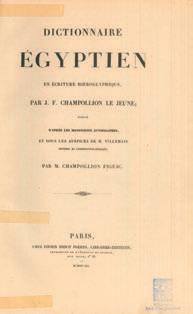
Several plates and the Notices descriptives of the work Monuments de l’Égypte et de la Nubie, Paris, 1835-1889.


The results of the scientific expedition to Egypt (18281829) by Champollion and Rosellini were published independently. Rosellini’s I monumenti dell’Egitto e della Nubia was the first to see the light (1832-1844). On Cham- pollion’s part, the publication of his Monuments de l’Égypte et de la Nubie was started in 1835 by a commission of which his brother Champollion Figeac was a member and was completed in 1889.
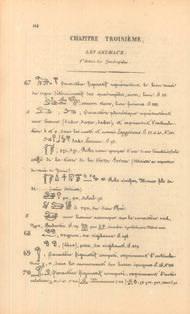
28
8
8
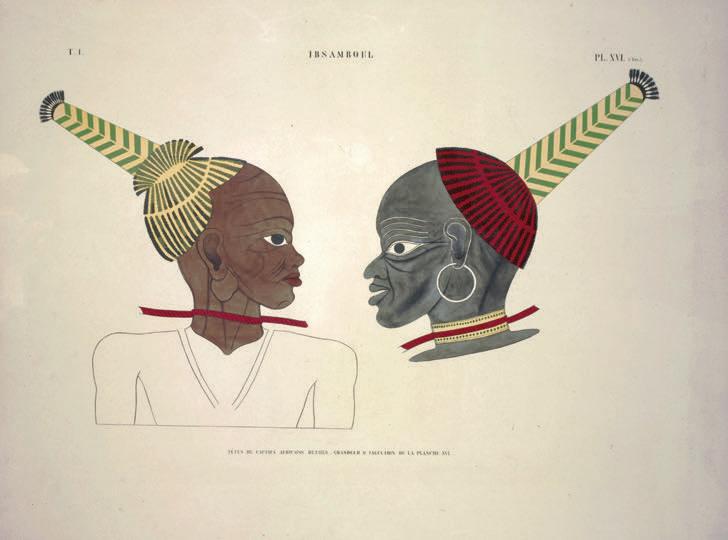
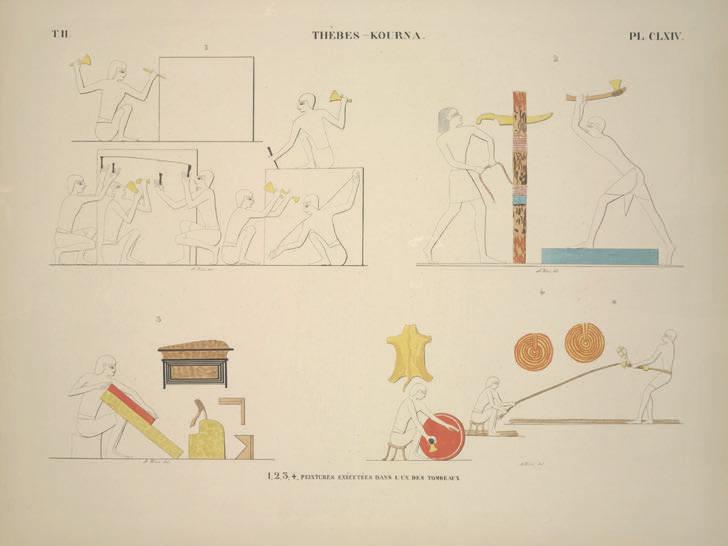
29
GLASS BY SIPS

EL HOTEL URBAN TRAE A MADRID UNA DE LAS MEJORES COCTELERÍAS
DEL MUNDO Y ABRE EL GLASS BY SIPS
La coctelería de Simone Caporale y Marc Álvarez ha sido reconocida como la tercera mejor del mundo, según
The World’s 50 Best Bars 2022.
El Hotel Urban 5*GL, de Derby Hotels Collection, continúa impulsando su propuesta gastronómica y el próximo mes de noviembre abrirá el Glass by Sips, un innovador concepto de coctelería junto a Simone Caporale y Marc Álvarez.
Glass by Sips supone el primer proyecto de Caporale y Álvarez en Madrid, tras el rotundo éxito de su bar en Barcelona. Su llegada a la capital española se produce justo cuando Bar Sips ha sido reconocida esta semana como la tercera mejor coctelería del mundo por el prestigioso ranking The World’s 50 Best Bars 2022, “La familia de Sips crece, la inquietud creativa siempre nos hace volar, crear, innovar y, sobre todo, explorar. En este caso Sips quería explorar nuevos territorios. Después de los dos espacios de Barcelona, Drinkery House y Esencia, ahora llega de la mano de Derby Hotels Collection un nuevo espacio: Glass By Sips, en el corazón del hotel Urban de Madrid, donde el ADN creativo se integra en el ADN del hotel para generar un espacio único en el que probar las creaciones más conocidas de Sips”, explican Marc Álvarez y Simone Caporale.
Por su parte, Joaquim Clos, director general de Derby Hotels Collection, celebra esta alianza con Sips, que traerá a Madrid una nueva forma de concebir la coctelería. “Los cambios son oportunidades y esta apertura es para nosotros una gran oportunidad de crecimiento y transformación para posicionarnos como el hotel gastronómico de referencia. Durante mi etapa en Londres, tuve la oportunidad de conocer a Simone y ser testigo de cómo lideró a The Artesian, del Hotel The Langham, hasta convertirlo en el mejor bar del mundo. También he seguido de cerca con admiración a Marc Álvarez, quien se ganó el puesto de Group Bar Manager en el reconocido grupo gastronómico elBarri, de Albert y
HOTEL URBAN BRINGS ONE OF THE WORLD’S BEST COCKTAIL BARS TO MADRID AND OPENS GLASS BY SIPS
Simone Caporale and Marc Álvarez’s cocktail bar has been recognized as the third best in the world, according to The World’s 50 Best Bars 2022.
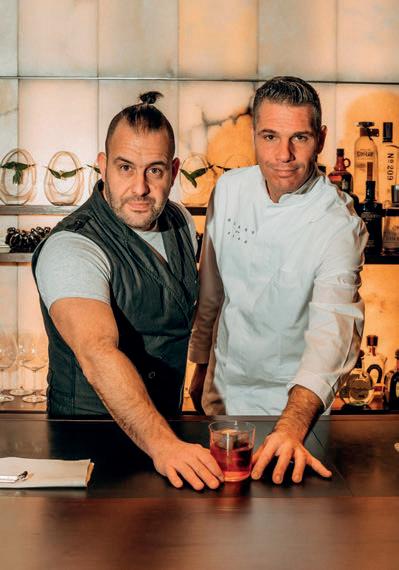
Hotel Urban 5*GL, of Derby Hotels Collection, continues to promote its gastronomic proposal and next November will open Glass by Sips, an innovative cocktail bar concept with Simone Caporale and Marc Álvarez.
Glass by Sips is the first project of Caporale and Alvarez in Madrid, after the resounding success of their bar in Barcelona. Their arrival in the Spanish
31
Ferran Adrià. Estos logros, sin duda, son una fuente de inspiración para nosotros, que siempre tenemos en mente el reto de buscar propuestas innovadoras con productos de excelencia”, destaca.
“Nos sentimos muy ilusionados con este equipo que estamos formando con dos de los más grandes de la coctelería española y con todo lo que, a partir de ahora, ofreceremos a los madrileños al ser los primeros en traer a la capital un concepto tan auténtico y diferencial de la coctelería mundial”, añade Joaquim Clos.
SOBRE SIPS “DRINKERY HOUSE”
Un espacio diáfano, sin una barra como elemento central y con los cócteles como obra de arte que expresan un lenguaje, transmiten una sensación y crean experiencias. Este rompedor concepto de ‘drinkery house’ nació en 2021 en Barcelona bajo el ingenio de Marc Álvarez y Simone Caporale con la apertura de Sips Bar, que en apenas pocos meses debutó en The World’s 50 Best Bars en el puesto 37 y un año más tarde alcanzó el top 3 mundial. Su visión va más allá de la coctelería y busca reivindicar el mundo de la bebida con un sello distintivo, tanto en sus sabores como en la presentación: cada cóctel tiene su propia vajilla.
capital comes just as Bar Sips has been recognized this week as the third best cocktail bar in the world by the prestigious ranking The World’s 50 Best Bars 2022, “The Sips family is growing, the creative restlessness always makes us fly, create, innovate and, above all, explore. In this case, Sips wanted to explore new territories. After the two spaces in Barcelona, Drinkery House and Esencia, now comes from the hand of Derby Hotels Collection a new space: Glass By Sips, in the heart of the Urban hotel in Madrid, where the creative DNA is integrated into the DNA of the hotel to create a unique space in which to try the best known creations of Sips”, explain Marc Alvarez and Simone Caporale.
For his part, Joaquim Clos, general manager of Derby Hotels Collection, celebrates this alliance with Sips, which will bring to Madrid a new way of conceiving cocktails. “Changes are opportunities and this opening is for us a great opportunity for growth and transformation to position ourselves as the gastronomic hotel of reference. During my time in London, I had the opportunity to meet Simone and witness how he led The Artesian at The Langham Hotel to become the best bar in the world. I have also closely followed with admiration Marc Alvarez, who earned the position of Group Bar Manager at Albert and Ferran Adrià’s renowned gastronomic group elBarri. These achievements are undoubtedly a source of inspiration for us, who always keep in mind the challenge of seeking innovative proposals with products of excellence,” he emphasizes.
“We are very excited about this team that we are forming with two of the greatest Spanish cocktail makers and with everything that, from now on, we will offer to the people of Madrid as we are the first to bring to the capital such an authentic and differential concept in the world of cocktails,” adds Joaquim Clos.
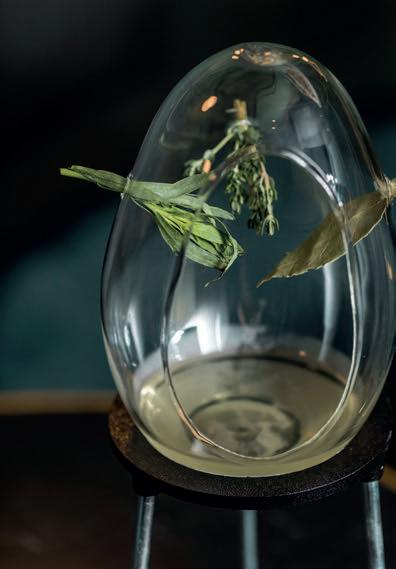
ABOUT SIPS “DRINKERY HOUSE”
A diaphanous space, without a bar as a central element and with cocktails as a work of art that express a language, transmit a sensation and create experiences. This groundbreaking concept of ‘drinkery house’ was born in 2021 in Barcelona under the ingenuity of Marc Álvarez and Simone Caporale with the opening of Sips Bar, which in just a few months debuted in The World’s 50 Best Bars in 37th place and a year later reached the top 3 worldwide. Their vision goes beyond the cocktail bar and seeks to reclaim the world of drinking with a distinctive seal, both in its flavors and
32
KRYPTA UN CÓCTEL QUE SE PUEDE RESPIRAR
REGRESO A LOS ORÍGENES
Con esta alianza, el icónico espacio evolucionará para volver a sus orígenes vinculados a la coctelería. Con el Glass by Sips, el Hotel Urban ofrecerá una completa experiencia al usuario: un Cocktail Bar; CEBO y La Terraza, en la última planta, considerada uno de los rooftop más importantes de la capital.
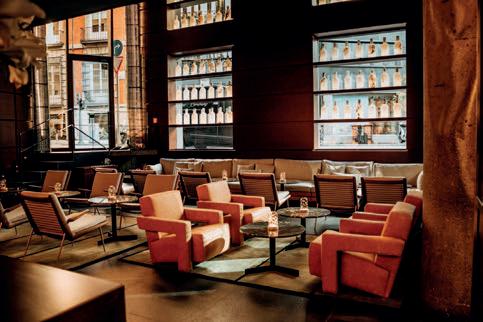

Glass Bar nació hace más de 15 años y de inmediato se convirtió en un referente en la capital madrileña. Enmarcado en el concepto cinco estrellas de gran lujo y exclusividad del Hotel Urban, este espacio se mantiene en consonancia con el objetivo de aportar un valor diferencial a través de su oferta en los establecimientos de restauración, con una oferta de bebidas y gastronomía de máxima calidad y exclusividad.
Sobre Derby Hotels Collection Actualmente la compañía cuenta con 22 establecimientos de lujo en Barcelona, Madrid, Londres y París. Cada uno de ellos es distinto e irrepetible, espacios que ofrecen una experiencia en alojamiento y también gastronómica. En los últimos años, Derby Hotels Collection cuenta con espacios referentes dentro del panorama gastronómico.
Apasionado por los hoteles, el arte y la cultura, Jordi Clos es el Presidente de Derby Hotels Collection, fundador del Museu Egipci de Barcelona y Presidente de la Fundació Arqueològica Clos, y Joaquim Clos, Director General de la colección. El sello y la identidad de la familia Clos están presentes en todos los rincones de sus hoteles y apartamentos.
presentation: each cocktail has its own tableware.
BACK TO THE ORIGINS
With this alliance, the iconic space will evolve to return to its origins linked to cocktails. With Glass by Sips, Hotel Urban will offer a complete user experience: a Cocktail Bar; CEBO and La Terraza, on the top floor, considered one of the most important rooftops in the capital.
Glass Bar was born more than 15 years ago and immediately became a benchmark in the capital of Madrid. Framed in the five-star concept of great luxury and exclusivity of the Hotel Urban, this space remains in line with the objective of providing a differential value through its offer in catering establishments, with an offer of drinks and gastronomy of the highest quality and exclusivity.
About Derby Hotels Collection The company currently has 22 luxury establishments in Barcelona, Madrid, London and Paris. Each one of them is different and unrepeatable, spaces that offer an accommodation and gastronomic experience. In recent years, Derby Hotels Collection has become a benchmark in the gastronomic panorama.
Passionate about hotels, art and culture, Jordi Clos is the President of Derby Hotels Collection, founder of the Museu Egipci de Barcelona and President of the Fundació Arqueològica Clos, and Joaquim Clos, General Director of the collection. The seal and identity of the Clos family are present in every corner of their hotels and apartments.
33
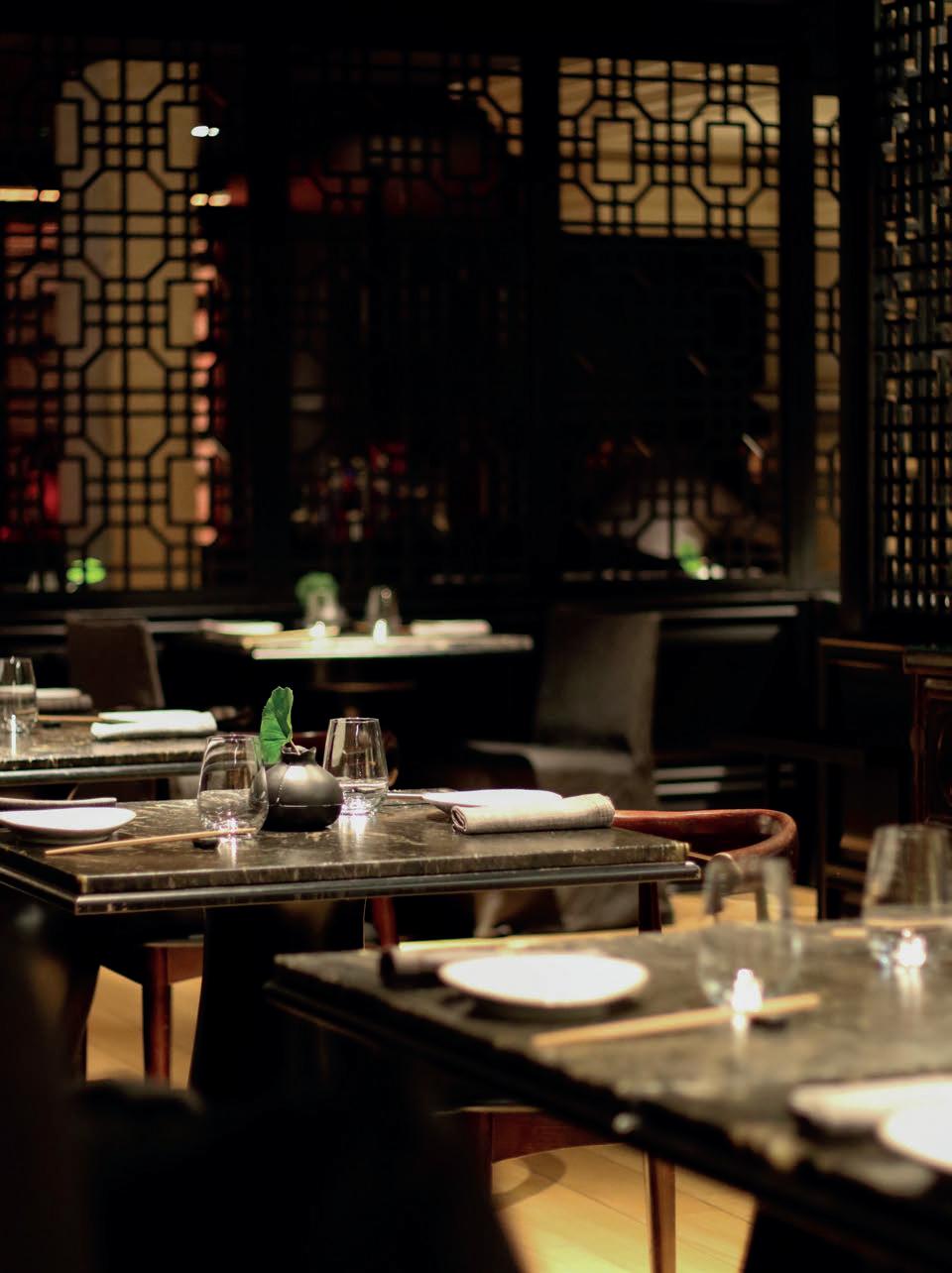
 HOTEL CLARIS (PAU CLARIS, 150)
HOTEL CLARIS (PAU CLARIS, 150)
LA OFERTA DE OS-KURO PUEDE CONCEBIRSE COMO LO MEJOR DE ASIA en el corazón de Barcelona. Una experiencia gastronómica que funde la infinita versatilidad y delicadeza de la comida asiática con la rotundidad y modernidad de la ciudad condal, donde cada rincón invita a la mundología.
OS-KURO’S OFFER CAN BE CONCEIVED AS THE BEST OF ASIA in the heart of Barcelona. A gastronomic experience that fuses the infinite versatility and delicacy of Asian food with the boldness and modernity of Barcelona, where every corner is an invitation to the world.
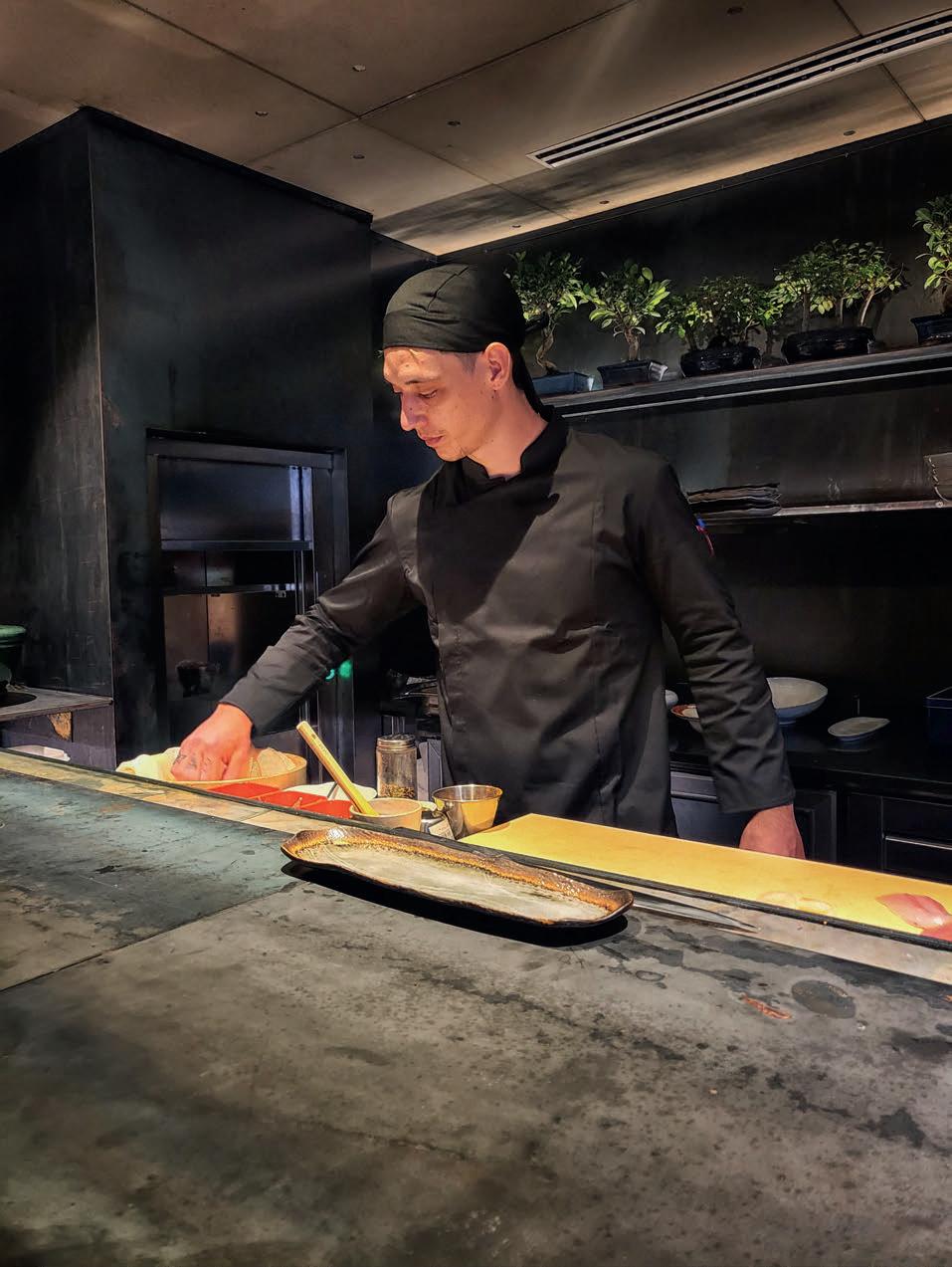
Os-Kuro se divide entre el Sushi Bar de la planta baja, que atiende Brendan Ferrero, y el Restaurante del primer piso, en el que degustar una selecta carta a base de robata, tempura, wok y otras especialidades asiáticas.

El toque artístico del chef Brendan Ferrero, hijo de irlandesa y de leonés, y gallego de nacimiento, —las raíces apuntan muy alto— pone ese broche tan sensacional que solo se deja entrever entre los milagros de la naturaleza. Aquellos que sin saber por qué, logran que
UN DOBLE ESPACIO, SUSHI BAR Y RESTAURANTE EN EL QUE LA
LUZ Y LAS SOMBRAS JUEGAN CON EL PROPIO NOMBRE OSKURO, DEL JAPONÉS 黒 (KURO)
QUE SIGNIFICA NEGRO
Os-Kuro is divided between the Sushi Bar on the ground floor, run by Brendan Ferrero, and the restaurant on the first floor, where you can enjoy a select menu based on robata, tempura, wok and other Asian specialities.
The artistic touch of the chef Brendan Ferrero, son of Irish and Leonese parents, and Galician by birth, -the roots point very high- puts that sensational finishing touch that can only be glimpsed among the miracles
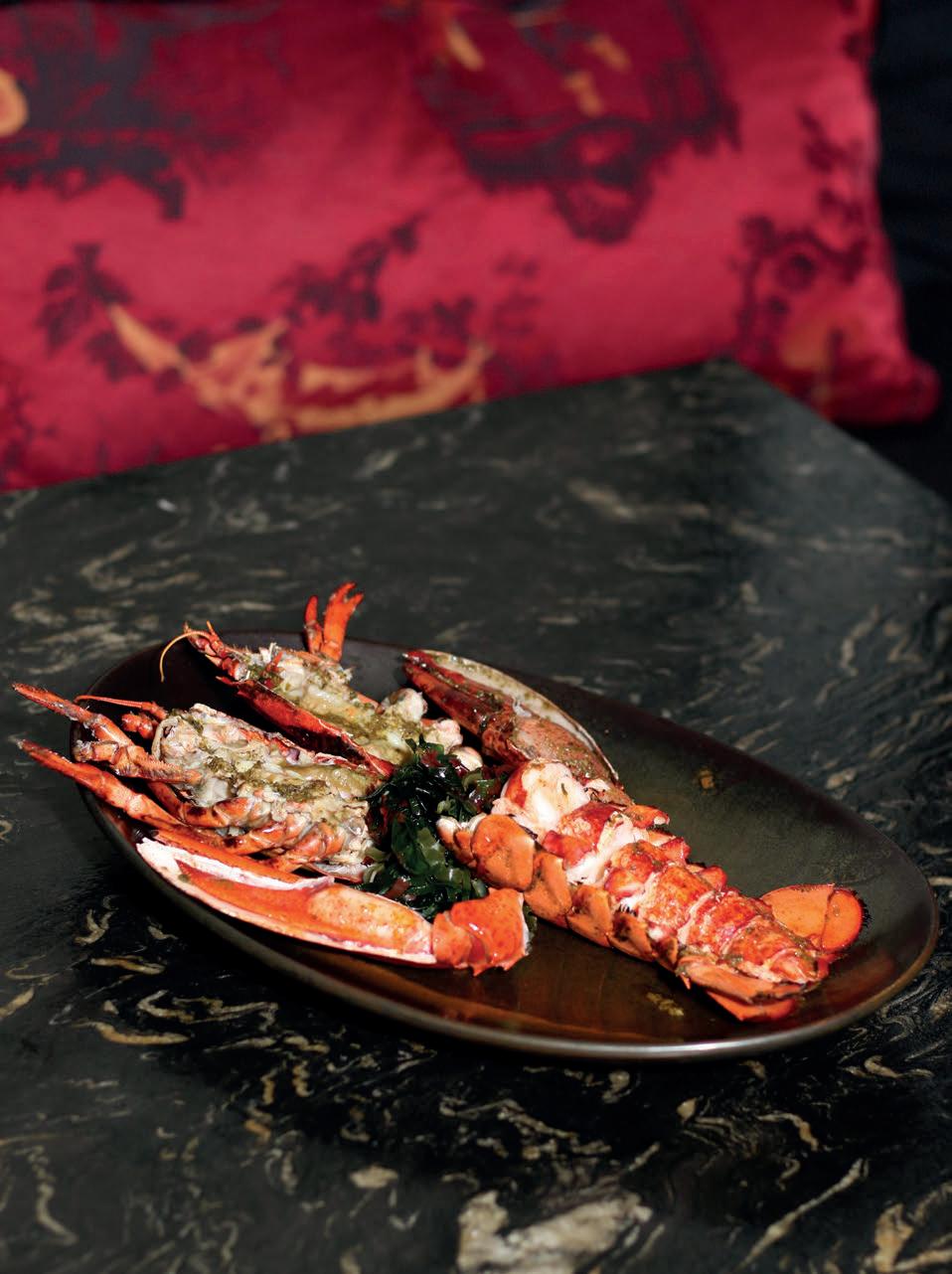
A DOUBLE SPACE, SUSHI BAR AND RESTAURANT IN WHICH LIGHT AND SHADOWS PLAY WITH THE NAME OSKURO, FROM THE JAPANESE 黒 (KURO) WHICH MEANS BLACK.
todo encaje, que todos los elementos se exhiban como un traje de alta costura, cosido de manera artesanal, sin costuras, para formar una pieza perfecta, matemática, simbólica y cualitativamente sorprendente.
De las criaturas gastronómicas destacan los nigiris y sashimis de la barra de abajo, —especialmente los de pescados y mariscos y el espectacular wagyu—. En el restaurante, son fantásticos los platos de bacalao negro con salsa de miso o la perfecta tempura de verduras. De la mano de Ángela Gómez, responsable de sala y sumiller experta en sakes, se proponen también interesantes maridajes para acompañar desde los entrantes hasta la cocina dulce.
of nature. Those that, without knowing why, manage to make everything fit together, that all the elements are exhibited like a haute couture suit, sewn by hand, seamlessly, to form a perfect, mathematical, symbolic and qualitatively surprising piece.
Of the gastronomic creatures, the nigiris and sashimis at the bar downstairs -especially the seafood and the spectacular wagyu- stand out. In the restaurant, the black cod dishes with miso sauce or the perfect vegetable tempura are fantastic. Ángela Gómez, head waitress and expert sommelier in sakes, also offers interesting pairings to accompany everything from starters to sweet dishes.
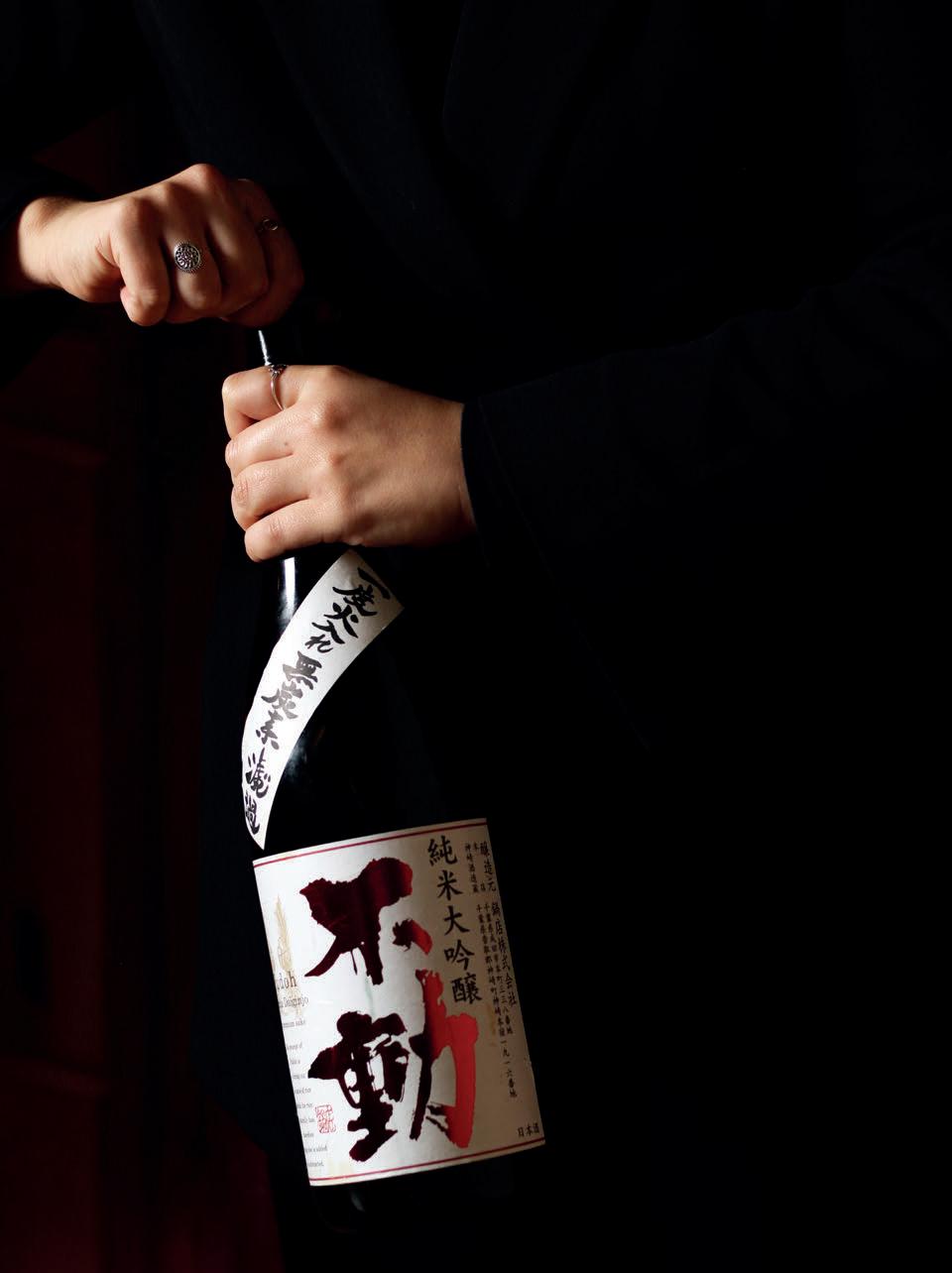
38

ALGO LLAMADO SOMETHING CALLED «BOOM»
BARCELONA
EL PERIODISTA Y ESCRITOR XAVI
AYÉN, en su libro Aquellos años del boom, definió de una manera muy arquetípica pero magistral el significado de «ese algo llamado boom»: «El boom, aunque algunos aún nieguen su existencia, no es cualquier cosa, sino muchas. Una amalgama apasionada y vital en la que todo se mezcla: es un estallido de buena literatura, un círculo cerrado de profundas amistades, un fenómeno internacional de multiplicación de lectores, una comunidad de intereses e ideales, un fecundo debate político y literario, salpicado de dramas personales y destellos de alegría y felicidad».
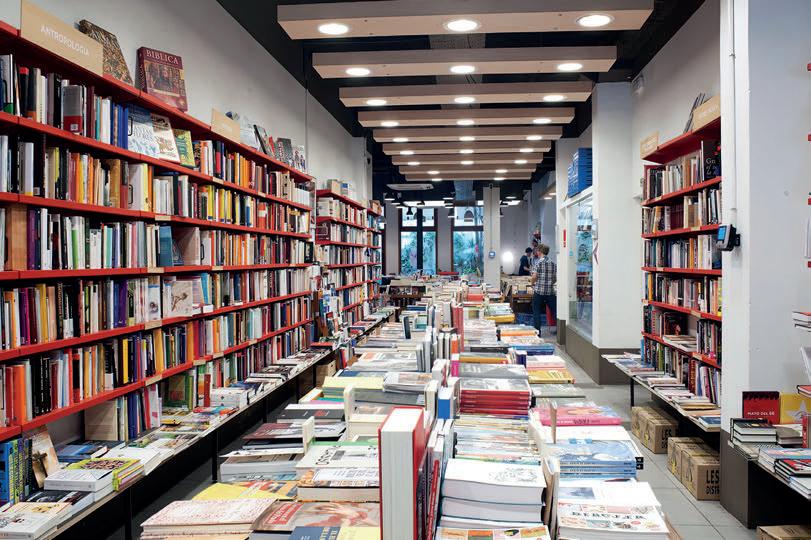
THE JOURNALIST AND WRITER
XAVI AYÉN , in his book Aquellos años del boom , defined in a very archetypal but masterful way the meaning of “that something called boom”: “The boom, although some still deny its existence, is not just anything, but many. A passionate and vital amalgam in which everything is mixed: it is a burst of good literature, a closed circle of deep friendships, an international phenomenon of multiplication of readers, a community of interests and ideals, a fertile political and literary debate, sprinkled with personal dramas and flashes of joy and happiness”.
40
Estamos hablando de un cuadro de insustituibles como Gabriel García Márquez, Mario Vargas Llosa, José Donoso, Jorge Edwards, Sergio Pitol, Nélida Piñon… y la «mamá grande» Carmen Balcells. Pero también del venezolano Rómulo Gallegos, Domingo Sarmiento, Rubén Darío, Miguel Ángel Asturias, Pablo Neruda, Alejo Carpentier, Ernesto Sábato, Juan Rulfo, Carlos Fuentes, Onetti, y aquellas figuras que aparecieron e la estela del boom; gente como Manuel Puig, Oscar Collazos, Cristina Peri Rossi, Néstor Sánchez...
Lo cierto es que, en aquellos años, finales de los 60, la calidad de las figuras literarias que paseaban por las calles de Barcelona no tenía parangón en Europa. Fue un foco de luz que irradiaba al mundo entero. De esos frutos surgieron librerías que son tan míticas como la propia esencia literaria de la ciudad.
EL CIRCUITO
La librería Byron tiene chimenea. El binomio libro-chimenea presenta una imagen tan bucólica que es imposible resistirse a entrar. En realidad, sus valientes dueños, también editores, apostaron por un entorno muy hogareño, un lugar ideal con encanto donde apetece ponerse a leer «como en casa». Tiene una sola planta en la que se colocan libros de pensamiento, ensayo, libros de bolsillo, cómics, juvenil, y una sala para actividades culturales y cafetería.
La Librería Documenta cuenta con un escaparate envidiable al modo de los antiguos colmados, se trata de una superficie de considerables dimensiones que se mantuvo como espacio artístico cuando la librería se reubicó en la calle Pau Claris, 144. Es una librería
We are talking about a cadre of irreplaceable figures such as Gabriel García Márquez, Mario Vargas Llosa, José Donoso, Jorge Edwards, Sergio Pitol, Nélida Piñon... and the “big mom” Carmen Balcells. But also the Venezuelan Rómulo Gallegos, Domingo Sarmiento, Rubén Darío, Miguel Ángel Asturias, Pablo Neruda, Alejo Carpentier, Ernesto Sábato, Juan Rulfo, Carlos Fuentes, Onetti, and those figures that appeared in the wake of the boom; people like Manuel Puig, Oscar Collazos, Cristina Peri Rossi, Néstor Sánchez...
The truth is that, in those years, at the end of the 60s, the quality of the literary figures that walked the streets of Barcelona was unparalleled in Europe. It was a light source that radiated to the whole world. From those fruits emerged bookstores that are as mythical as the very literary essence of the city.
THE CIRCUIT
The Byron bookstore has a fireplace. The book-fireplace binomial presents such a bucolic image that it is impossible to resist entering. In fact, its brave owners, who are also publishers, opted for a very homely environment, an ideal place with charm where you feel like reading “like at home”. It has only one floor where books of thought, essays, paperbacks, comics, juvenile books, and a room for cultural activities and a cafeteria are placed.
The Documenta Bookshop has an enviable shop window in the style of the old grocery stores, an area of considerable size that was maintained as an artistic space when the bookshop was relocated to 144 Pau Claris Street. It is a historic bookshop,

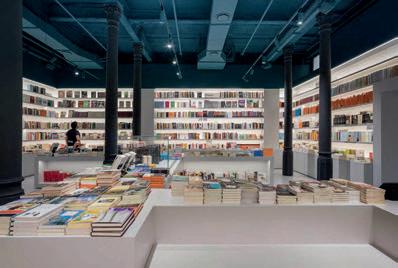
41
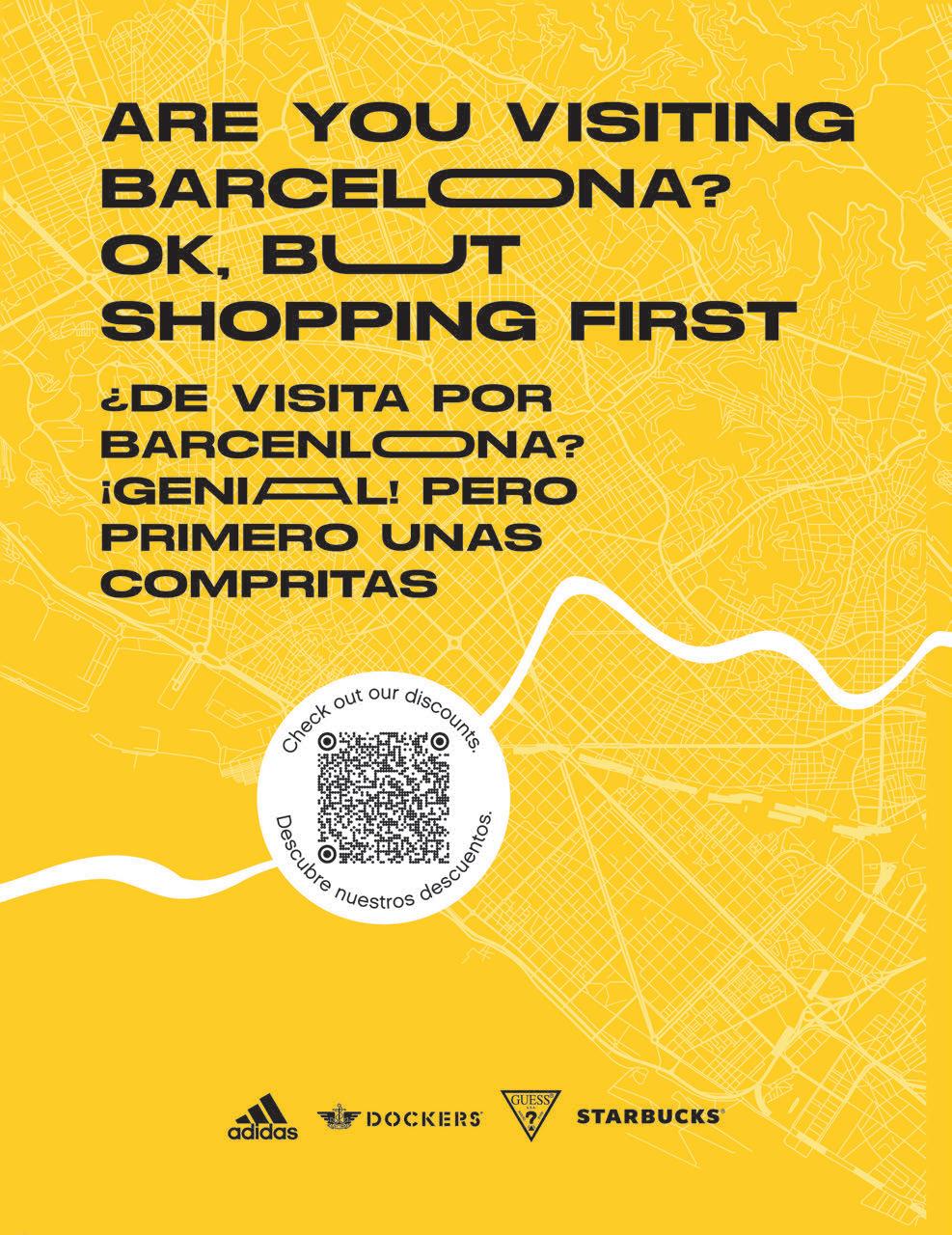

histórica, abrió en 1974 en pleno Gòtic. Uno de los rasgos de su personalidad es la capacidad de renovación y dinamismo continuo, que permite contemplar libros de fondo junto a novedades en un continuo fluir.
Ona es una librería especializada en literatura publicada exclusivamente en catalán con voluntad de espectáculo, de convertir la experiencia de comprar libros en una experiencia única. Con casi 1000 metros cuadrados, el impulso es meteórico por su singularidad y por la zona de actividades, cafetería y espacios únicos creados en torno al libro.
Laie es una librería histórica y protagonista de la vida cultural barcelonesa. Roberto Bolaño la menciona en Los Detectives Salvajes y 2666. También era una de las librerías favoritas de Juan Marsé. Fue revolucionaria y pionera porque fue la primera que montó una cafetería. Con más de 30.000 libros de fondo, entrar en Laie es como entrar en el templo de la sabiduría. Lo más importante es la narrativa, pero lo que hace a Laie una librería especial son las secciones de filosofía e historia.
La Central fue una auténtica revolución en los 90. Mantiene ese gusto antiguo, pero es un referente en mayúsculas de las librerías de Barcelona. Tiene predilección por el fondo humanístico, aunque en sus estanterías se encuentran todos los artes del saber.
Jaimes es otra de las librerías que vertebran la calle Pau Claris. Está especializada en literatura francesa y su apertura fue como un rayo de luz, por la sabiduría y buen consejo de los propietarios que funden el buen trato con el conocimiento lector.
opened in 1974 in the heart of the Gòtic. One of the features of its personality is its capacity for continuous renovation and dynamism, which allows to contemplate books in the background together with novelties in a continuous flow.
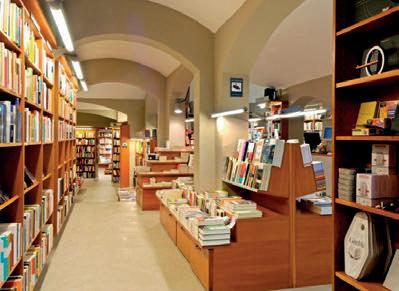
Ona is a bookshop specializing in literature published exclusively in Catalan with a desire for spectacle, to turn the experience of buying books into a unique experience. With almost 1000 square meters, the momentum is meteoric because of its uniqueness and the activities area, cafeteria and unique spaces created around the book.
Laie is a historic bookstore and a protagonist of Barcelona’s cultural life. Roberto Bolaño mentions it in Los Detectives Salvajes and 2666. It was also one of Juan Marsé’s favorite bookstores. It was revolutionary and pioneering because it was the first to set up a cafeteria. With more than 30,000 books in stock, entering Laie is like entering the temple of wisdom. The most important thing is the narrative, but what makes Laie a special bookstore are the philosophy and history sections.
La Central was a real revolution in the 1990s. It maintains that old taste, but it is a reference in capital letters of the bookstores in Barcelona. It has a predilection for the humanistic background, although its shelves contain all the arts of knowledge.
Jaimes is another one of the bookstores that vertebrate Pau Claris street. It specializes in French literature and its opening was like a ray of light, due to the wisdom and good advice of the owners, who combine good treatment with reading knowledge.

44

MADRID RÍO
EL NUEVO MADRID THE NEW MADRID
EL ENCLAVE DEL MANZANARES ofrece múltiples opciones para un día alternativo, un día para vivir en un medio natural rodeado de la gran ciudad. El enorme espacio lúdico y cultural paralelo al río que compone el área ha renaturalizado la zona para recuperar el cauce del río como escenario de un día heterogéneo, donde se puede disfrutar tanto de atracciones lúdicas, como de paseos en bici o andando, e instalaciones deportivas y culturales.
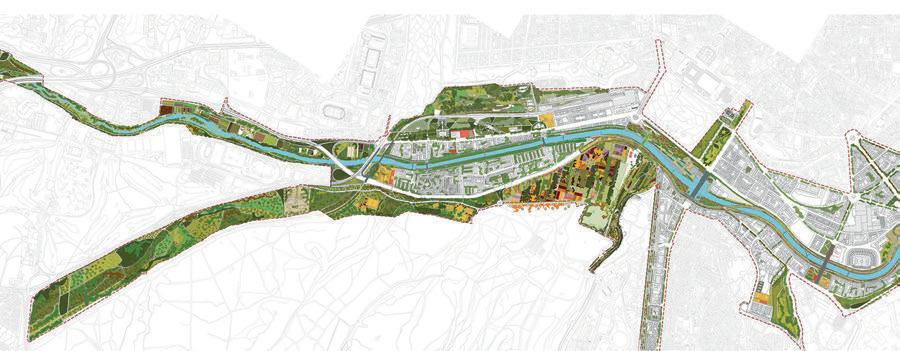
El ordenamiento de la ribera ofrece múltiples posibilidades para pasar un día en familia. Hay 17 áreas infantiles distribuidas por toda la zona donde los niños disfrutan de juegos infantiles a lo largo del Salón de los Pinos, con columpios adaptados y materiales sostenibles para mantener la integridad del espacio natural. Hay columpios de madera, de cáñamo, hamacas,
THE MANZANARES ENCLAVE offers multiple options for an alternative day out, a day to live in a natural environment surrounded by the big city. The huge leisure and cultural enclave parallel to the river that makes up the area has renaturalised the area and recovered the riverbed as a setting for a heterogeneous day out, where you can enjoy leisure attractions, bike rides, walks, sports areas and cultural facilities.
The arrangement of the riverbank offers multiple possibilities for a family day out. There are 17 children’s areas distributed throughout the area where children can enjoy playgrounds along the Salón de los Pinos, with adapted swings and sustainable materials to maintain the integrity of the natural space. There are wooden swings, hemp swings, hammocks, hanging bridges, lianas... all prepared for a day of adventure with the little ones.
46
puentes colgantes, lianas… todo preparado para vivir un día de aventura con los más peques.
Madrid Río tiene también espacios para todas las edades. Hay circuitos biosaludables, pistas de petanca, mesas de juegos y un Centro de Interpretación del río Manzanares para conocer esta ilustre joya natural que ha acompañado el devenir de la urbe.

La playa es la gran estrella del área. Está formada por tres recintos acuáticos ovalados con chorros de agua ideales para refrescarse en verano, rodeados de una amplia zona de descanso con hamacas. Una oportunidad para aquellos que dicen que lo único que le falta a Madrid es una playa.
Río es también un escenario para actividades culturales como exposiciones, festivales, teatro, danza… en el fantástico entorno de Matadero Madrid pasando por el puente monumental de Arganzuela o puente de Perrault.

Madrid Río also has spaces for all ages. There are bio-healthy circuits, petanque courts, games tables and a Manzanares River Interpretation Centre to get to know this illustrious natural jewel that has accompanied the development of the city.
The Madrid Río beach is the star of the area. It is made up of three oval water enclosures with water jets ideal for cooling off in summer, surrounded by a large rest area with deckchairs. An opportunity for those who say that the only thing Madrid lacks is a beach.
Rio is also a stage for cultural activities such as exhibitions, festivals, theatre, dance... in the fantastic surroundings of Matadero Madrid passing by the monumental bridge of Arganzuela or Perrault’s bridge.
In Madrid Río there is also the Explanada del Puente del Rey and the imposing Plaza Río 2 shop -
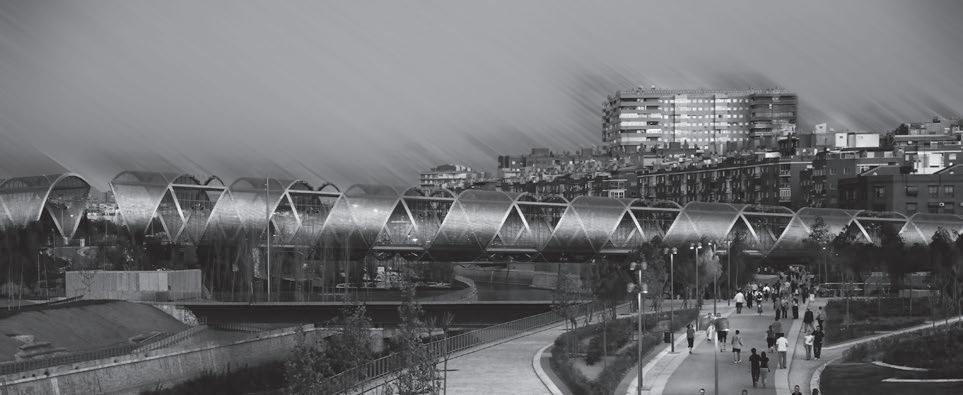
47
En Madrid Río está también la Explanada del Puente del Rey y el imponente Centro Comercial Plaza Río 2, donde pasar un excelente día de compras.
Acompasados por el discurrir del Manzanares, Madrid Río desemboca en el Parque Lineal, una zona de paseo y ocio diseñada por el arquitecto Ricardo Bofill, construida en 2003, en la que se pueden encontrar parques infantiles, zonas verdes, un anfiteatro, dos miradores (uno de ellos coronado por la escultura La Dama del Manzanares, de Manuel Valdés) y la Caja Mágica, el Centro de Tenis de Alto Rendimiento, diseñada por Dominique Perrault.
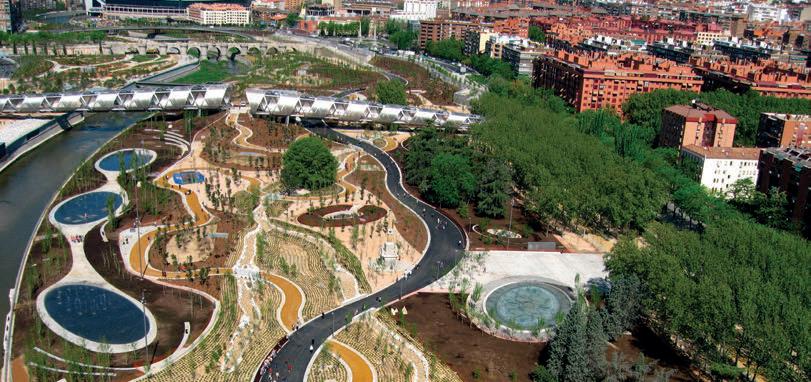
ping centre, where you can spend an excellent day shopping.
Accompanied by the flow of the Manzanares, Madrid Río flows into the Parque Lineal del Manzanares, an area for walking and leisure designed by the architect Ricardo Bofill, built in 2003, where you can find playgrounds, green areas, an amphitheatre, two viewpoints (one of them crowned by the sculpture La Dama del Manzanares, by Manuel Valdés) and the Caja Mágica, the High Performance Tennis Centre, designed by Dominique Perrault.
«MUY MATADERO» “VERY MATADERO”
MATADERO MADRID es la apuesta que le faltaba a una ciudad que vive arropada por las últimas tendencias. Como centro internacional de cultura y creación artística, el edificio es imponente, una realidad destinada a crear vida en un entorno ahora proyectado hacia la búsqueda de nuevos alicientes.
Las diferentes naves se articulan como un ser viviente que alberga la espectacularidad de unas cavidades que palpitan como células programadas: exposiciones, teatro, festivales, música en vivo, cine, proyectos audiovisuales, conferencias, conversaciones y talleres, residencias para artistas, programas educativos y actividades para familias.
MATADERO MADRID is the bet that was missing for a city that lives wrapped up in the latest trends. As an international center of culture and artistic creation, the building is imposing, a reality destined to create life in an environment now projected towards the search for new attractions.
The different halls are articulated like a living being that houses the spectacularity of cavities that pulsate like programmed cells: exhibitions, theater, festivals, live music, cinema, audiovisual projects, conferences, conversations and workshops, residencies for artists, educational programs and activities for families.
48
La actividad parece frenética, pero así es como se comporta un ser vivo, un ser que guarda en sus entrañas órganos que se interrelacionan para conformar una función. Cuando un nuevo proyecto artístico, de vanguardia, del nuevo milenio, recala en Madrid, se dice que es “muy matadero”, una expresión que ha cobrado una acepción única, un concepto que implica un adjetivo, un riesgo, un impacto. Esto es difícil de lograr. Y Matadero lo ha conseguido.
Matadero es el lugar donde refugiarte para disfrutar de la cultura en su estado más crudo, en el seno de la experimentación artística, en el fragor del debate y el intercambio de ideas, en la luz de las artes visuales, escénicas, performativas, ataviadas con el diseño, la literatura, la cultura digital o la arquitectura.
The activity seems frenetic, but this is how a living being behaves, a being that keeps in its entrails organs that interrelate to form a function. When a new artistic project, avant-garde, of the new millennium, arrives in Madrid, it is said to be “very slaughterhouse”, an expression that has taken on a unique meaning, a concept that implies an adjective, a risk, an impact. This is difficult to achieve. And Matadero has achieved it.
Matadero is the place to take refuge to enjoy culture in its rawest state, in the heart of artistic experimentation, in the heat of debate and exchange of ideas, in the light of visual, performing, performative arts, dressed with design, literature, digital culture or architecture.

El mayor espacio expositivo de Madrid
El matadero y mercado municipal de ganados de Madrid fue un conjunto de 48 edificios y 165.415 metros cuadrados dedicado a realizar funciones de matadero industrial y mercado de ganados en la ciudad de Madrid durante la mayor parte del siglo XX.

En 1996 se produjo la clausura definitiva del espacio dedicado a matadero y se calificó el recinto como bien catalogado. El 26 de septiembre de 2005 se inician las nuevas actuaciones para convertir el recinto en centro de apoyo a la creación.
El año 2011 pasa a la historia de Matadero Madrid como de su consolidación como espacio cultural de referencia en la ciudad. Se inaugura la Nave 16, el mayor espacio expositivo de Madrid y un lugar polivalente y flexible. Al mismo tiempo, se abre el nuevo acceso desde la plaza de Legazpi, y a su lado el antiguo depósito de aguas se convierte en el Depósito de Especies, un pequeño jardín que alberga todas aquellas plantas que a lo largo de la historia han colonizado Matadero Madrid.
The largest exhibition space in Madrid
The slaughterhouse and municipal livestock market of Madrid was a complex of 48 buildings and 165,415 square meters dedicated to performing the functions of industrial slaughterhouse and livestock market in the city of Madrid during most of the twentieth century.
In 1996 the slaughterhouse space was definitively closed and the site was classified as a listed property. On September 26, 2005, new actions were initiated to convert the site into a center to support creation.
The year 2011 goes down in the history of Matadero Madrid as one of its consolidation as a cultural space of reference in the city. Nave 16, the largest exhibition space in Madrid and a multipurpose and flexible place, was inaugurated. At the same time, the new access from Plaza de Legazpi is opened, and next to it the old water tank becomes the Deposit of Species, a small garden that houses all those plants that throughout history have colonized Matadero Madrid.
49
LONDRES LONDRES
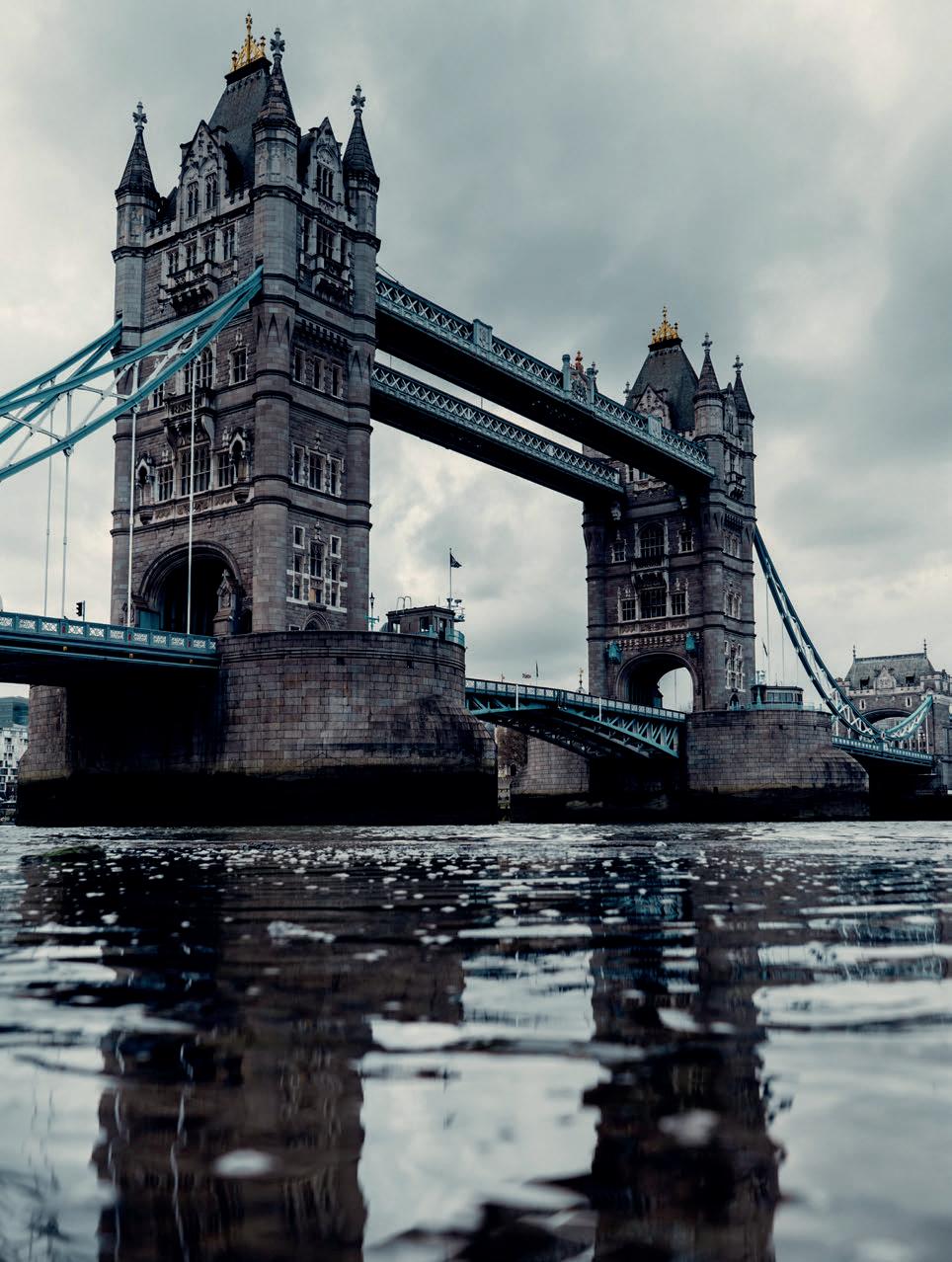
HACKNEY Y SHOREDITCH, TERRITORIO HIPSTER
LOS BARRIOS DE HACKNEY Y SHOREDITCH son de los más «cool» de la capital británica. Un territorio hípster por excelencia, y eso es mucho decir sobre una de las capitales del mundo que más tendencias irradia por minuto. Hackney es una de esas áreas que han surgido en Londres por efectos de la gentrificación; donde la clase media ha ido desplazando a los habitantes originarios y más humildes para conformar un reducto vibrante de arte y cultura.

No es difícil ver cómo los diseñadores más modernos se reúnen en el pabellón de vidrio del Spitalfields Market donde puedes comprar ropa y accesorios hechos a mano y de lo más creativo. Modelos únicos salidos de mentes muy imaginativas y solo para un cliente.
La zona de Brick Lane es una de los más brillantes del área, con un montón de tiendas vintage, galerías de arte y gente de lo más multifashion. Un poco como es Londres, pero en versión reconcentrada.
HACKNEY AND SHOREDITCH, HIPSTER TERRITORY
THE NEIGHBOURHOODS OF HACKNEY AND SHOREDITCH are some of the coolest in the British capital. Hipster territory par excellence, and that’s saying a lot about one of the world’s most trendy capitals by the minute. Hackney is one of those areas that have emerged in London as a result of gentrification; where the middle class has been displacing the original and more humble inhabitants to form a vibrant redoubt of art and culture.
It’s not hard to see how the hippest designers gather in the glass pavilion of Spitalfields Market where you can buy handmade and creative clothing and accessories. Unique designs from the most imaginative minds and only for one customer.
Brick Lane is one of the area’s brightest areas, with lots of vintage shops, art galleries and multi-fashionable people. It’s a bit like London, but in a re-concentrated version.
51
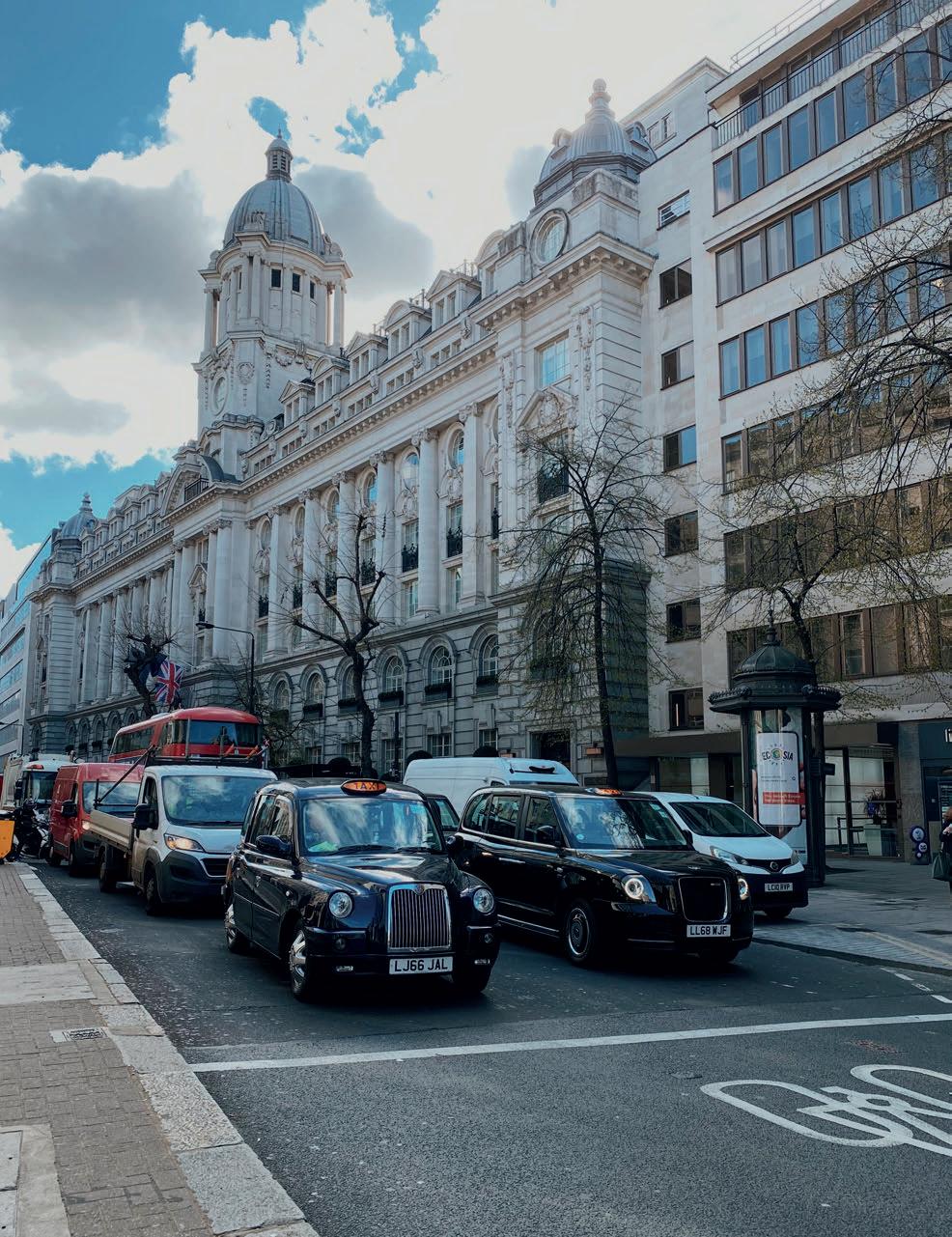
El pulso artístico lo marcan también los numerosos grafitis que se exponen en los lienzos de ladrillo que circundan el área. Son murales de colores intensos que irradian espíritu étnico, belleza y mensajes de lo más sugestivo.
Si te gusta la naturaleza, nada mejor que adentrarte en Victoria Park, el parque público más antiguo de Londres que se encuentra en Tower Hamlets, pero limita al norte con Hackney y abrió sus puertas en 1845.
En Dalston encontrarás panaderías elegantes, bares de cócteles llenos de vida, restaurantes y clubes de trotamundos. Si pudiera describirse en términos olfativos, todo el barrio destila olor a café, mezclado con muffins y pastelería de lo más apetitoso. En el extremo norte, en Westgate Street, las opciones de comida en la calle los sábados son deliciosas y aún más cosmopolitas, y puedes probar desde gofres hasta pollo katsu, pudines de Yorkshire y falafel.
No te pierdas el Empire, construido en 1901 y con un aroma a talento con poso de los años. Por su escenario han desfilado estrellas como Bill Hicks, John Cleese, Ben Elton, Russell Brand y Jack Whitehall.
De años remotos es la casa Tudor de Homerton High Street, que data de 1535, un edificio en el que pocos reparan y que sin embargo es la casa residencial más antigua de la ciudad. Fue construida por Ralph Sadler, el principal secretario de estado de Enrique VIII.
En el extremo sur de Mare Street hay un ambiente moderno, en parte gracias a la presencia del London College of Fashion; con muchos lugares apetecibles para obtener pho y bánh mì, por el legado de la comunidad vietnamita que se asentó a mediados de los setenta.
En Shoreditch, The Book Club ofrece muchas actividades y organiza eventos como clases de arte y manualidades, dibujos, charlas, salones literarios y noches con DJs de renombre. Lo mejor es ir en el momento del brunch y terminar en el club que tienen en el sótano.
The artistic pulse is also set by the numerous graffiti displayed on the brick canvases that surround the area. They are brightly coloured murals that radiate ethnic spirit, beauty and messages of the most suggestive kind.
If you’re a nature lover, there’s nothing better than a trip to Victoria Park, London’s oldest public park, which is located in Tower Hamlets but borders Hackney to the north and opened in 1845.
In Dalston you’ll find chic bakeries, lively cocktail bars, restaurants and globetrotting clubs galore. If it could be described in olfactory terms, the whole neighbourhood exudes the smell of coffee, mixed with muffins and mouth-watering pastries. At the northern end, on Westgate Street, the Saturday street food options are delicious and even more cosmopolitan, and you can sample everything from waffles to chicken katsu, Yorkshire puddings and falafel.
Don’t miss the Empire, built in 1901 and redolent with the aroma of ageing talent. Stars such as Bill Hicks, John Cleese, Ben Elton, Russell Brand and Jack Whitehall have graced its stage.
The Tudor house on Homerton High Street dates back to 1535, a building that few people notice, yet it is the oldest residential house in the city. It was built by Ralph Sadler, Henry VIII’s principal secretary of state.
At the south end of Mare Street there’s a hip atmosphere, thanks in part to the presence of the London College of Fashion; with plenty of tempting places to get pho and bánh mì, thanks to the legacy of the Vietnamese community that settled here in the mid1970s.
In Shoreditch, The Book Club offers many activities and hosts events such as art and craft classes, drawing, talks, literary salons and nights with top DJs. It’s best to go at brunch time and finish in the basement club.
53
EL ENCANTO DE MARYLEBONE
ES PARA MUCHOS el barrio más bonito de Londres, con sus mansiones y casonas del siglo XVIII que hacen retroceder a un tiempo histórico y al trote de los caballos y carruajes que componían esas bellas estampas londinenses.
El barrio es como un remanso de paz al lado de la vorágine de la súper ruidosa Oxford Street. A lo largo de sus arterias se extienden pequeños negocios, de esos que tienen alma propia, un toque que invita a descubrirlos y olvidarse de ir corriendo a las grandes cadenas que irrumpen en las vías comerciales. A lo largo de Marylebone High Street (considerada la joya escondida del West End de Londres), se ramifican pequeños callejones con encantadoras tiendas de moda, decoración, complementos o alimentación.
Estos callejones llamados «mews» son muy parecidos a los de Kensington, con sus pequeñas casitas de pueblito británico sin salir de Londres: Marylebone Mews, Gloucester Place Mews, Montagu Mews... Aunque se tenga la sensación de caminar por calles privadas, son públicas y perfectamente transitables. Como curiosidad, en Chagford Street nació la famosa marca de automóviles británica Bentley.
Otro efecto que produce el barrio es cuando se nombra la calle Baker Street, el lugar imaginado por Sir Arthur Conan Doyle para situar a su famoso personaje Sherlock Holmes. Al salir de la estación de Baker Street te topas de bruces con una estatua del mítico detective que nos recuerda la presencia que mantiene el personaje en la idiosincrasia londinense. Los más fanáticos, también pueden visitar el Sherlock Holmes Museum.
Sin duda el barrio es un lugar de leyendas. Además de las andanzas del icónico detective, los fans de los Beatles tienen una parada obligatoria en el número 34 de la Montagu Square. Aquí residieron en el año 1968 el famoso John Lennon y su polémica mujer Yoko Ono en las primeras fases de su relación. Y ya puestos a ver leyendas, otro de los iconos del barrio es el museo de cera Madame Tussauds, con una colección de esculturas de cera en constante crecimiento.
Los mercadillos son un pulmón de vidilla en todos los barrios londinenses. No podía ser diferente en Marylebone. El Farmers Market es uno de los más especiales. Está situado en Aybrook Street y abre todos los
THE CHARM OF MARYLEBONE
MARYLEBONE IS FOR MANY THE MOST beautiful district in London, with its 18th century mansions and mansions that take you back to a historic time and the trot of the horses and carriages that made up those beautiful London pictures.
The neighbourhood is like a haven of peace in the midst of the hustle and bustle of the noisy Oxford Street. Along its arteries are small shops, the kind that have a soul of their own, a touch that invites you to discover them and forget about rushing to the big chains that burst onto the main shopping streets. Along Marylebone High Street (considered the hidden gem of London’s West End), small alleyways branch out with charming shops selling fashion, decoration, accessories and food.
These “mews” alleys are very similar to those in Kensington, with their small British village houses without leaving London: Marylebone Mews, Gloucester Place Mews, Montagu Mews... Although you may have the feeling of walking through private streets, they are public and perfectly passable. As a curiosity, the famous British car brand Bentley was born in Chagford Street.
Another effect of the neighbourhood is when you name Baker Street, the place imagined by Sir Arthur Conan Doyle for the location of his famous character Sherlock Holmes. On leaving Baker Street station you come face to face with a statue of the legendary detective that reminds us of the character’s enduring presence in London’s idiosyncrasies. Fanatics can also visit the Sherlock Holmes Museum.
The neighbourhood is undoubtedly a place of legends. In addition to the wanderings of the iconic detective, Beatles fans have an obligatory stop at 34 Montagu Square. This is where the famous John Lennon and his controversial wife Yoko Ono lived in 1968 in the early stages of their relationship. And for legends, another of the neighbourhood’s icons is the Madame Tussauds wax museum, with an ever-growing collection of wax sculptures.
The flea markets are the lifeblood of all London’s neighbourhoods. Marylebone is no different. The Farmers Market is one of the most special. It is located in Aybrook Street and is open every Sunday
54
domingos de 10 de la mañana a 2 de la tarde. Es ideal para comprar verdura y fruta fresca.
Para empezar a ponerse a punto, nada mejor que un buen brunch en Caravan Fitzrovia. Situado en Great Portland Street, es uno de los más creativos de Londres para disfrutar de esa mezcla entre desayuno y comida que tanto les gusta a los ingleses.
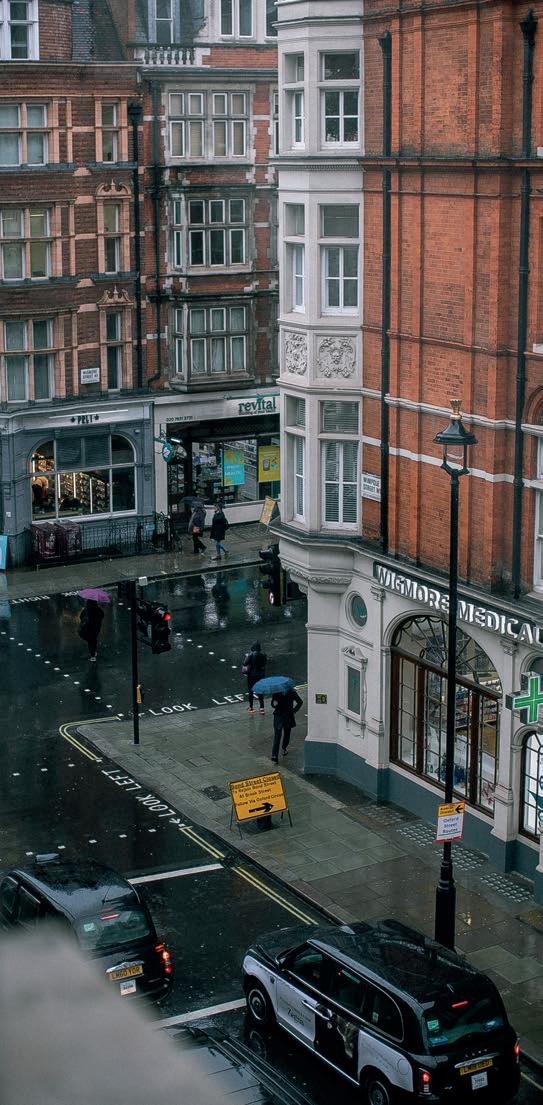
Si se piensa en comer, un lugar mítico es la antigua estación de bomberos, Chiltern Firehouse, que continúa en los rankings de favoritos pese a que fue abierto en 2014. Para hacer una visita con un poco de arte, no dudes en acercarte a Wallace Collection, una colección de pintura y artes aplicadas de los siglos XV al XIX situada en la mansión Hertford House.
Si quieres dar a la visita un toque único puedes recorrer la librería Daunt Books, donde además de libros, los autores se acercan para dar charlas y encuentros con los lectores.
from 10am to 2pm. It is ideal for fresh fruit and vegetables.
To get you started, there’s nothing better than a good brunch at Caravan Fitzrovia. Located on Great Portland Street, it is one of the most creative places in London to enjoy that mix of breakfast and lunch that the English love so much.
If you’re thinking of eating, a legendary place is the old fire station, Chiltern Firehouse, which is still in the rankings of favourites even though it was opened in 2014. For a visit with a bit of art, don’t hesitate to pop into the Wallace Collection, a collection of 15th to 19th century paintings and applied arts housed in Hertford House.
If you want to give your visit a unique touch, you can visit the Daunt Books bookshop, where in addition to books, authors come to give talks and meetings with readers.
55
PARIS
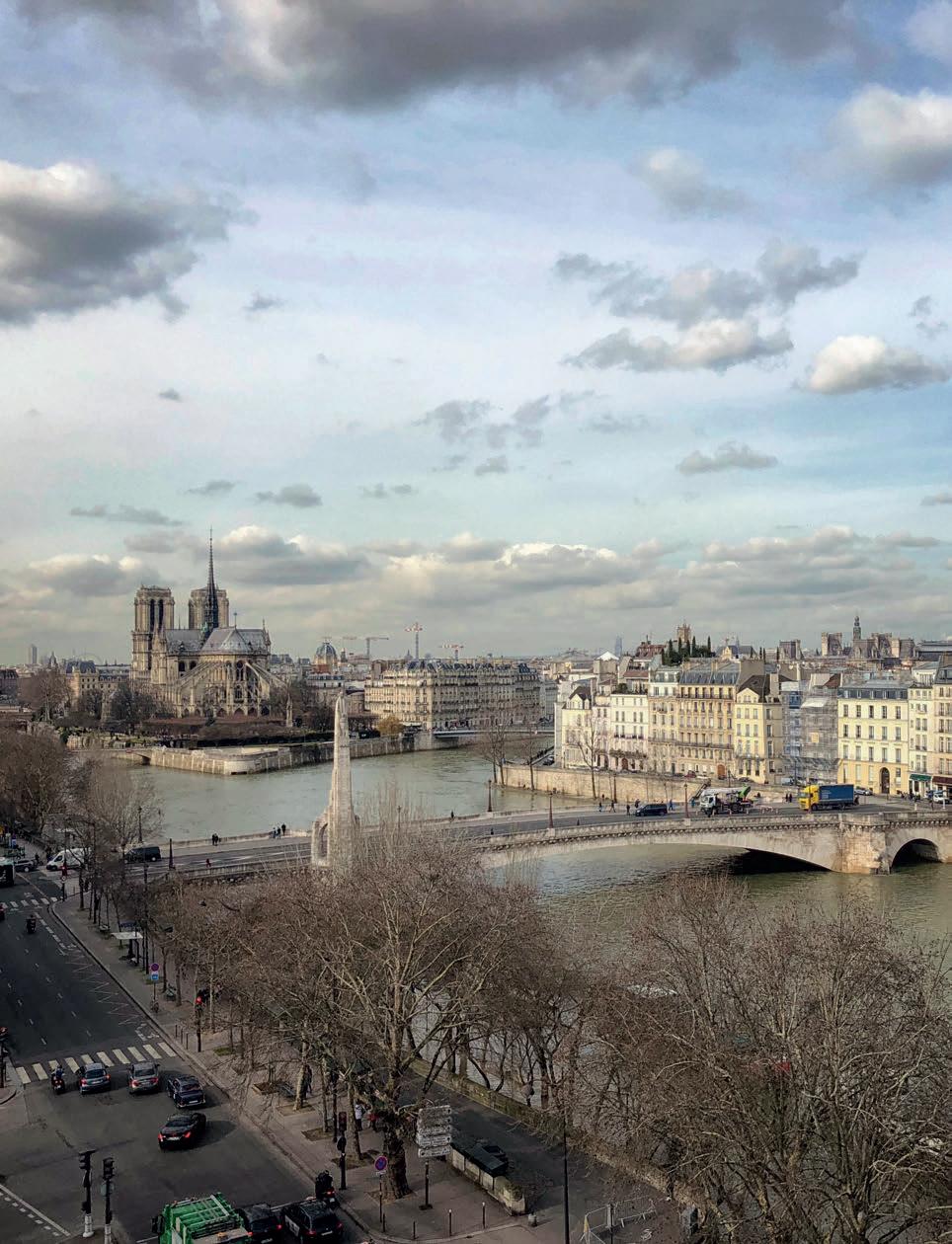
CANAL SAINT-MARTIN
DA IGUAL QUE EL TIEMPO NO ACOMPAÑE. El contraste de colores entre las pequeñas y encantadoras casas, con el espejo plateado del río merece como mínimo unos minutos de reposo para contemplar y disfrutar de las vistas.
La red de canales de la capital parisina fue construida a principios del siglo XIX y poco a poco ha ido convirtiéndose en una zona de recreo y esparcimiento. El Canal Saint-Martin se construyó por orden de Napoleón en el año 1825 para traer agua potable a la ciudad. Conserva algunos tramos subterráneos, pero sobre todo discurre al aire libre creando un entramado de puentes, esclusas y desniveles verdaderamente impresionantes.
Si además eres devoto de la película Amélie, de Jean-Pierre Jeunet, seguro que reconoces el canal, la pasarela de hierro y los muelles bajo los árboles de Saint-Martin.
A los parisinos les encanta sentir el frescor del agua y hacer un picnic al lado del río en un día soleado. Para eso, el canal Saint-Martin es un escenario perfecto porque conjuga el encanto ribereño con el colorido y el ambiente multicultural. Es imprescindible dejarse llevar por el ambiente que se respira en los pequeños bistrós y bares que adornan los dos lados del canal. En el jardín Villemin, hay una gran explanada de césped, un puesto de música y numerosos bancos, que resultan ideales para hacer un picnic entre jardines.
Sin duda una de las definiciones de este hermoso espacio es su carácter bohemio y artístico. Junto al canal abundan diseñadores franceses emergentes y de prestigio internacional.
En la rotonda de Stalingrad puedes alcanzar el gran estanque de la Villette. Los parisinos vienen aquí a jugar a la petanca, jugar al tenis de mesa, correr o hacer deporte al aire libre. Para bordear el estanque puedes hacerlo a pie o alquilar una barca a motor. En verano, el gran estanque forma parte de la iniciativa Playas de París y se llena de eventos e instalaciones temporales. Además, la Villette es uno de los estanques aptos al baño en los meses de verano.
En el corazón del parque de la Villette, la Ciudad de las Ciencias y la Industria de París no pasa desapercibida gracias a su imponente arquitectura en hormigón y a sus contrastes entre vidrio, agua y volumen de sus elementos.
CANAL SAINT-MARTIN
IT DOESN’T MATTER IF THE WEATHER IS BAD. The contrast of colors between the small and charming houses, with the silvery mirror of the river deserves at least a few minutes of rest to contemplate and enjoy the view.
The network of canals of the Parisian capital was built in the early nineteenth century and has gradually become an area of recreation and leisure. The Canal Saint-Martin was built by order of Napoleon in 1825 to bring drinking water to the city. It preserves some subway sections, but above all it runs in the open air creating a network of bridges, locks and truly impressive slopes.
If you are also a fan of Jean-Pierre Jeunet’s film Amélie, you will surely recognize the canal, the iron footbridge and the piers under the trees of Saint-Martin.
Parisians love to feel the coolness of the water and have a picnic by the river on a sunny day. For that, the Canal Saint-Martin is a perfect setting because it combines riverside charm with a colorful and multicultural atmosphere. It is essential to let yourself be carried away by the atmosphere in the small bistros and bars that adorn the two sides of the canal. In the Villemin garden, there is a large grassy esplanade, a bandstand and numerous benches, ideal for a picnic between gardens.
Undoubtedly one of the definitions of this beautiful space is its bohemian and artistic character. Along the canal, emerging French designers of international prestige abound.
At the Stalingrad traffic circle you can reach the large pond of La Villette. Parisians come here to play petanque, play table tennis, jog or play sports outdoors. To go around the pond you can do it on foot or rent a motor boat. In summer, the large pond is part of the Paris Beaches initiative and is filled with events and temporary installations. In addition, the Villette is one of the ponds suitable for swimming in the summer months.
At the heart of the Parc de la Villette, the Cité des Sciences et de l’Industrie de Paris does not go unnoticed thanks to its imposing concrete architecture and its contrasts between glass, water and volume of its elements.
57
LE MARAIS
Adentrándose en las pequeñas calles empedradas de este encantador barrio, puede olerse el dulce aroma de las crepes y los croissants, mezclado con las mil especias que desprenden los falafels de los restaurantes árabes.
Los callejones otorgan un aspecto muy coqueto, sobre todo porque a cada paso puede descubrirse una inagotable colección de cafeterías, bares y boutiques de múltiples opciones y gustos. Le Marais es un precioso oasis en medio de París, lleno de color y buen ambiente.
Fue uno de los barrios judíos de la ciudad y como testigo, el Passage de l’Ancre, de tapiz adoquinado, muestra los rincones ocultos donde se escondían los civiles durante la Segunda Guerra Mundial.
Pero no solo alberga historia reciente, Le Marais posee una historia muy antigua, por ejemplo, la Place des Vosges es la más vieja de la capital, y la tienda Pep’s
LE MARAIS
Entering the small cobblestone streets of this charming neighborhood, you can smell the sweet aroma of crepes and croissants, mixed with the thousand spices given off by the falafels of Arab restaurants.
The alleys give a very coquettish aspect, especially because at every step you can discover an inexhaustible collection of cafes, bars and boutiques with multiple options and tastes. Le Marais is a beautiful oasis in the middle of Paris, full of color and good atmosphere.

It was one of the Jewish quarters of the city and as a witness, the Passage de l’Ancre, cobblestone tapestry, shows the hidden corners where civilians hid during World War II.
But it is not only home to recent history, Le Marais has a very old history, for example, the Place des Vosges is the oldest in the capital, and Pep’s store
58
se jacta de ser la tienda de reparación de paraguas más antigua de París.
Tras la construcción de la Plaza des Vosges, los nobles y aristócratas comenzaron a mudarse al barrio y construyeron los impresionantes palacetes y mansiones que hoy se pueden ver en el barrio. Durante la Revolución Francesa la nobleza se vio obligada a abandonar sus hogares que fueron ocupados por comerciantes y artesanos, quienes imprimieron otro aire, pero mantuvieron la esencia.
Si te gusta hacer people watching la Place Des Vosges es uno de los lugares más populares para contemplar el trajín y las idas y venidas de todo tipo de personas y culturas.
Si eres amante de las artes, en el número 6 de la Place des Vosges puedes visitar la Casa de Víctor Hugo y en la Rue de Thorigny 5, conocer el Museo de Picasso en París.
La Rue des Rosiers y la Rue des Écouffes es el centro de la antigua comunidad judía de París, donde encontrarás lugares para comer los imperdibles shawarmas y los sandwiches de pastrami. Y como en París no hay barrio que no tenga mercadillo, puedes comer muy rico e informal en el mercadillo Marché des Enfants Rouges, el mercado de comida cubierto más antiguo de París.
El shopping puedes practicarlo en las calles comerciales Rue des Francs-Bourgeois y la Rue Vieille du Temple, donde encontrarás ropa para todos los gustos con ese especial chic francés.
Le Marais es también famoso por ser uno de los barrios gay más populares de Francia con bares y clubes para divertirte cada noche.
boasts of being the oldest umbrella repair store in Paris.
After the construction of the Place des Vosges, nobles and aristocrats began to move into the neighborhood and built the impressive palaces and mansions that can be seen in the neighborhood today. During the French Revolution the nobility was forced to leave their homes which were occupied by merchants and artisans, who printed another air, but kept the essence.
If you like people watching the Place Des Vosges is one of the most popular places to contemplate the bustle and comings and goings of all kinds of people and cultures.
If you are a lover of the arts, at number 6 Place des Vosges you can visit the House of Victor Hugo and at Rue de Thorigny 5, visit the Picasso Museum in Paris.
Rue des Rosiers and Rue des Écouffes is the center of the old Jewish community in Paris, where you will find places to eat the unmissable shawarmas and pastrami sandwiches. And as there is no neighborhood in Paris that does not have a flea market, you can eat very tasty and informal food at the Marché des Enfants Rouges, the oldest covered food market in Paris.
Shopping can be practiced in the shopping streets
Rue des Francs-Bourgeois and Rue Vieille du Temple, where you will find clothes for all tastes with that special French chic.
Le Marais is also famous for being one of the most popular gay neighborhoods in France with bars and clubs to have fun every night.
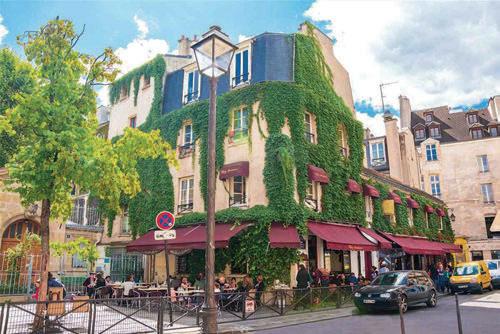
59
CHILLOUT EL IS COMING HOME
SE INSTALA EN CASA
EL CHILL OUT PUEDE parecer un término “archimanido”. A estas alturas hay poco que inventar. Se vive en la ola de las tendencias. Pero una cosa está clara: el interés por convertir el hogar en un mini paraíso cobra cada día más adeptos. Te guste o no recibir amigos en casa, lo cierto es que tener un pequeño rinconcito donde descansar se ha convertido en un asunto crucial para descomprimir de la vorágine diaria.
Es, en este tema, donde la palabra chill out adquiere su sentido. Como tal, el término significa literalmente descansar. Es por tanto un espacio para el relax.
Para lograrlo, hay algunos trucos infalibles. El primero, utilizar solo colores neutros: blanco, beige, gris o negro y que uno de ellos predomine sobre los otros. Será en los complementos donde puedas aplicar el contraste visual: almohadas con estampados o en colores intensos que destacan sobre la tranquilidad que desprenden los colores naturales.
CHILL OUT MAY SEEM LIKE an “old-fashioned” term. At this point there is little to invent. It is living on the wave of trends. But one thing is clear: the interest in turning the home into a mini paradise is gaining more and more followers every day. Whether you like having friends over or not, the fact is that having a little corner in which to relax has become a crucial issue to decompress from the daily hustle and bustle.
This is where the word chill out comes into its own. As such, the word literally means to rest. It is therefore a space for relaxation.
To achieve this, there are a few key tricks. The first is to use only neutral colours: white, beige, grey or black, with one of them predominating over the others. It is in the accessories that you can apply the visual contrast: patterned pillows or pillows in intense colours that stand out against the tranquillity of the natural colours.
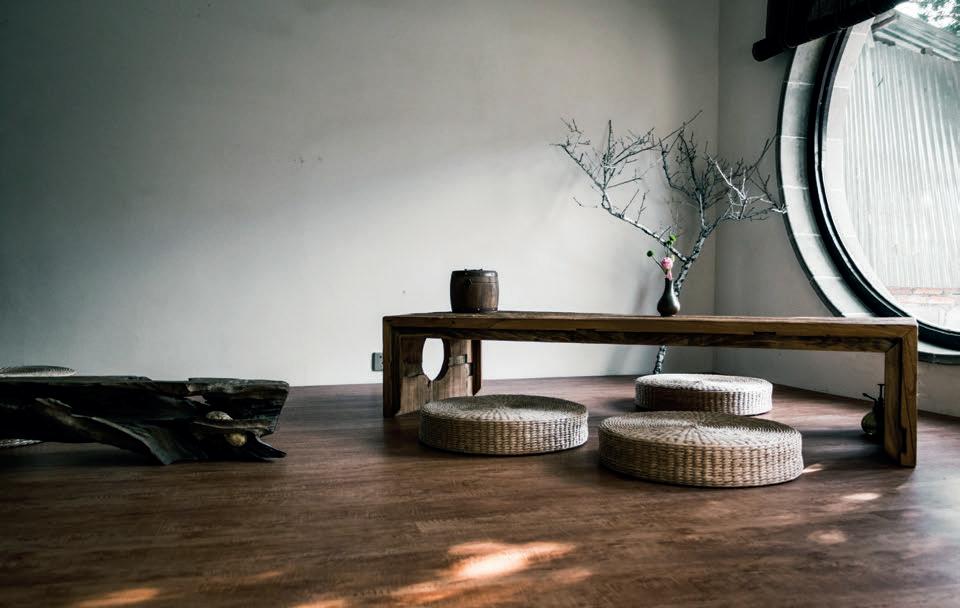
60
La iluminación debe ser siempre cálida. Es importante tener un punto de iluminación de mesa o de pie si se quiere dar calidez al espacio. Las velas de distintos tamaños son increíbles o incluso las guirnaldas o leds.
Vamos con el mobiliario. Para un chill out exterior, deben escogerse piezas que soporten las condiciones meteorológicas: madera, metal, vidrio, mármol, que bien combinado y en su justa medida, pueden dar un toque elegante.
Para la decoración, hay un elemento fundamental: los cojines y puffs. Ahí es donde se puede aplicar el toque de color que contraste con la calma de los colores neutros. Por supuesto, las alfombras solo pueden ser de colores naturales y de rafia.
Para lograr un buen chill out hay que contar con la naturaleza. Puedes poner plantas que den un toque definitivo, bien como un jardín lateral en la pared, o bien en diferentes puntos con macetas de colores tierra.
La guinda del espacio es la decoración. Aquí se aplica la máxima: menos, es más. No abuses de los adornos, resultan sobrecogedores y pueden romper la armonía. Quizás un gran jarrón de tonos arcillosos o una gran maceta. Pero si el espacio es pequeño, huye de ellos. Recuerda que un espacio chill out se crea en casa para descansar, para tranquilizar la mente y disfrutar de la relajación.
The lighting should always be warm. It is important to have a table or floor lamp if you want to give warmth to the space. Candles of different sizes are amazing or even garlands or LEDs.
Let’s go with the furniture. For an outdoor chill out, you should choose pieces that can withstand the weather conditions: wood, metal, glass, marble, that well combined and in the right measure, can give an elegant touch.
For decoration, there is a fundamental element: cushions and pouffes. This is where you can apply a touch of colour that contrasts with the calm of the neutral colours. Of course, rugs can only be in natural colours and made of raffia.
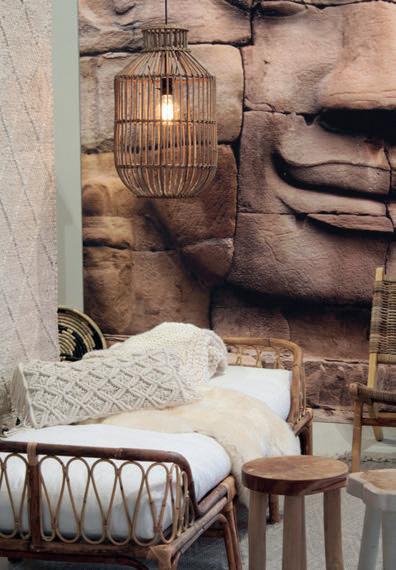

To achieve a good chill out, you have to rely on nature. You can put plants to give a definitive touch, either as a side garden on the wall, or in different spots with earth-coloured pots.
The icing on the cake is the decoration. Here the maxim applies: less is more. Don’t overdo it with ornaments, they are overwhelming and can break the harmony. Perhaps a large vase in earthy tones or a large flower pot. But if the space is small, avoid them. Remember that a chill out space is created at home to rest, to calm the mind and enjoy relaxation.
61
EL DEPORTE
QUE TE CAMBIARÁ LA MENTE
THE SPORT THAT WILL CHANGE YOUR MIND
TODOS LOS AÑOS comienzan con un propósito de enmienda. Entre ellos, nunca falta el de practicar deporte. A estas alturas, está más que claro que el ejercicio es fuente de salud y el principio de una buena amistad con nuestro propio cuerpo.
E
VERY YEAR begins with a resolution to make amends. Among them, there is always the resolution to practise sport. By now, it is more than clear that exercise is a source of health and the beginning of a good friendship with our own body.

Ahora bien, hay que decidir qué tipo de deporte nos conviene más: Los clásicos como la natación, cross, ciclismo, aeróbic, yoga; los clásicos remasterizados, como el aquagym, running, spinning, fitnes; y la última tendencia: los deportes que nacen de la perfección, del estudio anatómico y de la psicología, del principio del mens sana in corpore sano.
Como en todo, hay que saber manejar las modas. Ahora, más que nunca, se vive la era del enfoque holístico: una combinación de entrenamientos emocionales y musculares que se mezclan entre sí para fundir el deporte en una experiencia que traspasa lo exclusivamente físico y trasciende al cambio interior.
Una práctica bastante en alza es el bodyweight training, que consiste en entrenar utilizando solo tu propio peso sin ayuda externa de pesas o máquinas. Para ello, se emplea la fuerza de la gravedad y la resistencia del cuerpo. Flexiones, suspensiones y equilibrios, pero siempre con tus kilos como ayuda. Mejorarás tu fuerza y te ayudará a ser más flexible y, por supuesto, quemarás calorías al mismo tiempo.
La bicicleta es un deporte súper completo y si se combina con el agua, la mezcla es increíble. El aqua spinning añade a una sesión de spinning normal, la resistencia cardiovascular al pedalear bajo el agua.
El yoga nunca pasa de moda. Pues bien, incluso una práctica milenaria, se rinde a las tendencias. El fly yoga combina los movimientos habituales que todo yogui domina, pero los mezcla con gimnasia y danza. El plato fuerte son las piruetas en el aire.
El boxcycling te da la oportunidad de mezclar dos deportes muy completos: la bici y el boxeo. Esta modalidad utiliza los golpes para tonificar los brazos y el abdomen y hace que las piernas no paren en ningún momento. Dos entrenamientos intensos en el tiempo de uno.
El aqua boxing te invita a boxear en la piscina. Tener el agua como contrincante incrementará la intensidad del trabajo y es una muy buena forma de poner a tono tus brazos.
However, we have to decide which type of sport suits us best: the classics such as swimming, cross country, cycling, aerobics, yoga; the classics remastered, such as aquagym, running, spinning, fitness; and the latest trend: sports born from perfection, from anatomical study and psychology, from the principle of mens sana in corpore sano.
As in everything else, you have to know how to deal with fashions. Now, more than ever, we are living in the era of the holistic approach: a combination of emotional and muscular workouts that blend together to merge sport into an experience that goes beyond the purely physical and transcends the inner change.
One practice that is on the rise is bodyweight training, which consists of training using only your own weight without the external help of weights or machines. This involves using the force of gravity and the body’s own resistance. Push-ups, suspensions and balancing, but always using your own weights to help you. You will improve your strength and become more flexible and, of course, burn calories at the same time.
Cycling is a super complete sport and if you combine it with water, the mix is incredible. Aqua spinning adds cardiovascular endurance to a normal spinning session by pedalling underwater.
Yoga never goes out of fashion. Well, even a practice that is thousands of years old is giving in to trends. Fly yoga combines the usual movements that every yogi has mastered, but mixes them with gymnastics and dance. The highlight is the pirouettes in the air.
Boxcycling gives you the opportunity to mix two very complete sports: cycling and boxing. This modality uses punches to tone your arms and abdomen and keeps your legs going at all times. Two intense workouts in the time of one.
Aqua boxing invites you to box in the pool. Having the water as your opponent will increase the intensity of the workout and is a great way to tone your arms.
63
A
SE LLEVA LO
SÍ DE ROTUNDO. Las tendencias obligan a empatizar con el medio ambiente, a formar parte de un planeta con el que todos colaboramos para su conservación. La madera, los tejidos naturales, las plantas, los materiales que imitan la arcilla, los colores terrosos, ocres, blancos y tejidos como el lino, la lana o el algodón son la gran tendencia de la decoración, incluso en invierno, cuando la luz invita a disfrutar de estancias más cálidas.
Hay como una especie de decálogo para que la casa adquiera una decoración natural. Vamos por partes. La primera regla es incluir la naturaleza en la decoración. No estamos hablando del estilo art decó, pero unos cuadros o láminas con hojas o algún jarrón con flores secas, te ayudará a sentir que la naturaleza forma parte de tu vida. La segunda regla es utilizar texturas naturales como el barro y la cerámica. La tercera, usar estampados vegetales; no hay nada que simbolice más la naturaleza que las flores o las hojas.
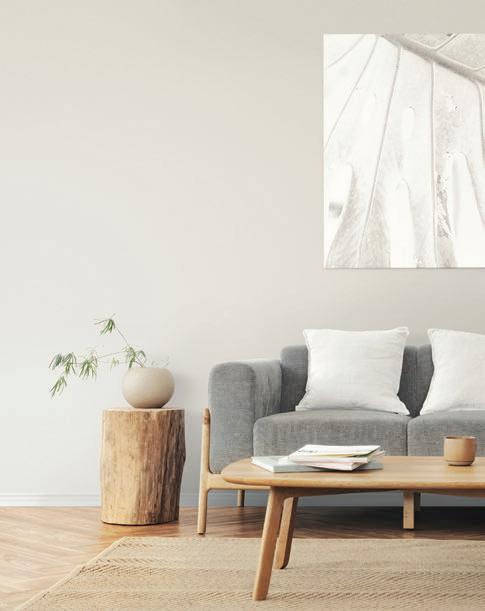
La madera es la cuarta regla por excelencia. Es una apuesta segura. Utiliza muebles de madera vista para la decoración, sin pinturas que la edulcoren. El quinto mandamiento es escoger tejidos naturales para las mantas, las cortinas, los plaids… y que no falte el lino y el algodón. Fundamental para lograr un toque natural.
La sexta regla es combinar diferentes texturas, pero siempre naturales. Apuesta por el lino y combínalo con madera, rafia, algodón y lana. La naturaleza es luz por eso la séptima regla es multiplicar la luz. Los colores claros potencian la luminosidad, hacen las estancias más cálidas y confortables. También un espejo puede ayudar a dar una sensación de amplitud.
Huye de las cortinas oscuras y opacas y sustitúyelas por telas semi transparentes y vaporosas. Si sigues esta regla permitirás que la luz natural inunde la estancia creando una sensación muy agradable. El octavo mandamiento va de colores. Usa la paleta cromática de la naturaleza: ocres, arenas, castaños… regalan armonía y relajación.
NATURAL
La novena regla consiste en incorporar fibras naturales en alfombras, sofás, sillones… la sensación es la de estar envuelta por un entorno natural. El décimo mandamiento es huir de los colores estridentes. Los fucsias, fosforescentes, brillantes… todos aquellos que impacten sobre el entorno de ocres deben mantenerse al margen.
64
T’S THAT CLEAR . Trends force us to empathise with the environment, to be part of a planet that we all collaborate with for its conservation. Wood, natural
NATURAL
IS IN I
fabrics, plants, materials that imitate clay, earthy, ochre and white colours and fabrics such as linen, wool and cotton are the big trend in decoration, even in winter, when the light invites us to enjoy warmer rooms.

There is a kind of decalogue for the house to acquire a natural decoration. Let’s take it one step at a time. The first rule is to include nature in the decoration. We are not talking about the art deco style, but a few pictures or sheets with leaves or a vase with dried flowers will help you to feel that nature is part of your life. The second rule is to use natural textures such as clay and ceramics. The third rule is to use plant prints; there is nothing that symbolises nature more than flowers or leaves.
Wood is the fourth rule par excellence. It is a safe bet. Use exposed wood furniture for decoration, without any paint to sweeten it. The fifth commandment is to choose natural fabrics for blankets, curtains, plaids... and linen and cotton. Fundamental to achieve a natural touch.
The sixth rule is to combine different textures, but always natural. Go for linen and combine it with wood, raffia, cotton and wool. Nature is light, so the seventh rule is to multiply light. Light colours enhance luminosity and make rooms warmer and more comfortable. A mirror can also help to give a feeling of spaciousness.
Avoid dark and opaque curtains and replace them with semi-transparent and vaporous fabrics. If you follow this rule you will allow natural light to flood the room creating a very pleasant sensation. The eighth commandment is about colours. Use the chromatic palette of nature: ochres, sands, browns... give harmony and relaxation.
The ninth rule is to incorporate natural fibres in carpets, sofas, armchairs... the sensation is that of being enveloped by a natural environment. The tenth commandment is to avoid strident colours. Fuchsia, phosphorescent, bright... all those that have an impact on the ochre surroundings should be kept out.
65
UN DETALLE QUE LO CAMBIA TODO A DETAIL THAT CHANGES EVERYTHING
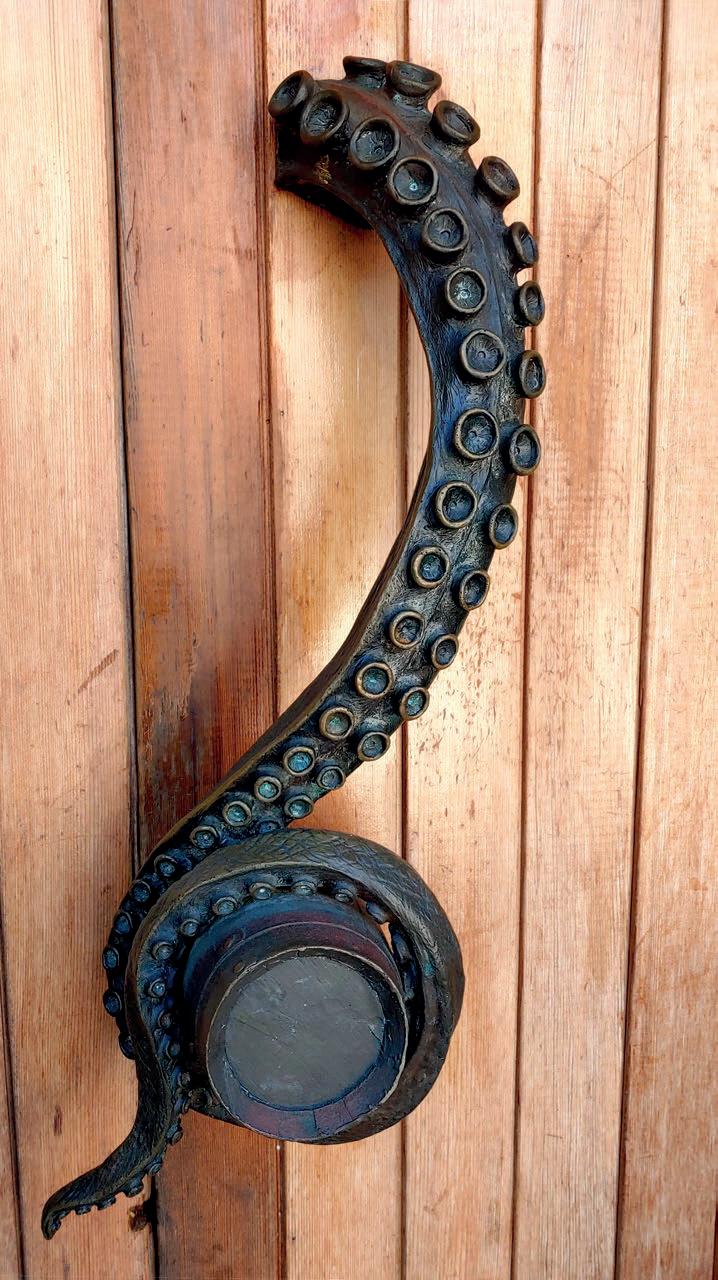
ESDE MUEBLES VIEJOS, a puertas que no acaban de convencer, alfombras, algún cuadro en un lugar estratégico… la decoración es un compendio de creaciones y sentimientos, donde la guinda recae a veces en un detalle insignificante.
Un detalle puede cambiar de manera radical la forma y la visión de un mueble o una estancia. Darle un giro a un mueble puede ser tan fácil como apostar por tiradores especiales. Un tirador, con un color intenso y rompedor, puede hacer que un mueble se convierta en un ele mento sofisticado. En los armarios de la cocina, un aparador, una vitrina, las mesillas o una cómoda, renovar los pomos de las puertas o cajones puede cambiar por completo la sensación que provoca una habitación.
También, unos nuevos pomos o tirado res en las puertas pueden realzar y poten ciar el estilo. Sobre los materiales, en las cocinas se recomienda huir de los diseños intrincados y optar por modelos sencillos. Para los armarios de la casa puedes arriesgar más y hacer combinaciones de colores extre mos; un punto de color y atrevimiento en una cómoda de madera envejecida es de lo más entrañable.
En el baño puedes apostar por las tendencias marineras. Conchas, caracoles, estrellas de mar, que funcionan a la perfección con tonos dorados o azules y color salmón.
Apostar por la sencillez y el estilo minimalista es una prueba de elegancia en los mue bles o estancias demasiado recargadas. Un simple tirador de metal, de bronce o incluso dorado es un acierto seguro.
Hay también elementos que inundan una estancia y que no estorban nada. Láminas con un sencillo marco de ma dera en un punto clave invitan a mirar sin sobrecargar la escena.
ROM OLD FURNITURE , to doors that don’t quite convince, carpets, a painting in a strategic place... decoration is a compendium of creations and feelings, where the icing on the cake sometimes falls on an insignificant detail.
A detail can radically change the shape and vision of a piece of furniture or a room. Turning a piece of furniture around can be as easy as opting for special handles. A handle, with an intense and striking colour, can turn a piece of furniture into a sophisticated element. On kitchen cupboards, a sideboard, a display cabinet, bedside tables or a chest of drawers, changing and renewing the door or drawer knobs can completely change the feel of a room.
Also, new door knobs or handles can enhance and enhance the style. Regarding materials, in kitchens it is recommended to avoid intricate designs and opt for simple models. For the cabinets in the house you can take more risks and make extreme colour combinations; a touch of colour and boldness in an aged wooden chest of drawers is very

In the bathroom, you can go for the seaside trend. Shells, snails, starfish, which work perfectly with gold or blue tones and salmon.
Opting for simplicity and minimalist style is a proof of elegance in overloaded furniture or rooms. A simple metal, bronze or even gold handle is a sure
There are also elements that flood a room and do not get in the way. Pictures with a simple wooden frame at a key point invite you to look at them without overloading the scene.
67
D
F
EL GENIO DE LA LUZ
TESLA NIKOLA
THE GENIUS OF LIGHT

E CUMPLEN 80 AÑOS de la muerte de Nikola Tesla, el genio que revolucionó la electricidad y con ella nuestro mundo. Hoy por hoy, el inventor ha adquirido esa aurea de mito no solo por su capacidad científica, sino por una personalidad claramente marcada por la idea altruista de que la ciencia debe contribuir al beneficio de la humanidad.
En una cadena de cafeterías hay una frase de Tesla colgada en un gran poster de vinilo. El aforismo brilla por su sensatez: «En realidad no me preocupa que quieran robar mis ideas, me preocupa que ellos no las tengan». La agudeza de la oración dice mucho de su personalidad, de su sacrificio por conseguir logros sin pedir nada a cambio.
El joven Tesla desarrolló desde niño una especial curiosidad por los efectos de la electricidad en la naturaleza. La indagación le llevó a los 17 años a la mejor escuela de ingeniería del momento: la Universidad Politécnica de Graz, en Austria, donde su padre le matriculó tras superar una grave enfermedad.
Ya como estudiante comenzó a evolucionar en sus conocimientos de una manera destacada, pero siempre con el trasfondo de intentar que la energía llegara de manera gratuita a todo el mundo. Tras pasar por París viajó hasta Nueva York en 1884, donde acudió a las oficinas del hombre que influiría profundamente en su vida: Thomas Alva Edison. Una curiosidad sobre este encuentro es la carta de recomendación que Tesla le entregó de Charles Batchelor, quien fuera su jefe en Europa, y que relataba: «Conozco a dos grandes hombres, y usted es uno de ellos. El otro es el joven portador de esta carta»
IT IS 80 YEARS since the death of Nikola Tesla, the genius who revolutionized electricity and with it our world. Today, the inventor has acquired the aura of myth not only because of his scientific ability, but also because of a personality clearly marked by the altruistic idea that science should contribute to the benefit of mankind.

In a chain of coffee shops there is a phrase of Tesla’s hanging on a large vinyl poster. The aphorism shines through in its wisdom: “I’m not really worried that they want to steal my ideas, I’m worried that they don’t have them.” The sharpness of the sentence speaks volumes about his personality, about his sacrifice to achieve without asking for anything in return.
The young Tesla developed as a child a special curiosity for the effects of electricity in nature. This curiosity led him at the age of 17 to the best engineering school of the time: the Polytechnic University of Graz in Austria, where his father enrolled him after overcoming a serious illness.
Already as a student he began to develop his knowledge in a remarkable way, but always with the background of trying to make energy available free of charge to everyone. After passing through Paris he traveled to New York in 1884, where he went to the offices of the man who would profoundly influence his life: Thomas Alva Edison. A curiosity about this meeting is the letter of recommendation that Tesla gave him from Charles Batchelor, who was his boss in Europe, which read: “I know two great men, and you are one of them. The other is the young man who is the bearer of this letter”.
69
S
Ese primer encuentro fue el fruto de una relación, pero no precisamente el principio de una gran amistad. Los lazos entre ellos fueron tensos y básicamente se distanciaron en lo siguiente: Edison defendía la corriente continua y Tesla la alterna, que es la que utilizamos en nuestros hogares actualmente. Este enfrentamiento entre los dos genios se denominó «la guerra de las corrientes».
El tiempo demostró que la idea de Tesla era mejor, pero Edison no estaba dispuesto a admitir su derrota y emprendió una campaña de difamación con la que pretendía alejar a Tesla del foco científico y ensombrecer su genialidad.
SIN EL NOBEL
Tras la rivalidad, Tesla decidió fundar su propia compañía en 1886. Sin embargo, los inversores no estaban demasiado conformes con los procedimientos y acabó abandonando la compañía. En 1887 construyó
That first meeting was the fruit of a relationship, but not exactly the beginning of a great friendship. The ties between them were strained and they basically diverged on the following points: Edison defended direct current and Tesla defended alternating current, which is what we use in our homes today. This confrontation between the two geniuses was called “the war of the currents”.
Time proved that Tesla’s idea was better, but Edison was unwilling to admit defeat and launched a smear campaign aimed at removing Tesla from the scientific spotlight and overshadowing his genius.

WITHOUT THE NOBEL PRIZE
Following the rivalry, Tesla decided to found his own company in 1886. However, investors were not too happy with the proceedings and he eventually left the company. In 1887 he built a brushless induc -
70
un motor de inducción sin escobillas, alimentado con corriente alterna, que presentó en el American Institute of Electrical Engineers (Instituto Americano de Ingenieros Eléctricos) en 1888. Ese mismo año desarrolló el principio de su bobina, y comenzó a trabajar con George Westinghouse en la Westinghouse Electric & Manufacturing Company’s en los laboratorios de Pittsburgh. Westinghouse fue el único que escuchó sus ideas y apostó por él y por la trasmisión de corriente alterna a larga distancia.
Pero Tesla no solo tuvo enfrentamientos con Edison, también su relación con Marconi quedaría para las curiosidades de la historia. Marconi ganó el premio Nobel en 1909 por el invento de la radio, aunque Tesla había patentado la idea en 1896. La oficina de patentes acabó otorgando a Marconi la patente del invento, probablemente por presiones económicas por parte de Marconi. Finalmente, en 1943 la Corte Suprema de Estados Unidos reconoció a Nikola Tesla, poco antes de su muerte, como el inventor de la radio y le devolvió la patente, que estuvo en poder de Marconi hasta ese momento.
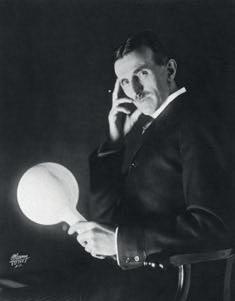
Tesla murió solo en una habitación de hotel en Nueva York, a los 86 años. A su funeral asistieron más de 2000 personas que lloraron la pérdida de un auténtico genio. El gobierno de Estados Unidos intervino su despacho y requisó todos los documentos, sin embargo, algunos no pudieron ser comprendidos ni descifrados porque Tesla guardaba la mayoría de sus ideas en la mente.
Tesla está considerado como uno de los grandes genios del siglo XX. Fue un inventor convencido de que la ciencia era un legado universal, por encima de cualquier interés económico o político. Fue un adelantado a su tiempo y un visionario al que la historia comienza ahora a hacer justicia.
tion motor, powered by alternating current, which he presented to the American Institute of Electrical Engineers in 1888. That same year he developed his coil principle, and began working with George Westinghouse at the Westinghouse Electric & Manufacturing Company’s Pittsburgh laboratories. Westinghouse was the only one who listened to his ideas and bet on him and on the transmission of alternating current over long distances.
But Tesla not only had clashes with Edison, also his relationship with Marconi would remain for the curiosities of history. Marconi won the Nobel Prize in 1909 for the invention of radio, although Tesla had patented the idea in 1896. The patent office eventually granted Marconi the patent for the invention, probably due to economic pressures from Marconi. Finally, in 1943 the U.S. Supreme Court recognized Nikola Tesla, shortly before his death, as the inventor of the radio and returned the patent, which had been held by Marconi until that time.
Tesla died alone in a hotel room in New York at the age of 86. His funeral was attended by more than 2,000 people who mourned the loss of a true genius. The U.S. government seized his office and confiscated all the documents, however, some of them could not be understood or deciphered because Tesla kept most of his ideas in his mind.
Tesla is considered one of the great geniuses of the 20th century. He was an inventor convinced that science was a universal legacy, above any economic or political interest. He was ahead of his time and a visionary to whom history is now beginning to do justice.
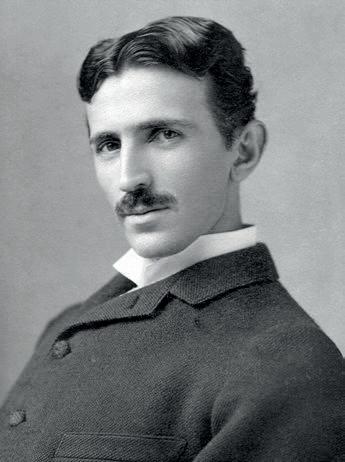
71
CINCO LUGARES IMPRESCINDIBLES DE MONGOLIA M
ONGOLIA ES SINÓNIMO DE AVENTURA. La tierra que unificó el gran guerrero y conquistador Genghis Khan posee más de un millón y medio de kilómetros cuadrados en los que poder perderse en medio de
FIVE MUST-SEE PLACES IN MONGOLIA
MONGOLIA IS SYNONYMOUS WITH ADVENTURE . The land that unified the great warrior and conqueror Genghis Khan has more than 1.5 million square kilometers in which to lose yourself

la diversidad de su paisaje. Desde altas montañas a vastos desiertos, pasando por grandes lagos y llanuras interminables. Un sinfín de escenarios que harán las delicias de los viajeros más ambiciosos. Situada en el continente asiático, justo en medio de las gigantes Rusia y China, Mongolia se presenta como un país extenso de naturaleza única y salvaje. Un pueblo cargado de historia cuyas costumbres y tradiciones continúan alejadas de occidente.
amidst the diversity of its landscape. From high mountains to vast deserts, through large lakes and endless plains. A myriad of scenarios that will delight the most ambitious travelers. Located on the Asian continent, right in the middle of the giants Russia and China, Mongolia presents itself as a vast country of unique and wild nature. A people steeped in history whose customs and traditions are still far removed from the West
ULÁN BATOR
Mongolia es uno de los países con menor densidad de población del mundo. De sus apenas tres millones de habitantes, en Ulán Bator, su capital, viven aproximadamente la mitad. El resto se distribuye en pequeñas poblaciones o se desplaza a través de sus regiones procurando su supervivencia y la de su ganado. Un 30 % de la población de Mongolia son nómadas.
Sin embargo, conviene pasar algunos días en esta gran ciudad para conocer sus lugares más míticos. Lugares como el monasterio budista de Gandantegchinli; la plaza principal de la capital, Sükhbaatar; o el Palacio de Invierno de Bogd.
ULAANBAATAR

Mongolia is one of the least densely populated countries in the world. Of its barely three million inhabitants, approximately half live in Ulaanbaatar, its capital. The rest are distributed in small villages or move around the regions in search of survival for themselves and their livestock. About 30% of Mongolia’s population are nomads.
However, it is worth spending a few days in this great city to see its most mythical places. Places like the Buddhist monastery of Gandantegchinli; the main square of the capital, Sükhbaatar; or the Winter Palace of Bogd.

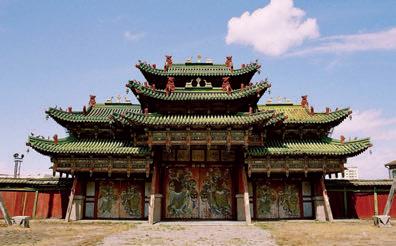
73
DESIERTO DE GOBI

El desierto de Gobi se extiende por la parte sur del país hasta las provincias del norte de China. Su extensión ocupa casi el 30 % del territorio mongol. Es uno de los desiertos más grandes del mundo y este se divide en cinco ecorregiones: la estepa oriental, la meseta de Ala Shan, la región del Valle de los Lagos, la cuenca Junggar y la cordillera de Tian Shan. En este mágico paraje podrás localizar muchas de las ciudades más importantes que tejen la red de la Ruta de la Seda.
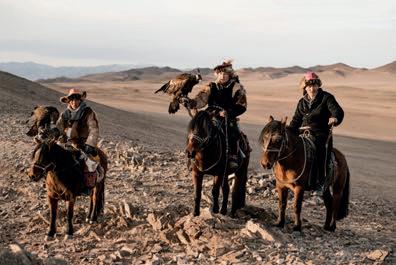
GOBI DESERT
The Gobi Desert stretches across the southern part of the country to the northern provinces of China. It covers almost 30% of Mongolian territory. It is one of the largest deserts in the world and is divided into five ecoregions: the Eastern Steppe, the Ala Shan Plateau, the Lake Valley region, the Junggar Basin and the Tian Shan Range. In this magical landscape you will be able to locate many of the most important cities that weave the Silk Road network.
COMPLEJO DE ESTATUAS
GENGHIS KHAN
A 54 km de Ulán Bator nos encontraremos la gigantesca estatua esculpida en honor al gran padre conquistador de Mongolia, Genghis Khan. Alzada sobre un enorme pedestal, la estatua, hecha de acero en su totalidad, alcanza 40 metros de altura y 250 toneladas de peso, convirtiéndose así, en la estatua ecuestre más grande del mundo.
GENGHIS KHAN
STATUE COMPLEX
At 54 km from Ulaanbaatar we will find the gigantic statue sculpted in honor of the great conquering father of Mongolia, Genghis Khan. Standing on a huge pedestal, the statue, made entirely of steel, is 40 meters high and weighs 250 tons, making it the largest equestrian statue in the world.

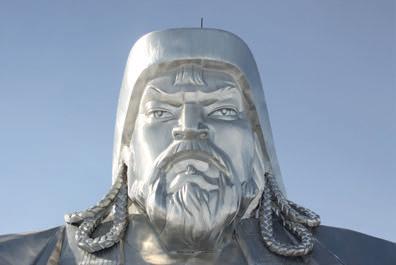
PARQUE NACIONAL
ALTAI TAVAN BOGD
Pocos lugares salvajes poseen una fuerza tan impresionante como el parque nacional Altai Tavan Bogd. Sus 200 km de extensión sirven de frontera natural entre China, Kazajstán, Rusia y Mongolia. Enormes montañas nevadas y varios glaciares llenan de agua los lagos que se encuentran a lo largo del parque, y estos a su vez proporcionan el caudal del río Hovd, uno de los más importantes del país.
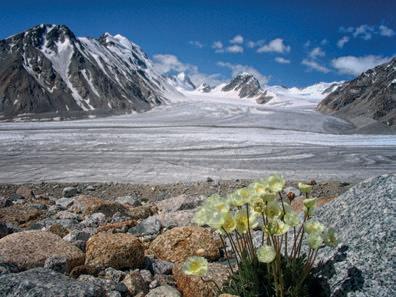
ALTAI TAVAN BOGD

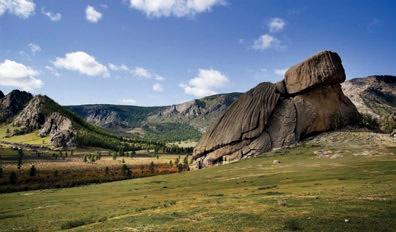
NATIONAL PARK
Few wild places possess such an impressive force as the Altai Tavan Bogd National Park. Its 200 km length serves as a natural border between China, Kazakhstan, Russia and Mongolia. Huge snowcapped mountains and several glaciers fill the lakes along the park with water, which in turn provide the flow of the Hovd River, one of the most important rivers in the country.
PARQUE NACIONAL
GORKHI-TERELJ
Muy cerca de la capital, a poco más de 40 km, encontramos uno de los paisajes naturales más fascinantes del mundo y, a su vez, uno de los lugares más populares y representativos de Mongolia. Situado a 1600 m de altura, el parque de Terelj ofrece una oportunidad única de desconectar del paisaje urbano repleto de grandes edificios que es Ulán Bator.
En sus cerca de 3000 km2 de extensión podrás disfrutar de la experiencia de compartir el modo de vida de los nómadas, conocer sus costumbres más tradicionales e incluso dormir dentro de sus yurtas
GORKHI-TERELJ
NATIONAL PARK
Very close to the capital, just over 40 km away, we find one of the most fascinating natural landscapes in the world and, at the same time, one of the most popular and representative places in Mongolia. Located at an altitude of 1600 m, Terelj Park offers a unique opportunity to disconnect from the urban landscape full of large buildings that is Ulaanbaatar.
In its nearly 3000 km 2 of extension you can enjoy the experience of sharing the nomads’ way of life, learn about their traditional customs and even sleep in their yurts.

75
LA RING ROAD
UNA VUELTA COMPLETA POR ISLANDIA
THE RING ROAD.
A COMPLETE TOUR OF ICELAND

TAMBIÉN CONOCIDA COMO CARRETERA 1, LA RING ROAD ES UNA CARRETERA DE CIRCUNVALACIÓN TOTALMENTE ASFALTADA QUE RODEA TODA LA ISLA. SUS MÁS DE 1300 KM DE LONGITUD LA CONVIERTEN EN LA CARRETERA MÁS LARGA E IMPORTANTE DE ISLANDIA. PERO NO ES SOLO UN RECORRIDO QUE CONECTA LOS PRINCIPALES NÚCLEOS URBANOS. LA RING ROAD SIRVE A SU VEZ COMO FANTÁSTICO ITINERARIO QUE ENLAZA UNO TRAS OTRO LOS DIFERENTES Y BELLOS PAISAJES QUE COMPONEN UNO DE LOS PAÍSES MÁS IMPRESIONANTES DEL MUNDO.
ALSO KNOWN AS HIGHWAY 1, THE RING ROAD IS A FULLY PAVED RING ROAD THAT CIRCLES THE ENTIRE ISLAND. ITS MORE THAN 1300 KM LENGTH MAKES IT THE LONGEST AND MOST IMPORTANT ROAD IN ICELAND. BUT IT IS NOT ONLY A ROUTE THAT CONNECTS THE MAIN URBAN CENTERS. THE RING ROAD ALSO SERVES AS A FANTASTIC ITINERARY THAT LINKS ONE AFTER THE OTHER THE DIFFERENT AND BEAUTIFUL LANDSCAPES THAT MAKE UP ONE OF THE MOST IMPRESSIVE COUNTRIES IN THE WORLD.
OMPLETAR TODO EL RECORRIDO significa terminar por donde se ha empezado, es decir, dar una vuelta completa a toda la isla. Es posible realizar dicho trayecto en 15 o 16 horas, dependiendo de la época del año. Pero no detenerse en los muchos lugares que irán apareciendo a lo largo del camino para degustar su imponente belleza, sería desperdiciar una oportunidad única de observar los distintos paisajes naturales con los que Islandia surte a todo viajero. Lo ideal es tomarse un mínimo de 10 días para recorrer la Ring Road. Haciendo paradas en algunas poblaciones y atracciones naturales para intentar no perderse nada de lo que nos ofrece la ruta de la carretera circular.
Durante todo el trayecto, siempre que el día esté despejado, podremos observar desde el vehículo enormes campos, granjas, montañas, glaciares, cascadas, lagos, playas y pintorescos pueblos. Reikiavik, capital y ciudad más poblada de Islandia, puede ser un buen punto de partida para iniciar el recorrido. De hecho, merecería mucho la pena visitar sus edificios, iglesias y museos, así como degustar su peculiar gastronomía en alguno de sus característicos restaurantes, antes de emprender el viaje.
TO COMPLETE THE ENTIRE ROUTE means to finish where you started, to go all the way around the island. It is possible to make such a journey in 15 to 16 hours, depending on the time of year. But not stopping in the many places that will appear along the way to taste its breathtaking beauty, would be wasting a unique opportunity to observe the different natural landscapes with which Iceland provides every traveler. The ideal is to take a minimum of 10 days to travel the Ring Road. Making stops in some towns and natural attractions to try not to miss anything that the Ring Road route has to offer.
Throughout the journey, as long as the day is clear, we will be able to see from the vehicle huge fields, farms, mountains, glaciers, waterfalls, lakes, beaches and picturesque villages. Reykjavik, Iceland’s capital and most populated city, can be a good starting point to begin the journey. In fact, it would be well worth visiting its buildings, churches and museums, as well as tasting its peculiar gastronomy in one of its characteristic restaurants, before embarking on the trip.
77 C
EL CÍRCULO DORADO
Desde la capital podemos comenzar el trayecto adentrándonos en la ruta conocida como el Círculo Dorado. Esta ruta es una de las más populares de la isla. Con un recorrido de 300 km, la ruta del Círculo Dorado ofrece un muestrario natural y salvaje de casi todo lo que podemos encontrar en Islandia. El Parque Nacional de Thingvellir, en el que se haya la grieta Almannagjá, lugar donde se encuentran las placas tectónicas de Eurasia y Norteamérica; el géiser Strokkur, con chorros de agua caliente y vapor a más de 30 metros de altura; o la cascada de Gullfoss, uno de los mejores lugares para ver auroras bo-
THE GOLDEN CIRCLE
From the capital we can begin the journey by entering the route known as the Golden Circle. This route is one of the most popular on the island. With a distance of 300 km, the route of the Golden Circle offers a natural and wild sample of almost everything we can find in Iceland. Thingvellir National Park, where the Almannagjá rift is located, where the tectonic plates of Eurasia and North America meet; the Strokkur geyser, with jets of hot water and steam more than 30 meters high; or the Gullfoss waterfall, one of the best places to see northern lights; are just
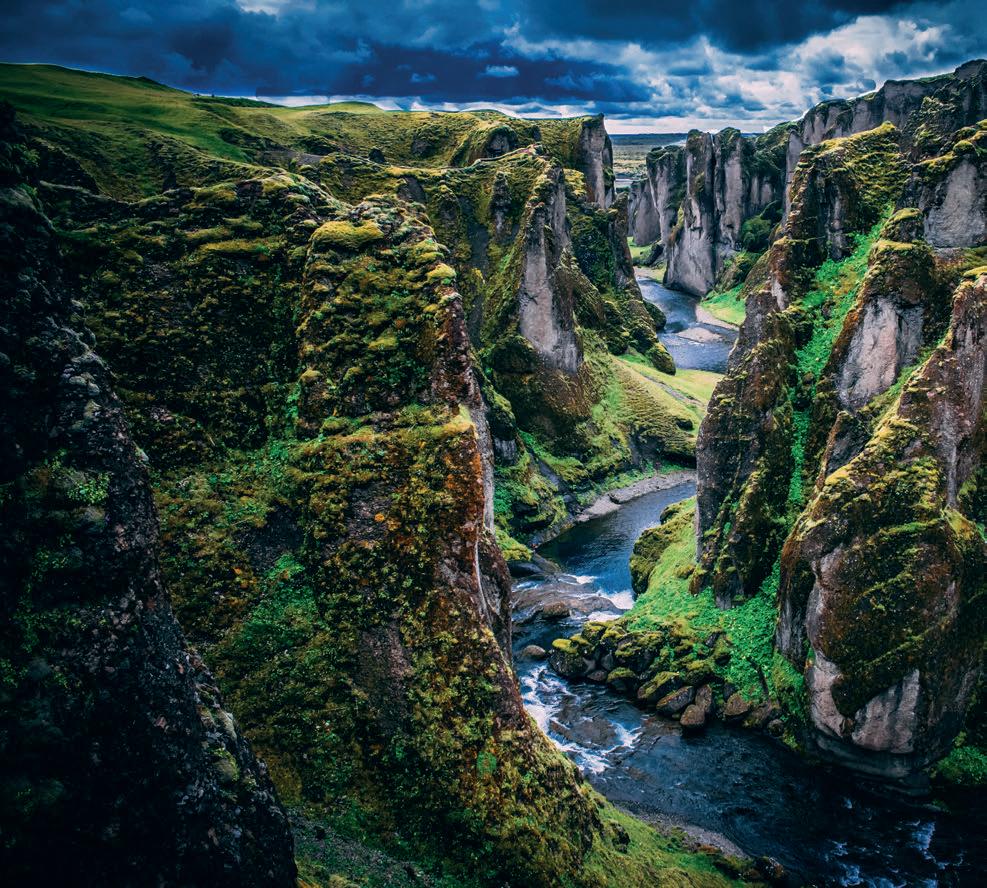
reales; son solo algunas localizaciones imprescindibles del Círculo Dorado y, a su vez, de la ruta de la Ring Road.

Si continuamos por la carretera, llegaremos a la cascada Seljalandsfoss. Una cascada con un salto de agua de 60 metros de altura perteneciente al curso del río Seljalands. Más adelante llegaremos a Reynisfjara, la playa negra de Islandia, donde se pueden apreciar las tres formaciones de basalto que sobresalen del nivel del mar. Su enorme tamaño, que ronda los 60 metros de altura, ha alimentado leyendas e historias entre los lugareños que identifican a estas formaciones rocosas como si fueran tres gigantes petrificados.
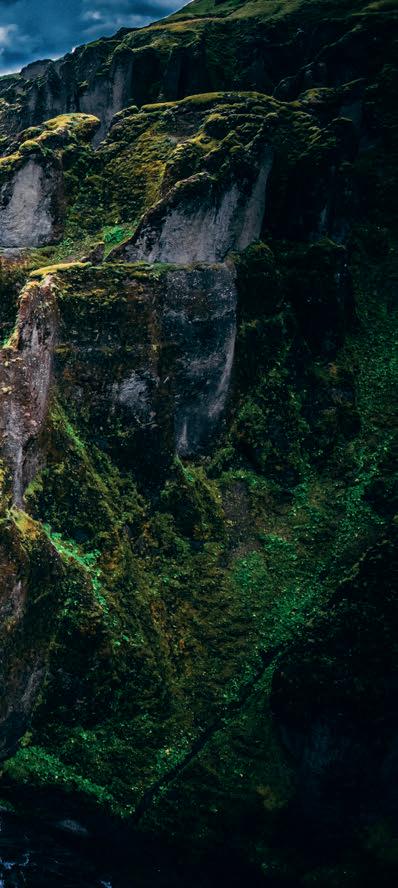
some of the essential locations of the Golden Circle and, in turn, of the Ring Road route.
If we continue along the road, we will reach the Seljalandsfoss waterfall. A waterfall with a waterfall of 60 meters high belonging to the course of the Seljalands River. Later we will arrive at Reynisfjara, the black beach of Iceland, where you can see the three basalt formations that protrude from sea level. Its enormous size, around 60 meters high, has fueled legends and stories among the locals who identify these rock formations as if they were three petrified giants.
A lo largo del camino, el viajero encontrará varios hoteles donde pernoctar y recargar energías para continuar la ruta a través de la Carretera 1. En muchos de estos hoteles, dependiendo una vez más de la época del año en la que nos movamos, podremos observar auroras boreales en el cielo. La mejor época para contemplar este maravilloso fenómeno es durante los meses que comprenden desde septiembre a abril.
También habrá momentos en los que debas abandonar la ruta, como por ejemplo para adentrarse en el mar. En Húsavík podrás contratar un tour para el avistamiento de ballenas. No es casualidad que a esta capital se le conozca como la capital de las ballenas. Ver de cerca la majestuosidad de estos imponentes animales será una experiencia muy difícil de olvidar. Las posibilidades de vislumbrar a dichos cetáceos son de casi un 100 % en la bahía de Skjálfandi.
La mayoría del trayecto se puede realizar de manera fácil y cómoda. Solo en determinadas ocasiones podremos encontrarnos con estrechamientos de la calzada o zonas un poco más complicadas para transitarlas, sobre todo, si nuestro vehículo no está adaptado a las peculiaridades del terreno y del clima. Para este recorrido, es muy recomendable usar un vehículo 4x4.
Along the way, the traveler will find several hotels where to stay overnight and recharge energies to continue the route along Highway 1. In many of these hotels, depending again on the time of the year in which we move, we will be able to observe aurora borealis in the sky. The best time to see this wonderful phenomenon is during the months from September to April.
There will also be times when you should leave the route, for example to go into the sea. In Húsavík you can hire a whale watching tour. It is no coincidence that this capital is known as the capital of whales. Seeing the majesty of these imposing animals up close will be a very difficult experience to forget. The chances of glimpsing these cetaceans are almost 100% in the bay of Skjálfandi.
Most of the journey can be done easily and comfortably. Only on certain occasions we may encounter narrowing of the road or areas a little more complicated to pass them, especially if our vehicle is not adapted to the peculiarities of the terrain and climate. For this route, it is highly recommended to use a 4x4 vehicle.
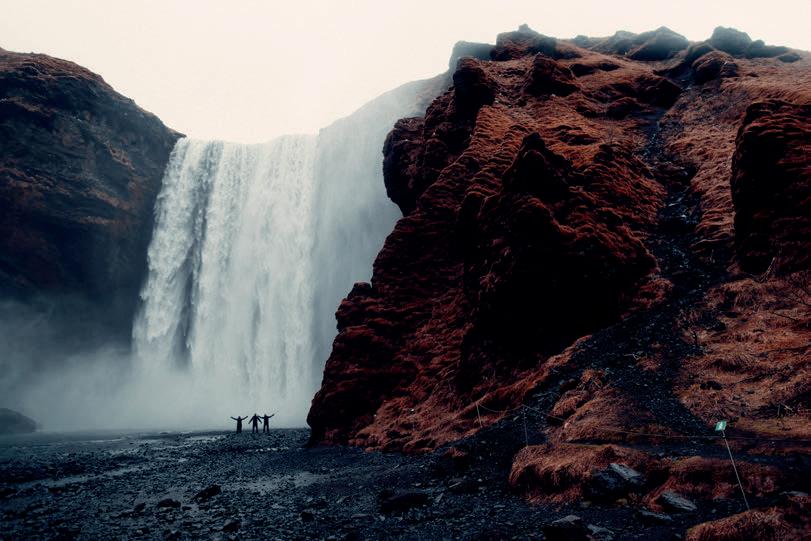
80
VUELTA A EMPEZAR
Como indicamos al principio, la Ring Road es una ruta circular. Lo que quiere decir que, mientras más te adentres, más cerca estarás de regresar al punto de partida. Absolutamente todo el recorrido es digno de observar y disfrutar. Si bien es cierto que hay algunos puntos clave, como los arriba indicados, que son paradas obligatorias para no perderse las maravillas que ofrece al viajero esta tierra de históricos asentamientos vikingos. La Ring Road es un recorrido fácil de realizar y muy completo.


BACK TO THE BEGINNING
As we indicated at the beginning, the Ring Road is a circular route. This means that the further you go in, the closer you will be to returning to the starting point. Absolutely the entire route is worth watching and enjoying. While it is true that there are some key points, such as those indicated above, which are mandatory stops not to miss the wonders offered to the traveler this land of historic Viking settlements. The Ring Road is an easy and very complete tour.
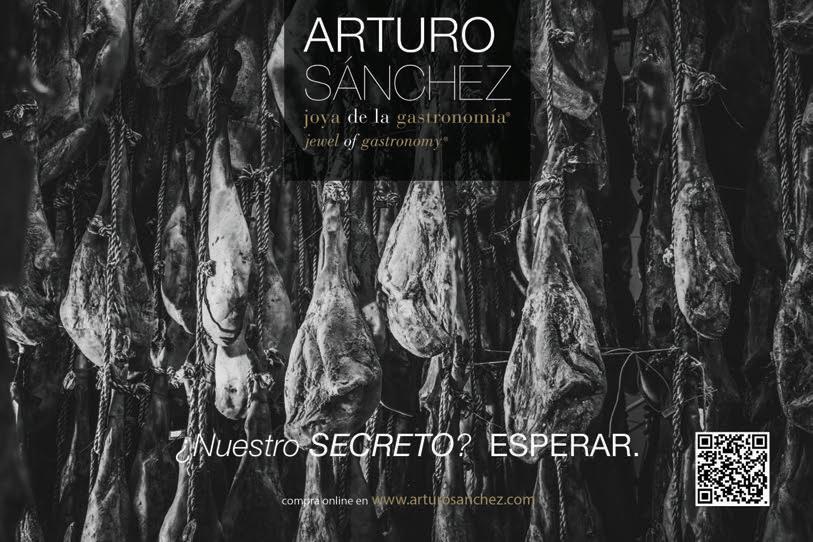

82






















 DE DERBY
DE DERBY












































 HOTEL CLARIS (PAU CLARIS, 150)
HOTEL CLARIS (PAU CLARIS, 150)






























































